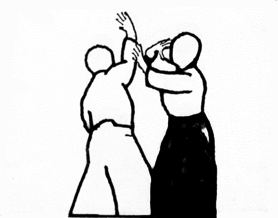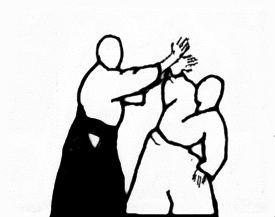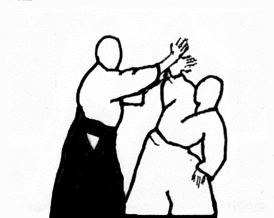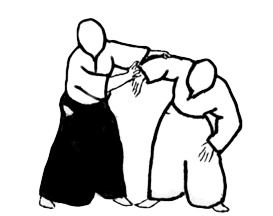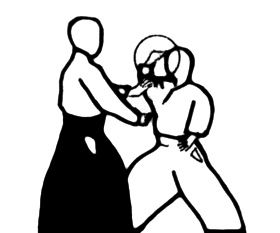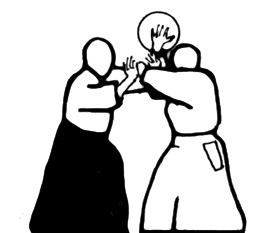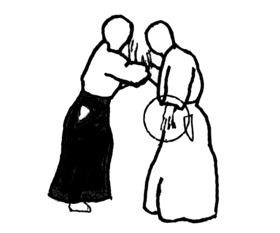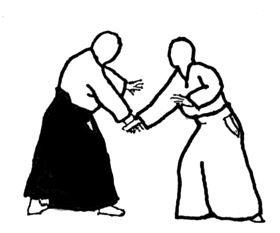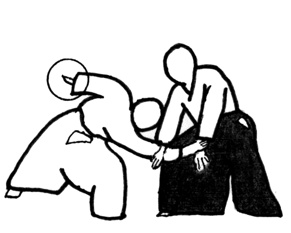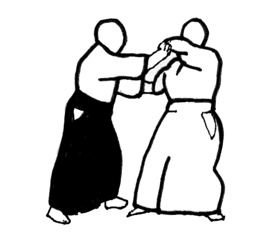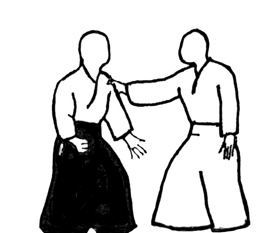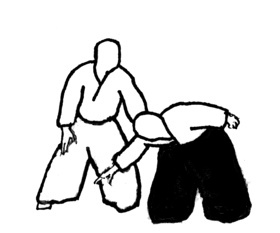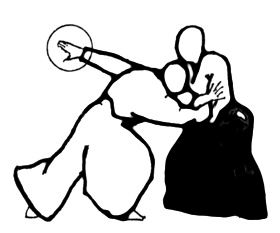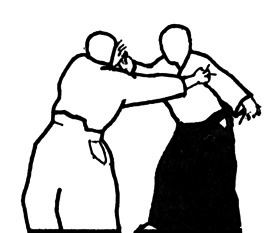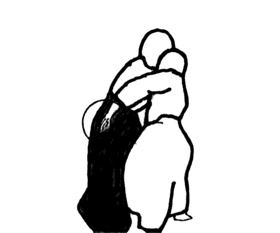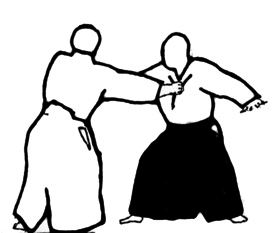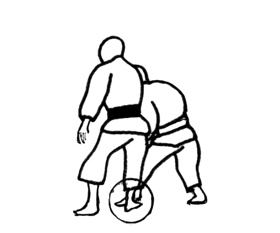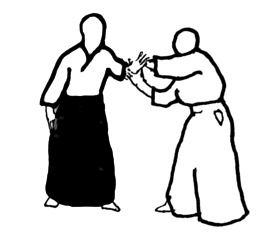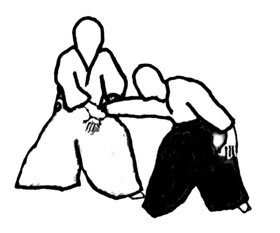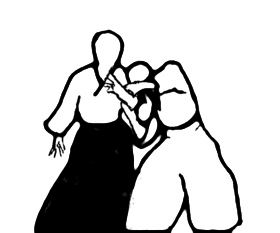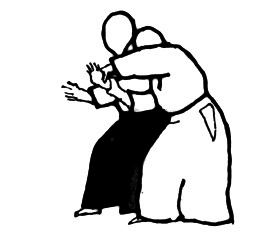This supplementary material is a supplement to my thesis “The Strength and the Concept of Aikido”. I will try to explain the detailed technical differences between Aikikai and Iwama style Aikido about thirty typical instances using a few illustrations.
- 15th Feb. 2003
- Rev. 31st May 2011
- Rev. 15th Sep. 2013
- Rev. 11th Nov. 2013
- Rev. 3rd Jan. 2014
- Rev. 1st Apr. 2014
- Rev. 25th Jan. 2016
7th dan
Iwama Aikido
1. Foreword
First I changed the abbreviation of "Aikikai Hombu Style Aikido" from "Hombu style" to "Aikikai style" now.
"Iwama style" still means Iwama Shinshion style Aikido or Iwama style Aikido and please confirm again that Shinshin means the expression of "We believe God" in Japanese, so "Iwama Shinshin Aikido" means "God Gifted Aikido".
I wrote of the features of Aikikai and Iwama style Aikido and compared them with each other in my thesis “The Strength and the Concept of Aikido”. Since then I have looked for the better method to emphasize the main points of my opinion and complement the content of my commentary. I have now come up with a way showing the detailed different points of each technique in concrete way by using a few illustrations.
Fortunately I have experienced both Aikikai and Iwama style as I made introductory remarks in my thesis. My practice periods is approximate 25 years consecutively for the both styles each. This means that I am familiar with the both styles to almost the same extent, although I am presently an exclusively an Iwama stylist.
Therefore the comparison of the techniques of the two styles depends solely on the basis of my own standard and real experience.(Refer to my thesis Chapt. 3)
The descriptions and illustrations in this and the following chapters are written using the following references:
Aikikai style :
❶ "Kihan Aikido (Kihon-hen)”-Japanese version-Kisshomaru and Moriteru Uyeshiba, 1997 Geijutsu Public Co.
❷“Kihan Aikido (Ouyou-hen)”-Japanese version-Kisshomaru and Moriteru Uyeshiba, 2001 Geijutsu Public Co.
❸“Best Aikido (The Fundamentals)”- English version-Kishomaru and Moriteru Uyeshiba 2004 Kodansha international Ltd.
❹“Shashin de Manabu Aikido (New version)”-Japanese version-Moriteru Uyeshiba, 1998 Baseball Magazine Co.
Iwama style :
①“Traditional Aikido (Sword, Stick, Body Arts) (Volume 2)”-Japanese and English version -Morihiro Saito, 1974 Minato Research Co.
②“Traditional Aikido (Sword, Stick, Body Arts) (Volume 3)”-Japanese and English version -Morihiro Saito, 1974 Minato Research Co.
③“Traditional Aikido (Sword, Stick, Body Arts) (Volume 5)”-Japanese and English version -Morihiro Saito, 1976 Minato Research Co.
④“Takemusu Aikido (Volume 1)”-Japanese and English version-Morihiro Saito, 1994 Aiki News Co.
⑤“Takemusu Aikido (Volume 2)”-Japanese and English version-Morihiro Saito, 1995 Aiki News Co.
⑥“Takemusu Aikido (Volume 3)”-Japanese and English version-Morihiro Saito, 1996 Aiki News Co.
⑦“Takemusu Aikido (Volume 4)”-Japanese and English version-Morihiro Saito,1997 Aiki News Co.
⑧“Takemusu Aikido (Volume 5)”-Japanese and English version-Morihiro Saito, 2001 Aiki News Co.
⑨“Takemusu aikido (Special Edition)”-Japanese and English version-Morihiro Saito, 1999 Aiki News Co.
⑩"Budo (Teachings of Founder of Aikido)” -English version-Morihei Ueshiba, 1991 Kodansha International
In the cases where the name of the same techniques is different between the both styles, I adopted the name of Aikikai style, not Iwama style; I hope Iwama stylists will overlook that.
The narrations related with quotation marks and in red italic letters (Budo) or (Oral ) in the explanations of the techniques of Iwama style in Chapter 2 "The Detailed Points of the Techniques" show O-sensei's words illustrated in his own book “Budo”or which he gave to Morihiro Sairo sensei at Iwama as Oral instruction.
I showed the reference number ( ①〜⑩ ) and the page number ( P◯◯ ) from which I quoted.
The book "Budo" was published in 1938 as a 200 limited edition and it has never been reprinted. Its English version was in print with the title "Budo —Teachings of the Founder of Aikido" in 1991 by Kodansha International ( the reference book ⑩, the translator John Stevens).
I would like to strongly recommend that you read this book at least once. Please refer to the ( Note ) at the end of this chapter about the contents of the book "Budo".
Because the book "Budo" was not seen in public again for about fifty years from its original publication in 1938, many Aikido leaders in the world never even knew of its existence. However at the beginning of 1980s, Mr. Stanley Pranin, ex-editor of Aiki News Co., found it in Iwama by chance and immediately showed it Morihiro Saito sensei.
This was the first time that Saito sensei learned of its existence and he said that he felt convinced that it was the only document that could validate his Aikido and that the founder had come to assist him in this validation.
Later the detailed explanation regarding the book "Budo" is discussed in the Introduction of the reference book ⑨ " Takemusu Aikido( Special Edition ) " by Mr. Pranin.
There are quite a few techniques in Iwama style which are the same as those illustrated in O-sensei's book "Budo". Some of the techniques are revised partly and while others are not exactly same. However, these techniques are almost never present the Aikikai style. The reason for this is that Aikikai style doesn't have Katai-keiko but only Ki-no-nagare while almost of all the techniques in "Budo" are Katai-keiko.
Well I will say again that I never deny "Ki-no-nagare" itself but I would like to advice we should progress to "Ki-no-nagare" after aquiring "Katai-keiko". ( Refer to my thesis Chapt. 4 and Chapt. 5 )
( Note )
The contents of the book "Budo
Part 1 Introduction by kisshomaru Ueshiba
Part 2 Budo by Morihei Ueshiba
1. Teaching of the path
2. Methods
3. Poems of the path
4. The essence of techniques
5. Illustration and explanation of selected techniques
(1) Precaution for training
(2) Basic movement
(3) Empty hand against empty hand
(4) Empty hand against sword (knife)
(5) Sword against sword
(6) Byonet Attacks
(7) Concluding exercise
6. The secrets of Budo ( Spiritual poems )
Part 3 Noma Dojo Techniques ( photographs )
2. The Detailed Different Points of the Techniques
When I tried picking up the detailed technical differences between the two styles, I counted up more than eighty items. However I finally selected only the thirty of items .
Actually I am sure that there must be much more detailed technical differences that I am unable to pick out but am unable to do so because I am not very skilled. In conclusion, I can say that there are innumerable different points between the techniques of the two styles.
However, I can say that the selected items at the same time symbolize of the whole techniques of the two styles.
Well this term starts with the classification of the thirty items that I picked up from the respective books according to the eleven categories of techniques.
That is as follows :
① Common
Ⅰ. The Concept of All Shomen-uchi
| ( Aikikai style ) | ( Iwama style ) |
|---|---|
( Omote )
|
|
( Ura )
|
|
In both Omote and Ura techniques, Uke delivers a Shomen-uchi with his hand- sword first and Tori controls Uke's arm. When Uke is strong and strikes with a deadly stroke, Tori cannot receive and control it. This is especially impossible in Omote technique. Is there any cooperation between Uke and Tori unconsciously?
Ura technique will be effective when it is quite timely. ( Ki-no-nagare ) |
In both Omote and Ura techniques Tori strikes first at the moment he feels the sign of Uke's attack. "It is essential to strike in advance forcefully. (using both hands and both feet in coordination.) (Budo)" ( ④—P42, ⑨—P42, ⑩—P41 ) If Tori was struck by Uke beforehand, Tori cannot help but receive it with Ura technique. In Iwama style all techniques are constructed under the precondition that Uke is always strong and something of a martial artist. ( Ki-no-nagare and Katai-keiko ) |
Ⅱ. How to Strike in All Yokomen-uchi
| ( Aikikai style ) | ( Iwama style ) |
|---|---|
|
|
Uke steps to the side of Tori on his rear foot and delivers a Yokomen-uchi with his diagonal Tegatana. In this moment the strike with the diagonal Tegatana from the side of Tori has less power than the vertical and straight Tegatana does. ( Ki-no-nagare ) |
Uke steps forward ( not sideward ) on his rear foot and delivers a real Yokomen-uchi with his vertical straight Tegatana. The strike with the straight Tegatana is equal to Yokomen-strike of Sword itself and it has a big power. "Step forward on your right foot and deliver a Yokomen-uchi with your right Tegatana against the side-head of your oppont. (Budo)" ( ④—P46,⑤—P21, ⑩—P46 ) (Katai-keiko and Ki-no-nagare) |
Ⅲ. How to Receive All Yokomen-uchi Strikes ( Tenshin )
| ( Aikikai style ) | ( Iwama style ) |
|---|---|
|
|
Tori steps in on his foot and pivots around while cutting down Uke's Yokomen-uchi strike. ( Using Atemi with his other hand ) At this moment there is a possibility being counterattacked with Uke's other hand against Tori’s side. ( Maai (mutual stance) is very close. ) This is a rather formal way of receiving an attack and not a martial arts way. ( Ki-no-nagare ) | Tori steps back and changes into the opposite Hanmi while cutting Uke's Yokomen-uchi strike down very low and parrying it rapidly. ( Using Atemi with his other hand ) This moment Tori is in no danger since he has unbalances Uke ( Maai is far enough. ) "You must become feeling that cut down Uke very low to the floor.(Oral)" ( ⑤ — P25 ) It is rather unreasonable to perform Osae-waza (pinning techniques) from this parrying situation but this is fine for Nage-waza (throwing techniques). ( Katai-keiko and Ki-no-nagare ) |
( Note ) Refer to Item ③—Ⅴ ( How to enter at Yokomen-uchi Ikkyo〜Yonkyo( Tenshin ) ).
Ⅳ. How to Make Uke Unbalance at All Katate-dori
| ( Aikikai style ) | ( Iwama style ) |
|---|---|
|
|
Tori changes his step applying Atemi and cuts Uke's elbow down at the front of Uke with his Tegatana. At this moment there is a possibility that Tori cannot cut his elbow down if Uke is strong and Tori be counterattacked with Uke's other hand. ( Ki-no-nagare ) | Tori makes unbalances Uke sideward enough applying Atemi. At this moment, Tori doesn’t need to cut Uke's elbow down and Uke cannot reach Tori with his other hand. When you were grabbed you must make your partner unbalanced sideward with Atemi in Aikido. This principle should apply to all Katate-dori, Sodeguchi-dori, Sode-dori and Kata (Mune)-dori techniques. ( Katai-keiko and Ki-no-nagare ) |
( Note ) This Aikikai style form of the technique is the old form of O-sensei in pre-war time. After then O-sensei himself changed it into the form above in Iwama style in post-war time at Iwama.
Ⅴ.How to grab Uke's shoulder in all Kata-dori
| ( Aikikai style ) | ( Iwama style ) |
|---|---|
|
|
It is only a conventional grabbing that Uke isn't conscious of the possibility of Tori's counterattacking ( Thrust, Punch and Kick ). This grabbing is not enough as a martial art one. ( Ki-no-nagare ) | Uke contorols Tori's maneuver taking hold of the top of his shoulder. In this way Uke can defend against Tori's thrust with his other hand or his kick with his foot. This is a maratial art method of grabbing. We should unbalance Uke even from this type of grabbing. ( Refer to the next Item ① — Ⅵ )( Katai-keiko ) |
Ⅵ. How to unbalance Uke in all Kata-dori
| ( Aikikai style ) | ( Iwama style ) |
|---|---|
|
|
As the same as “How to unbalance Uke in all Katate-dori", there is a possibility that Tori will be counterattacked by Uke's other hand. Besides since Tori doesn't pull his own shoulder rearward enough, he may have trouble pushing back Uke's arm with only the force of his hand. Is there any cooperation between Uke and tori unconsciously? ( Ki-no-nagare ) | Tori makes unbalances Uke sideward enough by applying Atemi so there is no danger of counterattack. Besides since Tori pulls his own shoulder rearward enough, he can push back Uke's arm with the force of his hand, shoulder and hips working together. ( Katai-keiko and Ki-no-nagare ) |
(Note) This Aikikai style technique is also the old form O-sensei's in pre-war time.
Ⅶ. How to Make Uke Unbalance at All Mune-dori
| ( Aikikai style ) | ( Iwama style ) |
|---|---|
|
|
Tori changes his step applying Atemi and cuts down Uke's elbow and applies the pinning techniques. At this moment there is a possibility that Tori will be counterattacked by Uke's other hand as “Katate-dori” and “Kata-dori”. Is there any cooperation between Uke and Tori unconsciously? ( Ki-no-nagare ) | Tori makes unbalances Uke sideward enough by applying Atemi so there is no danger of counterattack. ( Katai-keiko and Ki-no-nagare ) |
(Note) This Aikikai style technique is also the old form O-sensei's in pre-war time.
② Tai-no-tenkan and Kokyu-ho
Ⅰ. How to enter and the purpose of Tai-no-tenkan
| ( Aikikai style ) | ( Iwama style ) |
|---|---|
|
|
When Tori steps toward on his foot at Uke's side the position of Tori's foot is not accurate ( It is not pointed to Uke’s toe) so sometimes Tori needs extra power for his body's turning with his grabbed hand. Tori and Uke continue their turning each other without stopping every time resulting in the purpose of Tai-no-tenkan being only the exercise of body movements. ( Ki-no-nagare ) | Bring Tori's toe to Uke's toe precisely and turn in a circular movement. This position is the best for this body movement. "Align your toe of your left foot with the toe of your partner's right foot. (Oral)" ( ④ — P45 ) After every pivoting Tori extends his breath power (Ki-power) and keeps this posture for several seconds. This result in the purpose of Tai-no-tenkan being the exercise not only the body movement but allows Tori to relax and pour out his breath power (Ki power), besides to train his hips to become very stable regardless of whether Uke pushes or pulls. "After turning your body you must keep your Hanmi stance and your posture stably. (Budo)" ( ⑨ — P41, ⑩ — P41 ) ( Katai-keiko and Ki-no-nagare ) |
Ⅱ. How to grab with both hands in Standing Kokyu-ho
| ( Aikikai style ) | ( Iwama style ) |
|---|---|
|
|
Uke cuts Tori's arm down and then grabs it with his both hands. It is just a conventional grabbing that Uke isn't conscious of Tori's counterattack. This grabbing is not enough as a martial arts form of grabbing. ( Ki-no-nagare ) |
Uke cuts Tori's arm down and then grabs it with his both hands thinking of Tori's arm is Ken (Sword). This is a martial art approach to grabbing so that Uke can maneuver himself to avoid Tori's counterattack. (Katai-keiko) |
Ⅲ. The form of Standing Kokyu-ho ( ura )
| ( Aikikai style ) | ( Iwama style ) |
|---|---|
|
|
Tori steps to Uke's side with his foot using his hand-sword to guide Uke up. Then Tori takes a big step with his inner foot behind Uke and cuts Uke down. At this moment because there is no the supporting foot of the turning of his body, there is a possibility that Tori strains against strong Ukes. Is there any cooperation between Uke and Tori unconsciously? ( Ki-no-nagare ) |
Tori steps to Uke's side with his foot using his hand-sword to guide Uke up with feeling of lowering his shoulders, elbows, and hips down. (no open outer foot) And Tori rotates his hips to change Hanmi looking in the complete same direction as Uke. Furthermore Tori enters behind Uke with his inner foot and cuts Uke down leaving his outer foot as the supporting foot of the turning. In the case when Tori doesn't leave this outer foot, he must change into other kinds of techniques ( not Kokyu-ho ). (Katai-keiko) |
(Note) In Iwama style there is not the form equivalent to the Standing Kokyu-ho (Omote) form of Aikikai style.
③ Pin Techniques
Ⅰ. How to enter all Ura-waza (Turning Techniques) through Ikkyo to Yonkyo
( Aikikai style )
( Iwama style )
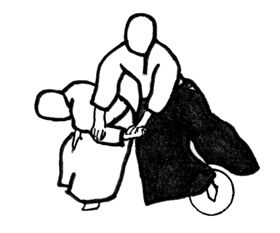
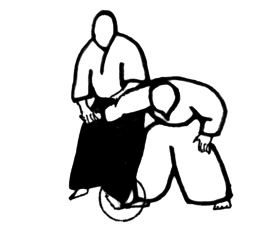
Tori steps forward on his foot at Uke's side and makes a big pivot while cutting down on Uke's arm.
At this moment the stepping position of Tori's foot is not specified, so sometimes, e.g. Uke's very strong grabbing, Tori needs some extra power to cut down on Uke's arm.
( Ki-no-nagare )
Tori steps forward, his toe to Uke's toe precisely and makes a big pivot while cutting down on Uke's arm.
This form is the most effective and there is no strain to cut down on Uke's arm.
"Align your toe of your left foot with the toe of your partner's right foot. (Oral)" ( ④ — P45)
"Bring Uke's arm down with a feeling of circular pushing and turning. Don't merely twist your partner's arm. (Oral)”
( ④ — P45 )
( Katai-keiko and Ki-no-nagare )
Ⅱ. How to Pin at All through Ikkyo to Yonkyo( Omote )
( Aikikai style )
( Iwama style )
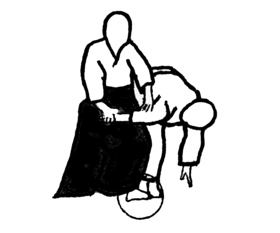
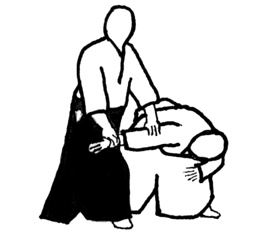
Deflecting Uke's attack with his both hand-swords Tori takes a big step in his inner foot cutting Uke's arm down.
At this moment there is a possibility that Tori can be repelled by a strong Uke because he steps in his inner foot with his both hands together.
Besides since Tori tries to cut Uke's arm down vertically there is a possibility that Uke rises himself moving his hip to Tori's side.
Furthermore at the last phase Tori steps forward widely his outer foot and brings Uke to the ground with Uke's arm to be more than right angle.
At this moment there is a possibility that Uke may be able to neutralize (no power) his arm by bending his elbow down in a relaxed manner and freeing himself.
( Ki-no-nagare )
Deflecting Uke's attack with his both hand-swords (without moving his inner foot ) Tori brings Uke's arm down in lateral ( not vertically ) in front of his abdomen by twisting his hips.
Uke cannot repel and move any more. After this Tori takes a big step diagonally forward with his inner foot making Uke unbalance.
At the last phase Tori brings Uke to the ground with Uke's arm to be a right angle ( 90 degrees ) against Uke's body.
“After breaking your opponent balance, step in with your inner foot with the feeling of pushing your opponent away. (Oral)"
( ④ — P42, ⑨ — P47, ⑩ — P41)
“It is essential that Uke's arm to be a right angle against his body. (Budo)” ( ④ — P42, ⑨ — P47, ⑩ — P41)
( Katai-keiko and Ki-no-nagare )
Ⅲ. How to Pass from One Hand to the Another at All Sankyo (Yonkyo) Tecniques
( Aikikai style )
( Iwama style )
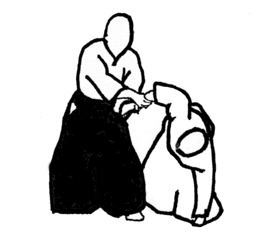
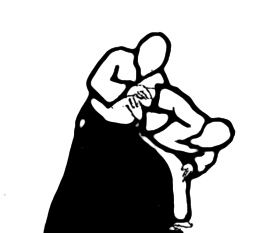
After Tori cut down Uke's arm with his hand-sword ( At this moment his inner foot already stepped forward ), he changes his grabbing against Uke's wrist with his other hand from Ikkyo to Sankyo lock.
At this moment there is a possibility that strong Uke may make his hand disengage by pulling and turning it over quickly. (Omote)
Ura is the same as Omote.
( Ki-no-nagare )
After Tori cut down Uke's arm with his hand-sword, he then takes a step diagonally with his inner foot making Uke unbalance.
Tori then immobilizes Uke's hand at his chest and changes his grabbing with his other hand to Sankyo.
Uke cannot make his hand disengage because he is off balance and his hand is placed rigidly at Tori's chest. (Omote)
Ura is the same as Omote.
“When applying Sankyo you must always stand next to your opponent and lock his hand at your chest. (oral)”( ④ —P120)
( Katai-keiko and Ki-no-nagare )
Ⅳ. How to Lock at All Sankyo ( Yonkyo ) ( Ura technique )
( Aikikai style )
( Iwama style )
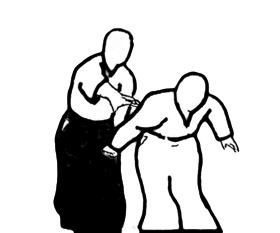
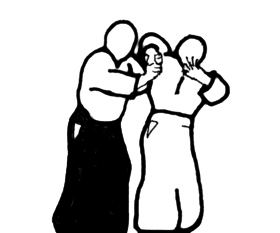
After Tori grabs Uke's wrist in the Sankyo lock with his hand, he sweeps back Uke's arm back around and presses it down.
There is no rising of Tori's arm and applying Sankyo pressure.
Yonkyo is almost same as Sankyo.
( Ki-no-nagare )
After Tori grabs Uke's wrist by Sankyo lock with his hand immobilizing it against his chest, he raises Uke's arm twisting his hips applying Sankyo pressure.
Then Tori sweeps back Uke's back arm around and presses it down.
Apply Yonkyo Lock after twisting and raising your opponent's arm as same as Sankyo Lock.
"Grab your opponent's right fingers, and twist to the right with a slight turn up. (Budo)" ( ④ — P132, ⑨ — P63, ⑩ — P45)
( Katai-keiko and Ki-no-nagare )
Ⅴ. How to enter at Yokomen-uchi Ikkyo 〜 Yonkyo ( Tenshin )
( Aikikai style )
( Iwama style )
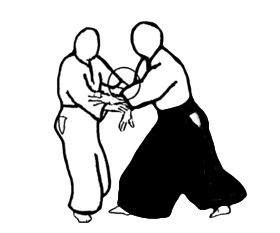
There are no techniques like this form in Iwama style. In Iwama style Tori steps forward diagonally and enters Ikkyo ~ Yonkyo like as the below illustration.
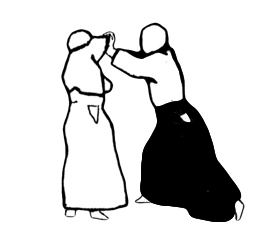

Tori changes his step receiving Uke's Yokomen-uchi and grabs Uke's wrist with his hand and cuts back Uke's arm down with his other hand-sword (Tegatana).
There is a possibility that Tori won't be able to cut back Uke's arm down against a strong Uke. Besides Tori there is a possibility that Tori will be counterattacked by Uke's other hand.
This form (Tenshin) is unreasonable to enter all pin techniques basically.
Is there any cooperation between Uke and Tori unconsciously?
( Ki-no-nagare )
Tori steps forward diagonally and receives Uke's attack (Irimi), grabs Uke's wrist and elbow, then enter the pinning techniques.
"Step forward on your left foot, and use your left Tegatana to neutralize your opponent's attack, simultaneously striking his face. (Budo)" ( ④ — P46, ⑤ — P21, ⑩ — P47)
When Tori receives Uke's Yokomen-uchi in front of him (Tenshin), it is essential that Tori should parry it rapidly without stopping Uke's attack or without being grabbed.
This principle should apply to all Shomen-uchi, Yokomen-uchi, Katate-dori and Kata (Mune)-dori techniques.
( Katai-keiko and Ki-no-nagare )
(Note) Refer to Item ①—Ⅲ ( How to receive all Yokomen-uchi (Tenshin) ).
④ Shiho-nage
Ⅰ.The form opf All Shiho-nage
( Aikikai style )
( Iwama style )
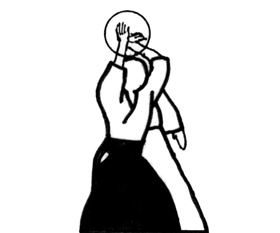
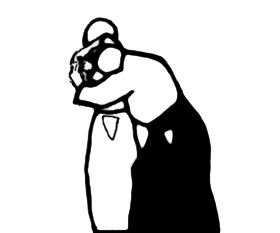
Aikikai organization admits that Shiho-nage was derived from the Ken but they don`t practice Buki-waza practically.
Therefore their form of Shiho-nage is follows :
(1) grab Uke's wrist formally
(2) step forward deeply straight
(3) lift both hands high above the head
(4) rotate hips 180 degrees by just turning
(5) cut down over the head
(6) pin Uke at the upper side of his head
There are some problems about the nationale and the sharpness of technique.
Therefore there is some strain especially around Uke's wrist sometimes.
( Ki-no-nagare )
The form of Ken's cut up of Buki-waza itself is applied in the form of Shiho-nage. Therefore their form of Shiho-nage is follows :
(1) grab Uke's wrist placing the thumb to Uke's pulse
(2) step round and rather near
(3) keep to Tori's forehead with the both hands
(4) rotate sharp by twisting hips
(5) cut down from the forehead
(6) pin Uke at the rear side of his back
This the typical technique realized the common principle of Ken and Body techniques. Therefore no strain and safe.
"It is necessary to think your opponent's right arm as a striking sword. Also, your right thumb should be on his pulse.(Budo)" (⑤—P29, ⑨—P73, ⑩—P47)
“Rotate to your forehead with the both hands until Uke goes unbalance. (Budo)” (⑤—P16)
( Katai-keiko and Ki-no-nagare )
( Note ) Tobi-ukemi ( the jumping Ukemi ) is almost not used in the real encounter but only at demonstrations.
Ⅱ. How to Enter at all Shiho-nage ( Omote, Ura )
( Aikikai style )
( Iwama style )
( Omote )
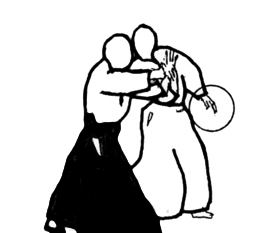
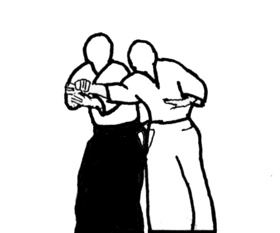
Tori takes a big step to the left forward ( It means in front of Uke. ) with his inner foot and raises his Tegatana in a spiral motion.
This moment there is a possibility that Tori will be counterattacked by Uke's other hand.
( Ki-no-nagare )
Tori takes a step keeping the right angle direction against Uke to the his side, then steps through his inner foot while raising his Tegatana in a spiral motion.
It is not necessary for Tori to use extra martial power since it is the rational direction and it is safe against the possibility of Uke's counterattack.
"Enter from the side of yourpartner not from the front of him. (Oral)" (⑤ — P16)
( Katai-keiko and Ki-no-nagare )
( Note ) This Aikikai style form of the technique is the old form of O-sensei in pre-war time.
After then O-sensei himself changed it into the form above in Iwama style in post-war time at Iwama.
( Ura )
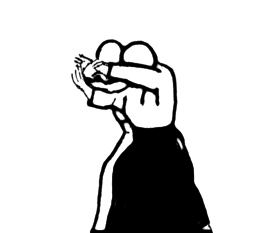
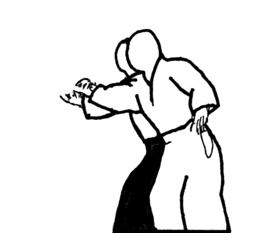
Stepping to Uke's side Tori pivots on his both feet and raises and cuts down with his both hands entering Shiho-nage.
At this moment there is a possibility that Uke has not been unbalance enough so Tori may not be able to complete the technique if Uke pulls his hand with his strong power.
( Ki-no-nagare )
Aligning his toe with the toe of Uke, Tori pivots on his both feet as though sweeping away to the rear just like the form of cutting to the rear with the Ken's in Buki-waza.
Tori then raises his hands and cuts down with his both hands entering into Shiho-nage.
"Align your toe of your left foot with the toe of your partner's right foot. (Oral)"
(④—P45)
"While grabbing your partner's wrist ( pulse ), turn as though sweeping away to the rear with your Tegatana. (Oral)"
(⑤—P31)
( Katai-keiko and Ki-no-nagare )
⑤ Kote-gaeshi
Ⅰ. How to Turn Uke's Wrist Over at All Kote-gaeshi
( Aikikai style )
( Iwama style )
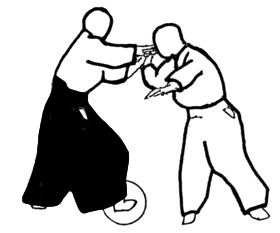
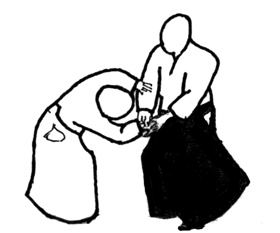
Tori grabs Uke's hand from above with his hand stepping off the line of the attack. Tori then turns Uke's wrist over outward with his both hands changing his step with his both feet and cuts down ( the point of the hands is high ).
This moment when Tori applies Kote–gaeshi by twisting Uke's wrist, there is a possibility that he may not be able to achieve Kote-gaeshi against a strong Uke
having big arms.
If Uke is a beginner and does not have good enough at Ukemi, there is a possibility that Uke might strain around his wrist.
( Ki-no-nagare )
Tori grabs Uke's hand from above with his hand stepping off the line of the attack. Then Tori turns Uke's wrist over with his both hands stepping very widely to the side of Uke with his front foot ( not change the step ) and cuts down ( the point of the hands is low ).
Since Tori turns Uke's wrist over to the real rear of Uke, Uke cannot resist.
This is safe for even the beginner (Uke) who is not good at Ukemi.
Refer to the next Item ⑤—Ⅱ.
( Katai-keiko and Ki-no-nagare )
( Note ) Tobi-ukemi ( the jumping Ukemi ) is almost not used in the real encounter but only at demonstrations.
Ⅱ. The Form of the Basic Technique of Katate-dori Kote-gaeshi
( Aikikai style )
( Iwama style )
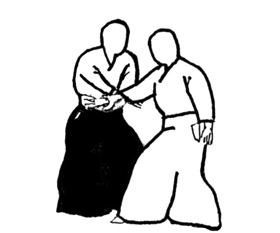
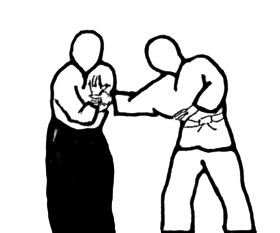
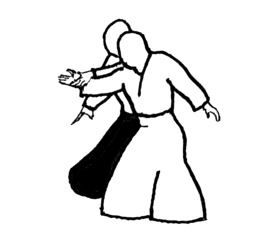
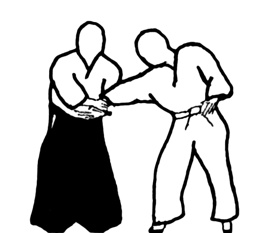
While cutting down ( or up ) with his hand-sword to break Uke's hold, Tori grabs Uke's wrist from upper with his other hand.
At this moment if Uke pulls his own hand quickly, Tori cannot grab it.
This technique can be applied only in Ki-no-nagare (Flowing practice). Therefore Tori might have a sense of anxiety or be concerned as to whether he can grab Uke's wrist or not.
( Ki-no-nagare )
There are two forms of the basic techniques in Katai-keiko as follows :
One is that Tori grabs Uke's thumb from below with his other hand crossing both hands and release from Uke's grip (the upper illustration).
The other is that Tori grabs Uke's wrist in the same manner as Katate-dori Shiho-nage (ura) and release Uke's grip (the lower illustration).
( Ki-no-nagare )
In Ki-no-nagare of Iwama style, the form is similar as Hombu style ( Refer to the previous Item ⑤ —Ⅰ ) . However there is no anxiety or concern as to whether he can grab Uke's wrist or not.
( Katai-keiko )
⑥. Irimi-nage
Ⅰ.How to throw at all Irimi-nage
( Aikikai style )
( Iwama style )


Tori enters the rear of Uke and reaches for Uke's neck with his hand and pivots on his foot and breaks Uke's balance. Then at the moment Uke is attempting to rise, Tori guides Uke toward his shoulder and cuts Uke down stepping forward on his foot.
In this form there is a dangerous possibility that when Tori presses against Uke's neck with his hand, Uke may strike to Tori's legs strongly or may grab Tori around the body with his arms thus changing his posture unbalancing Tori.
Besides there is also a possibility that Tori may not be able to push Uke's neck down if Uke is very strong or not to enter into Irimi-nage if Uke doesn't attempt to rise but to separate from Tori.
Is there any cooperation between Uke and Tori unconsciously?
Furthermore since Tori must throw Uke and waits for Uke's to rise, there is a problem whether Tori can throw Uke freely in any direction which he chooses.
( Ki-no-nagare )
Tori enters to the rear of Uke changing his body direction (exactly the same direction as Uke's) and cuts Uke's hand down to the right (left) below with his right (left) hand.
"Cut your opponent's right hand down to the right below with your right Tegatana (Budo)."
( ⑤ — P125, ⑨ — P66, ⑩ — P46)
Tori draws Uke’s back collar toward his chest to unbalance Uke then Tori steps toward with his foot and cuts Uke down.
"Take your opponent's back collar with your left hand and hold it toward your chest. Throw Uke down by advancing with your right foot while pushing his neck down with inside of your right elbow. You must put power with fingertips and turn your arm inward (Budo)."
( ⑤ — P125, ⑨ — P37, ⑩ — P47)
Tori does not need to pivot after entering and since he can make unbalance Uke momentarily, Uke cannot attempt to resist or separate.
In Ki-no-nagare after entering Tori turns his foot in a circular motion holding Uke's back collar to his chest then Tori can throw Uke to any direction he wants.
( Katai-keiko and Ki-no-nagare )
(Note) This Aikikai style form of the technique was devised by Koichi Tohei sensei, ex-Head of the Aikikai's teaching staff, in 1950s. When Tori pushes Uke's neck down it is the most suitable to apply Kubi-nage (Neck-throwing).
Ⅱ. How to enter at Tsuki Irimi-nage
( Aikikai style )
( Iwama style )
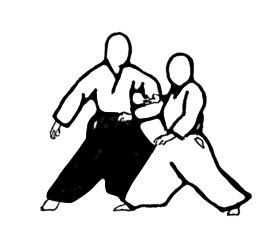
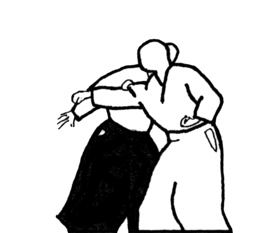
Tori enters to the side of Uke (Tori doesn't rotate his body direction. ) and takes one more big step forward with his feet and cuts Uke down with his arm to effect the throw.
This technique is effective in only the case where Tori and Uke pass each other momentarily.
Otherwise there is a dangerous possibility that Uke may stop his Tsuki momentarily and try to elbow Tori's body or grab Tori around the body with his arms.
( Ki-no-nagare )
Tori enters to the side of Uke changing his body direction ( the same direction as Uke's ) and grabs Uke with the back shoulder with his hand and bends it a little.
Then Tori throws Uke with his arm bringing his grip slightly below his armpit.
Uke can neither try to elbow Tori's body nor grab Tori around the body.
( Ki-no-nagare )
( Note ) This Hombu style form of the technique is the old form of O-sensei in pre-war time. After then O-sensei himself changed it into the form above in Iwama style in post-war time at Iwama.
( Note ) This Aikikai style form of the technique is the old form of O-sensei in pre-war time.
After then O-sensei himself changed it into the form above in Iwama style in post-war time at Iwama.
⑦ Kaiten-nage
Ⅰ. How to throw at All Kaiten-nage
( Aikikai style )
( Iwama style )

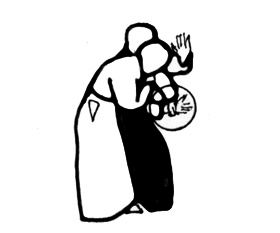
During this technique Tori takes a big step back with his foot while cutting Uke's hand down deeply with his Tegatana, then Uke lower his head voluntarily.
At this moment Uke can leave his head where it is, not to lower it, letting his Tori hand off or just walk away.
Furthermore it is not practical in that Tori does not hold down Uke's back of the neck.
Is there any cooperation between Uke and Tori unconsciously?
( Ki-no-nagare )
During this technique Tori takes a step back with his foot while cutting down Uke's hand with his Tegatana circularly and pushingly.
Uke cannot let his hand off, so he cannot help lowering his head down unvoluntarily.
And then it is basic that Tori hold down Uke's back of the head.
"Enter as though drawing a triangle with your feet. (Oral)"
(⑥—P23)
( Katai-keiko and Ki-no-nagare )
⑧ Koshi-nage
Ⅰ. How to throw at All Koshi-nage
( Aikikai style )
( Iwama style )
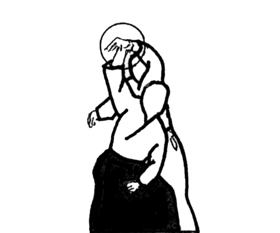
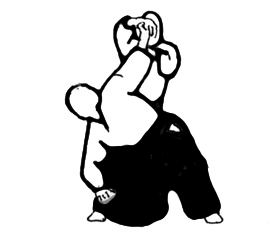
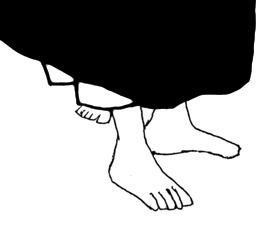
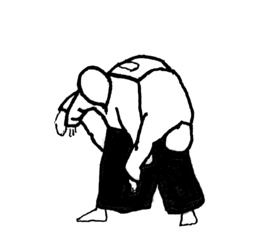
Tori steps forward to a position between middle of Uke's feet with his inner foot and lowers his hips. Tori then extends his arm upward and throws Uke drawing his outer foot to his inner foot (the lower illustration).
In this form there is a possibility that Uke's body comes on Tori's upper back not on his hips because it is not clear where he should extend his arm to. It is not precise.
Besides after throwing Tori faces to Uke since he draws his outer foot to his inner foot. It means that Tori shows his back against the second attacker.
( Ki-no-nagare )
Tori steps forward to the center position in the middle of Uke's feet with his inner foot forming the letter “T”, lowers his hips then Tori extends his arm diagonally upward with the feeling of pointing at the top corner of the wall.
Thus Uke's body comes on Tori's hips in such a way that the two bodies form a cross. Tori looks downward to throw Uke without drawing his outer foot. This allows Tori to promptly confront a second attacker.
"Step forward and position your right foot in the center of your opponent`s feet.
Extend your left arm diagonally upward with the feeling of pointing at the top corner of the wall and bring your opponent's body onto your hips in such a way that the two bodies form a cross.(Oral)"
( ⑥ — P33 )
( Katai-keiko and Ki-no-nagare )
⑨ Kokyu-nage
Ⅰ. How to Enter at Ryote-dori Kokyu-nage
( Aikikai style )
( Iwama style )
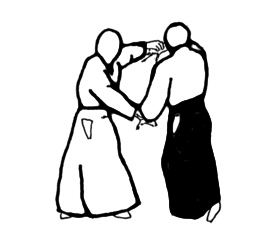
There is no this form in Iwama style.
Tori steps forward in front of Uke and swings his Tegatana up. Tori then changes the direction of his body and throws Uke.
At this moment there is a possibility that Tori will receive Uke's counter-attack with Uke's lower hand releasing itself or counter kick using foot or using both of his arms to grab Tori’s body.
( Ki-no-nagare )
Ⅱ.How to unbalance in Ryote-dori Tench-nage
( Aikikai style )
( Iwama style )
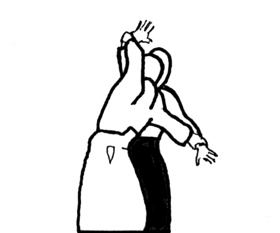
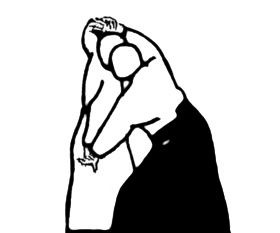
When Tori enters to the side of Uke, he raises his Tegatana up and thrust his other Tegatana down toward earth.
At this moment Uke can take his lower grasp off voluntarily and make the technique ineffective.
Is there any cooperation between Uke and Tori unconsciously?
( Ki-no-nagare )
When Tori enters to the side of Uke, he raises his Tegatana up and extends his other Tegatana behind Uke pushing so that Uke's grasp cannot be removed.
( Katai-keiko and Ki-no-nagare )
⑩ Buki-dori ( Weapon-taking )
Ⅰ. How to Attack at All Buki-dori
( Aikikai style )
( Iwama style )
Tanto-dori (Knife-taking)
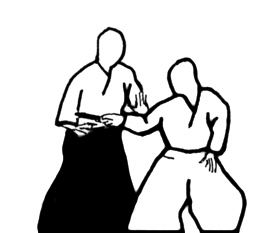

Jo-dori (Stick-taking)
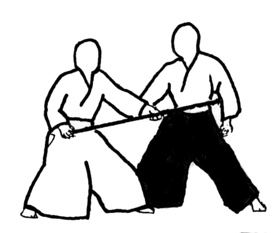
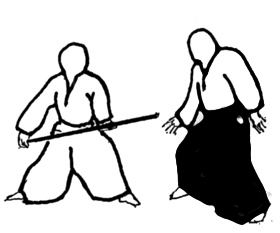
Tachi-dori (Sword-taking)


In Aikikai style there is no practice of Buki-waza ( Weapons techniques ), so the weapons attacks are apt to become amateurish formally and not practical.
In Iwama style there is practical Buki-waza ( Weapons techniques —Sword and Stick ) and they are harmoniously unified with Taijutsu ( Body techniques) .
The weapons attacks are really practical and severe and not half done.
(Note) You readers perhaps cannot distinguish the different point of Weapons Attacks in detail on the illustrations, however you will be able to understand that the differences derive from whether Weapons techniques exist or not.
Ⅱ. How to Enter at Jo-dori ( Shiho-nage )
( Aikikai style )
( Iwama style )
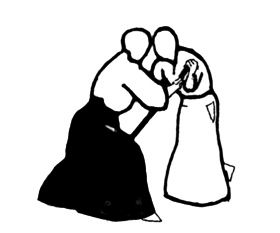
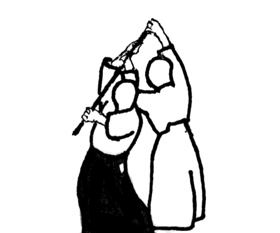
From Ai-hanmi (facing right-right or left-left) Tori grabs with Jo with his both hands and thrusts the end of Jo out to the front of Uke. Tori then steps forward with his rear foot and raises Jo, rotates his hips and cuts Jo down to throw Uke.
( Shiho-nage Omote )
During this technique there is a moment that Tori faces to Uke's face each other, therefore there is a possibility that Tori cannot swing up against a strong Uke or may receive Uke's counterattack with his hand voluntarily releasing the grip of the Jo.
From Gyaku-hanmi (facing right-left or left-right) Tori grabs Jo with his both hands and thrusts the end of Jo out to the front of Uke diagonally. Tori then turns his hips 180 degrees in the same manner as Shiho-nage Ura and cuts Jo down to throw Uke.
There is no chance Tori and Uke facing each other so it is safe and rational.
The application of the form of Shiho-nage ( Omote ) is effective in only Jo-nage ( Jo-sabaki ) not Jo-dori.
Ⅲ. How to Throw at Jo-dori ( Irimi-nage )
( Aikikai style )
( Iwama style )
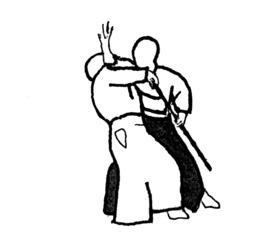
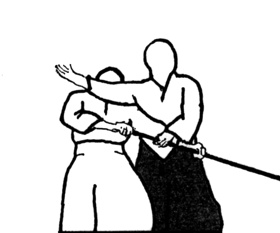
During this technique Tori holds Jo with left hand and swings his right Tegatana up and cuts Uke's throat down.
Since Tori's left hand places outside of Uke's left hand and he is facing Uke, the technique won't be executed sharply and powerfully.
This form should be classified as Kokyu-nage.
During this technique Tori holds Jo at with his left hand and cuts Uke's throat away with his right hand.
Since Tori's left hand places inside of Uke's left hand and he doesn't face Uke, the technique will be executed sharply and powerfully.
Ⅳ. The Form of Jo-dori ( Kote-gaeshi )>
( Aikikai style )
( Iwama style )
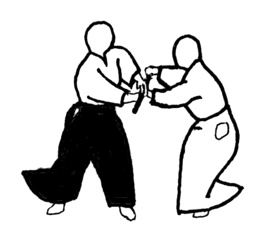

Tori grabs Uke's hand from above and turns Uke's wrist over outward with Jo together.
There is a possibility that Tori cannot turn Uke's wrist over outward because Uke is grabbing Jo with his both hands tightly.
Is there any cooperation between Uke and Tori unconsciously?
Tori grabs the near end of Jo from above with his right hand and turns it over in a large motion holding it at the middle with his left hand.
Then Tori steps largely forward with his left foot and throws Uke.
This technique is classified as Kokyu-nage.
Ⅴ. How to Throw at Tachi-dori (Kokyu-nage )
( Aikikai style )
( Iwama style )
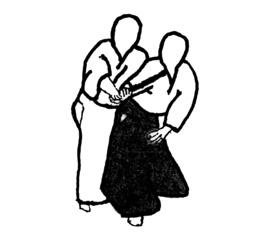
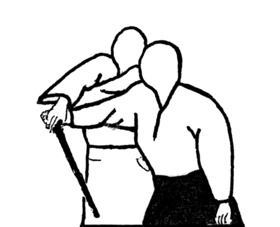
During this technique Tori grabs the hilt of Ken (Tachi) with his right hand. Tori then pivots to the side of Uke on his right foot and swings his right hand up and down to throw Uke.
The technique won't be executed sharply and powerfully because Tori doesn't enough control Uke's elbow joint.
During this technique Tori grabs the hilt of Ken (Tachi) with his right hand. Tori then places his right elbow under Uke's left elbow to apply pressure against Uke's elbow joint.
The technique will be execute sharply and powerfully because Tori enough controls Uke's elbow joint.
At the end of this chapter I am very regtrettable that Aikikai Aikido have not any systematic Weapon techniques that O-sensei embodied himself on his seventies at Iwama and I cannot compare between those of the two styles.
They are all the Weapon taking or those applications that Aikikai people call the Weapon techniques in their pratices and fall under the Body techniques.
3. Summary
The first commentary of the concrete comparison between Aikikai and Iwama style techniques deals with the rationale of the detailed forms of their techniques. We can’t help but draw the conclusion that there are considerable differences regarding their rationale and sharpness. Although the techniques in Aikikai style are still generally rational in Ki-no-nagare, the detailed parts are rather rough and not precise, while every technique in Iwama style can be explained rationally to the full extent.
The cause for these differences is that Aikikai style only has "Ki-no-nagare (Flowing practice)" while Iwama style has both "Katai-keiko (Solid practice)" and "Ki-no-nagare".
( Refer to my thesis Chapt 4 )
As a matter of fact, many amateurs maybe cannot distinguish the differences between Aikikai and Iwama styles techniques in Ki-no-nagare because they look like almost the same movements. However, once an actual encounter takes place, I believe that the detailed forms of self-defence techniques must become the keystone on which to depend.
( Refer to Chapt.2 Item ③—Ⅰ, ③—Ⅱ, ④—Ⅰ and so on. )
Second, in the Ki-no-nagare practices of Aikikai style, we cannot assert that there is never cooperation between Tori and Uke, because they are taught to move harmoniously and not resistingly each other from the first stage.
On the contrary, Iwama style people consider all possible resistances of the opponents in Katai-keiko and the techniques are always performed under the demanding situations which better reflect actual encounters. Therefore, there is no room for cooperation.
In "Ki-no-nagare" of Iwama style, Tori can confront Uke's free attack by concentrating to harmonize to Uke's movement one-sidedly.
( Refer to my thesis Chapt. 5 )
As a matter of course, we must avoid such cooperation in the martial arts such as Aikido in which there is no competition or matches. Some cooperation are apt to guide to some collusive pitfall unconsciously and causes the practitioners to be unable to have any confidence in their self-defence abilities.
( Refer to Chapt. 2 Item ②—Ⅲ, ③—Ⅴ, ⑩—Ⅳ and so on. )
Third, although this problem is appositive to the previous item, Aikikai style people are not taught the precise way (only ordinary way) to deal with the opponent’s resistance at every phase of the techniques.
On the contrary Iwama style people are taught the ways to deal with the opponent’s resistance in great detail in Katai-keiko ( not say at all ) as I wrote above in Chapt. 2 of this material.
Therefore Iwama style people can anticipate almost of all resistances and dangers in actual encounters and as a result can have confidence in dealing with these situations.
( O-sensei's words : "I am what I am because I had trained Katai-keiko for sixty years. What do you think you can do? )
( Refer to Chapt. 2 Item ①—Ⅲ, ⑥—Ⅰ, ⑩—Ⅱ and so on. )
Fourth, the attacks of our opponents in an actual conflict are very variable, such as strike, thrust, kick, grab or push, pull, jab and so on. We therefore should expect that the opponents intend to attack us fiercely with every blow. Therefore we never use weak attacks even in our usual practices.
In Aikikai style there is no practice of Weapons techniques so their weapons attacks are apt to become amateurish as a norm. I am afraid that even in the Body techniques, the attacks of their opponents ( Uke ), strike, grab, push and so on, are still apt to become weak, lacking force and sincerity.
In Iwama style there are Weapons techniques and these weapons attacks are really practical and severe. Moreover in Body techniques, the opponents (Uke) consider their opponents to be a certain skill of some martial arts and therefore use very effective attacks.
As a result, Iwama stylist will be able to acquire enough self-confidence in their self-defence abilities due to experiencing these realistic attack scenarios.
( Refer to Chapt. 2 Item ①—Ⅰ, ①—Ⅱ, ⑩—Ⅰ and so on. )
Well, it is important to determine the origins/cause of these problems within Aikikai style.
You wise readers must already realize, that the cause is lack of the existence of both "Solid practice (Katai-keiko)" and "Weapons techniques" in Iwama style which is absent in Aikikai style.
I would very much appreciate readers understanding this relationship between cause and effect.
To say it a little more concretely, by omitting Solid practice from our practices we cannot help but create a practice which ignores seeking the rationale of the detailed parts of the techniques, include cooperation between Uke and Tori, excludes dangerous attacks and unbalancing our opponents, and so on.
In omitting Weapons techniques from our practices, we cannot help but ignore key elements gained from Weapons training such as the use of Ki-ai (Shouting), the stability of using Hanmi stance and entering using the Hitoemi stance, the sharpness of the techniques, realistic attacks and so on as a part of the normal Aikido practices.
Of course O-sensei once said: " I'll bring out your charactor (personalities) individually through Aikido. So after then you should go ahead by yourselves ".
However I believe that O-sensei had Katai-keiko and Weapon techniques developed to Aikido's essential and compulsory techniques not optional and auxiliary ones like Aikikai style ( the saying of the 2nd Doshu ) when he embodied the Riai of Ken, Jo and Body techniques at Iwama around 1955. (Refer to the chronological table at the beginning of my thesis Chapt. 10).
I know and admit that Aikikai style has several superior features ( Please refer to my thesis Chapt. 6 "The excellent features of Aikikai style"); its flowing movement without stress and its spiritual discipline of "Harmonization" are exactly proper and I respect that.Moreover, always practicing in a harmonious atmosphere is good for the health by making heart and body balanced and therefore becomes a lifelong Budo regardless of ageing.
I hope Aikikai style people will be excute their self-defence techniques timely and effective manner in real encounters.
As I described in the Chapt. 1 and Chapt. 10 of my thesis, I never deny or criticize Aikikai style itself and I greatly hope that the two styles coexist peacefully, improving each other through friendly rivalry and that they prosper together for the long time into the future.
There are some crucial items in Iwama style, too. ( Please refer to my thesis Chapt. 8 "The potential faults of Iwama style" ).
Therefore we should do our usual practices on the base of "the phased teaching method" and do our best so that all practitioners show an expression of satisfaction every time. Only then can we forever make great contributions to our society as a true martial art.
However, I now dare to point out mere one essential fact.
"This is that Aikikai style Aikido is different objectively and concretely from O-sensei's Aikido. Especially it is clearly different from his last Aikido in the both the aspects of philosophy (concept) and the technique (skill) which he embodied in his last years at Iwama."
On the philosophical side, Aikikai style is far superior its spiritual harmonization to its techniques and it emphasizes strongly to harmonize Tori and Uke in their practices from the beginners' stage. I can call it "The Cooperational Harmonization"or "The Brainwashing Harmonization".
On the contrary, Iwama style prohibits any cooperation between Tori and Uke and trains severely seeking the invincible techniques. I can call it "The Martial Art Harmonization" or "The Absolute Harmonization." (Refer to (Note) at the end of my thesis Chapt. 10)
It might be easier to use the following expression to hilight the difference in the two approached; Aikikai styleis "Aikido we harmonize with" but Iwama style is "Aikido we make harmonize".
On the technical side, Aikikai style adopts neither the Weapons techniques nor Katai-keiko. It only uses Ki-no-nagare.Therefore I cannot help saying that their discipline lacks of the step by step training in the strict sense required to master the skillful practical techniques that should exist from the beginner stage to the expert stage.
On the contrary, Iwama style takes both the Weapons and the Body techniques and combines/blends them together. The Body techniques of Iwama style begins from Katai-keiko and then progresses to Ki-no-nagare step by step.
I can guess with confidence that just after the war (1945 ~ 1950), the 2nd Doshu could not help changing his father's Aikido from the severe, martial art of his father to the conventional easy one, because he had to restore Aikido’s image during in the unprecedented hard times (poverty, confusion, etc.) and the extreme pacifist tendency that existed throughout Japan.
He also had to increase his members (beginners) quickly as he was in the race with other styles, Yoshinkan style and so on.
He declared that his new Aikido would be called "Philosophical Martial Art" or "Spiritual Martial Art" in a new age.Therefore the sense of Harmonization should always have the highest priority during all stages of Aikikai style.( Refer to my thesis Chapter 4 )
The Aikikai style is very useful for improving one's character and dealing with social problems in daily life as the basic moral principle, so the 2nd Doshu concept is really right in the sense of being mental training for human beings and I respect that approach although it is still different from O-sensei's concept.
During this period, O-sensei had lived in Iwama and trained much more and more with Morihiro Saito sensei. O-sensei reached the stage of "the Riai of Ken, Jo and Body techniques" and his Aikido began to be called Iwama style Aikido after his death.
At that time we should never forget that Morihiro Saito sensei devised "the phased teaching method" for the general public to learn O-sensei's Aikido itself spending more than ten years after his death.
I believe O-sensei's Aikido must be called "Practical Martial Art" or "God Gifted Martial Art" in the first place. It was created originally by O-sensei about fifty years ago at Iwama by a divine revelation and secceeded by Morihiro and Hitohira Saito sensei as one of the Budo that are part of the long history of Japanese martial arts. The approach of Musashi Miyamoto as expressed in the Book of Five Rings of him is another example of Budo.
Therefore I think that the first thing people in Aikido should do is to learn and train fully in the application of practical techniques using the step by step method. When this is done, I hope they will approach the mental state of the Absolute Harmonization by the grace of God.
I would like to expect that you the wise readers make the wise decisions with your impartial wisdom.
( End )
| ( Aikikai style ) | ( Iwama style ) |
|---|---|
|
|
Tori steps forward on his foot at Uke's side and makes a big pivot while cutting down on Uke's arm. At this moment the stepping position of Tori's foot is not specified, so sometimes, e.g. Uke's very strong grabbing, Tori needs some extra power to cut down on Uke's arm. ( Ki-no-nagare ) | Tori steps forward, his toe to Uke's toe precisely and makes a big pivot while cutting down on Uke's arm. This form is the most effective and there is no strain to cut down on Uke's arm. "Align your toe of your left foot with the toe of your partner's right foot. (Oral)" ( ④ — P45) "Bring Uke's arm down with a feeling of circular pushing and turning. Don't merely twist your partner's arm. (Oral)” ( ④ — P45 ) ( Katai-keiko and Ki-no-nagare ) |
Ⅱ. How to Pin at All through Ikkyo to Yonkyo( Omote )
| ( Aikikai style ) | ( Iwama style ) |
|---|---|
|
|
Deflecting Uke's attack with his both hand-swords Tori takes a big step in his inner foot cutting Uke's arm down. At this moment there is a possibility that Tori can be repelled by a strong Uke because he steps in his inner foot with his both hands together. Besides since Tori tries to cut Uke's arm down vertically there is a possibility that Uke rises himself moving his hip to Tori's side. Furthermore at the last phase Tori steps forward widely his outer foot and brings Uke to the ground with Uke's arm to be more than right angle. At this moment there is a possibility that Uke may be able to neutralize (no power) his arm by bending his elbow down in a relaxed manner and freeing himself. ( Ki-no-nagare ) | Deflecting Uke's attack with his both hand-swords (without moving his inner foot ) Tori brings Uke's arm down in lateral ( not vertically ) in front of his abdomen by twisting his hips. Uke cannot repel and move any more. After this Tori takes a big step diagonally forward with his inner foot making Uke unbalance. At the last phase Tori brings Uke to the ground with Uke's arm to be a right angle ( 90 degrees ) against Uke's body. “After breaking your opponent balance, step in with your inner foot with the feeling of pushing your opponent away. (Oral)" ( ④ — P42, ⑨ — P47, ⑩ — P41) “It is essential that Uke's arm to be a right angle against his body. (Budo)” ( ④ — P42, ⑨ — P47, ⑩ — P41) ( Katai-keiko and Ki-no-nagare ) |
Ⅲ. How to Pass from One Hand to the Another at All Sankyo (Yonkyo) Tecniques
| ( Aikikai style ) | ( Iwama style ) |
|---|---|
|
|
After Tori cut down Uke's arm with his hand-sword ( At this moment his inner foot already stepped forward ), he changes his grabbing against Uke's wrist with his other hand from Ikkyo to Sankyo lock. At this moment there is a possibility that strong Uke may make his hand disengage by pulling and turning it over quickly. (Omote) Ura is the same as Omote. ( Ki-no-nagare ) | After Tori cut down Uke's arm with his hand-sword, he then takes a step diagonally with his inner foot making Uke unbalance. Tori then immobilizes Uke's hand at his chest and changes his grabbing with his other hand to Sankyo. Uke cannot make his hand disengage because he is off balance and his hand is placed rigidly at Tori's chest. (Omote) Ura is the same as Omote. “When applying Sankyo you must always stand next to your opponent and lock his hand at your chest. (oral)”( ④ —P120) ( Katai-keiko and Ki-no-nagare ) |
Ⅳ. How to Lock at All Sankyo ( Yonkyo ) ( Ura technique )
( Aikikai style )
( Iwama style )


After Tori grabs Uke's wrist in the Sankyo lock with his hand, he sweeps back Uke's arm back around and presses it down.
There is no rising of Tori's arm and applying Sankyo pressure.
Yonkyo is almost same as Sankyo.
( Ki-no-nagare )
After Tori grabs Uke's wrist by Sankyo lock with his hand immobilizing it against his chest, he raises Uke's arm twisting his hips applying Sankyo pressure.
Then Tori sweeps back Uke's back arm around and presses it down.
Apply Yonkyo Lock after twisting and raising your opponent's arm as same as Sankyo Lock.
"Grab your opponent's right fingers, and twist to the right with a slight turn up. (Budo)" ( ④ — P132, ⑨ — P63, ⑩ — P45)
( Katai-keiko and Ki-no-nagare )
Ⅴ. How to enter at Yokomen-uchi Ikkyo 〜 Yonkyo ( Tenshin )
( Aikikai style )
( Iwama style )

There are no techniques like this form in Iwama style. In Iwama style Tori steps forward diagonally and enters Ikkyo ~ Yonkyo like as the below illustration.


Tori changes his step receiving Uke's Yokomen-uchi and grabs Uke's wrist with his hand and cuts back Uke's arm down with his other hand-sword (Tegatana).
There is a possibility that Tori won't be able to cut back Uke's arm down against a strong Uke. Besides Tori there is a possibility that Tori will be counterattacked by Uke's other hand.
This form (Tenshin) is unreasonable to enter all pin techniques basically.
Is there any cooperation between Uke and Tori unconsciously?
( Ki-no-nagare )
Tori steps forward diagonally and receives Uke's attack (Irimi), grabs Uke's wrist and elbow, then enter the pinning techniques.
"Step forward on your left foot, and use your left Tegatana to neutralize your opponent's attack, simultaneously striking his face. (Budo)" ( ④ — P46, ⑤ — P21, ⑩ — P47)
When Tori receives Uke's Yokomen-uchi in front of him (Tenshin), it is essential that Tori should parry it rapidly without stopping Uke's attack or without being grabbed.
This principle should apply to all Shomen-uchi, Yokomen-uchi, Katate-dori and Kata (Mune)-dori techniques.
( Katai-keiko and Ki-no-nagare )
(Note) Refer to Item ①—Ⅲ ( How to receive all Yokomen-uchi (Tenshin) ).
④ Shiho-nage
Ⅰ.The form opf All Shiho-nage
( Aikikai style )
( Iwama style )


Aikikai organization admits that Shiho-nage was derived from the Ken but they don`t practice Buki-waza practically.
Therefore their form of Shiho-nage is follows :
(1) grab Uke's wrist formally
(2) step forward deeply straight
(3) lift both hands high above the head
(4) rotate hips 180 degrees by just turning
(5) cut down over the head
(6) pin Uke at the upper side of his head
There are some problems about the nationale and the sharpness of technique.
Therefore there is some strain especially around Uke's wrist sometimes.
( Ki-no-nagare )
The form of Ken's cut up of Buki-waza itself is applied in the form of Shiho-nage. Therefore their form of Shiho-nage is follows :
(1) grab Uke's wrist placing the thumb to Uke's pulse
(2) step round and rather near
(3) keep to Tori's forehead with the both hands
(4) rotate sharp by twisting hips
(5) cut down from the forehead
(6) pin Uke at the rear side of his back
This the typical technique realized the common principle of Ken and Body techniques. Therefore no strain and safe.
"It is necessary to think your opponent's right arm as a striking sword. Also, your right thumb should be on his pulse.(Budo)" (⑤—P29, ⑨—P73, ⑩—P47)
“Rotate to your forehead with the both hands until Uke goes unbalance. (Budo)” (⑤—P16)
( Katai-keiko and Ki-no-nagare )
( Note ) Tobi-ukemi ( the jumping Ukemi ) is almost not used in the real encounter but only at demonstrations.
Ⅱ. How to Enter at all Shiho-nage ( Omote, Ura )
( Aikikai style )
( Iwama style )
( Omote )


Tori takes a big step to the left forward ( It means in front of Uke. ) with his inner foot and raises his Tegatana in a spiral motion.
This moment there is a possibility that Tori will be counterattacked by Uke's other hand.
( Ki-no-nagare )
Tori takes a step keeping the right angle direction against Uke to the his side, then steps through his inner foot while raising his Tegatana in a spiral motion.
It is not necessary for Tori to use extra martial power since it is the rational direction and it is safe against the possibility of Uke's counterattack.
"Enter from the side of yourpartner not from the front of him. (Oral)" (⑤ — P16)
( Katai-keiko and Ki-no-nagare )
( Note ) This Aikikai style form of the technique is the old form of O-sensei in pre-war time.
After then O-sensei himself changed it into the form above in Iwama style in post-war time at Iwama.
( Ura )


Stepping to Uke's side Tori pivots on his both feet and raises and cuts down with his both hands entering Shiho-nage.
At this moment there is a possibility that Uke has not been unbalance enough so Tori may not be able to complete the technique if Uke pulls his hand with his strong power.
( Ki-no-nagare )
Aligning his toe with the toe of Uke, Tori pivots on his both feet as though sweeping away to the rear just like the form of cutting to the rear with the Ken's in Buki-waza.
Tori then raises his hands and cuts down with his both hands entering into Shiho-nage.
"Align your toe of your left foot with the toe of your partner's right foot. (Oral)"
(④—P45)
"While grabbing your partner's wrist ( pulse ), turn as though sweeping away to the rear with your Tegatana. (Oral)"
(⑤—P31)
( Katai-keiko and Ki-no-nagare )
⑤ Kote-gaeshi
Ⅰ. How to Turn Uke's Wrist Over at All Kote-gaeshi
( Aikikai style )
( Iwama style )


Tori grabs Uke's hand from above with his hand stepping off the line of the attack. Tori then turns Uke's wrist over outward with his both hands changing his step with his both feet and cuts down ( the point of the hands is high ).
This moment when Tori applies Kote–gaeshi by twisting Uke's wrist, there is a possibility that he may not be able to achieve Kote-gaeshi against a strong Uke
having big arms.
If Uke is a beginner and does not have good enough at Ukemi, there is a possibility that Uke might strain around his wrist.
( Ki-no-nagare )
Tori grabs Uke's hand from above with his hand stepping off the line of the attack. Then Tori turns Uke's wrist over with his both hands stepping very widely to the side of Uke with his front foot ( not change the step ) and cuts down ( the point of the hands is low ).
Since Tori turns Uke's wrist over to the real rear of Uke, Uke cannot resist.
This is safe for even the beginner (Uke) who is not good at Ukemi.
Refer to the next Item ⑤—Ⅱ.
( Katai-keiko and Ki-no-nagare )
( Note ) Tobi-ukemi ( the jumping Ukemi ) is almost not used in the real encounter but only at demonstrations.
Ⅱ. The Form of the Basic Technique of Katate-dori Kote-gaeshi
( Aikikai style )
( Iwama style )




While cutting down ( or up ) with his hand-sword to break Uke's hold, Tori grabs Uke's wrist from upper with his other hand.
At this moment if Uke pulls his own hand quickly, Tori cannot grab it.
This technique can be applied only in Ki-no-nagare (Flowing practice). Therefore Tori might have a sense of anxiety or be concerned as to whether he can grab Uke's wrist or not.
( Ki-no-nagare )
There are two forms of the basic techniques in Katai-keiko as follows :
One is that Tori grabs Uke's thumb from below with his other hand crossing both hands and release from Uke's grip (the upper illustration).
The other is that Tori grabs Uke's wrist in the same manner as Katate-dori Shiho-nage (ura) and release Uke's grip (the lower illustration).
( Ki-no-nagare )
In Ki-no-nagare of Iwama style, the form is similar as Hombu style ( Refer to the previous Item ⑤ —Ⅰ ) . However there is no anxiety or concern as to whether he can grab Uke's wrist or not.
( Katai-keiko )
⑥. Irimi-nage
Ⅰ.How to throw at all Irimi-nage
( Aikikai style )
( Iwama style )


Tori enters the rear of Uke and reaches for Uke's neck with his hand and pivots on his foot and breaks Uke's balance. Then at the moment Uke is attempting to rise, Tori guides Uke toward his shoulder and cuts Uke down stepping forward on his foot.
In this form there is a dangerous possibility that when Tori presses against Uke's neck with his hand, Uke may strike to Tori's legs strongly or may grab Tori around the body with his arms thus changing his posture unbalancing Tori.
Besides there is also a possibility that Tori may not be able to push Uke's neck down if Uke is very strong or not to enter into Irimi-nage if Uke doesn't attempt to rise but to separate from Tori.
Is there any cooperation between Uke and Tori unconsciously?
Furthermore since Tori must throw Uke and waits for Uke's to rise, there is a problem whether Tori can throw Uke freely in any direction which he chooses.
( Ki-no-nagare )
Tori enters to the rear of Uke changing his body direction (exactly the same direction as Uke's) and cuts Uke's hand down to the right (left) below with his right (left) hand.
"Cut your opponent's right hand down to the right below with your right Tegatana (Budo)."
( ⑤ — P125, ⑨ — P66, ⑩ — P46)
Tori draws Uke’s back collar toward his chest to unbalance Uke then Tori steps toward with his foot and cuts Uke down.
"Take your opponent's back collar with your left hand and hold it toward your chest. Throw Uke down by advancing with your right foot while pushing his neck down with inside of your right elbow. You must put power with fingertips and turn your arm inward (Budo)."
( ⑤ — P125, ⑨ — P37, ⑩ — P47)
Tori does not need to pivot after entering and since he can make unbalance Uke momentarily, Uke cannot attempt to resist or separate.
In Ki-no-nagare after entering Tori turns his foot in a circular motion holding Uke's back collar to his chest then Tori can throw Uke to any direction he wants.
( Katai-keiko and Ki-no-nagare )
(Note) This Aikikai style form of the technique was devised by Koichi Tohei sensei, ex-Head of the Aikikai's teaching staff, in 1950s. When Tori pushes Uke's neck down it is the most suitable to apply Kubi-nage (Neck-throwing).
Ⅱ. How to enter at Tsuki Irimi-nage
( Aikikai style )
( Iwama style )


Tori enters to the side of Uke (Tori doesn't rotate his body direction. ) and takes one more big step forward with his feet and cuts Uke down with his arm to effect the throw.
This technique is effective in only the case where Tori and Uke pass each other momentarily.
Otherwise there is a dangerous possibility that Uke may stop his Tsuki momentarily and try to elbow Tori's body or grab Tori around the body with his arms.
( Ki-no-nagare )
Tori enters to the side of Uke changing his body direction ( the same direction as Uke's ) and grabs Uke with the back shoulder with his hand and bends it a little.
Then Tori throws Uke with his arm bringing his grip slightly below his armpit.
Uke can neither try to elbow Tori's body nor grab Tori around the body.
( Ki-no-nagare )
( Note ) This Hombu style form of the technique is the old form of O-sensei in pre-war time. After then O-sensei himself changed it into the form above in Iwama style in post-war time at Iwama.
( Note ) This Aikikai style form of the technique is the old form of O-sensei in pre-war time.
After then O-sensei himself changed it into the form above in Iwama style in post-war time at Iwama.
⑦ Kaiten-nage
Ⅰ. How to throw at All Kaiten-nage
( Aikikai style )
( Iwama style )


During this technique Tori takes a big step back with his foot while cutting Uke's hand down deeply with his Tegatana, then Uke lower his head voluntarily.
At this moment Uke can leave his head where it is, not to lower it, letting his Tori hand off or just walk away.
Furthermore it is not practical in that Tori does not hold down Uke's back of the neck.
Is there any cooperation between Uke and Tori unconsciously?
( Ki-no-nagare )
During this technique Tori takes a step back with his foot while cutting down Uke's hand with his Tegatana circularly and pushingly.
Uke cannot let his hand off, so he cannot help lowering his head down unvoluntarily.
And then it is basic that Tori hold down Uke's back of the head.
"Enter as though drawing a triangle with your feet. (Oral)"
(⑥—P23)
( Katai-keiko and Ki-no-nagare )
⑧ Koshi-nage
Ⅰ. How to throw at All Koshi-nage
( Aikikai style )
( Iwama style )




Tori steps forward to a position between middle of Uke's feet with his inner foot and lowers his hips. Tori then extends his arm upward and throws Uke drawing his outer foot to his inner foot (the lower illustration).
In this form there is a possibility that Uke's body comes on Tori's upper back not on his hips because it is not clear where he should extend his arm to. It is not precise.
Besides after throwing Tori faces to Uke since he draws his outer foot to his inner foot. It means that Tori shows his back against the second attacker.
( Ki-no-nagare )
Tori steps forward to the center position in the middle of Uke's feet with his inner foot forming the letter “T”, lowers his hips then Tori extends his arm diagonally upward with the feeling of pointing at the top corner of the wall.
Thus Uke's body comes on Tori's hips in such a way that the two bodies form a cross. Tori looks downward to throw Uke without drawing his outer foot. This allows Tori to promptly confront a second attacker.
"Step forward and position your right foot in the center of your opponent`s feet.
Extend your left arm diagonally upward with the feeling of pointing at the top corner of the wall and bring your opponent's body onto your hips in such a way that the two bodies form a cross.(Oral)"
( ⑥ — P33 )
( Katai-keiko and Ki-no-nagare )
⑨ Kokyu-nage
Ⅰ. How to Enter at Ryote-dori Kokyu-nage
( Aikikai style )
( Iwama style )

There is no this form in Iwama style.
Tori steps forward in front of Uke and swings his Tegatana up. Tori then changes the direction of his body and throws Uke.
At this moment there is a possibility that Tori will receive Uke's counter-attack with Uke's lower hand releasing itself or counter kick using foot or using both of his arms to grab Tori’s body.
( Ki-no-nagare )
Ⅱ.How to unbalance in Ryote-dori Tench-nage
( Aikikai style )
( Iwama style )


When Tori enters to the side of Uke, he raises his Tegatana up and thrust his other Tegatana down toward earth.
At this moment Uke can take his lower grasp off voluntarily and make the technique ineffective.
Is there any cooperation between Uke and Tori unconsciously?
( Ki-no-nagare )
When Tori enters to the side of Uke, he raises his Tegatana up and extends his other Tegatana behind Uke pushing so that Uke's grasp cannot be removed.
( Katai-keiko and Ki-no-nagare )
⑩ Buki-dori ( Weapon-taking )
Ⅰ. How to Attack at All Buki-dori
( Aikikai style )
( Iwama style )
Tanto-dori (Knife-taking)


Jo-dori (Stick-taking)


Tachi-dori (Sword-taking)


In Aikikai style there is no practice of Buki-waza ( Weapons techniques ), so the weapons attacks are apt to become amateurish formally and not practical.
In Iwama style there is practical Buki-waza ( Weapons techniques —Sword and Stick ) and they are harmoniously unified with Taijutsu ( Body techniques) .
The weapons attacks are really practical and severe and not half done.
(Note) You readers perhaps cannot distinguish the different point of Weapons Attacks in detail on the illustrations, however you will be able to understand that the differences derive from whether Weapons techniques exist or not.
Ⅱ. How to Enter at Jo-dori ( Shiho-nage )
( Aikikai style )
( Iwama style )


From Ai-hanmi (facing right-right or left-left) Tori grabs with Jo with his both hands and thrusts the end of Jo out to the front of Uke. Tori then steps forward with his rear foot and raises Jo, rotates his hips and cuts Jo down to throw Uke.
( Shiho-nage Omote )
During this technique there is a moment that Tori faces to Uke's face each other, therefore there is a possibility that Tori cannot swing up against a strong Uke or may receive Uke's counterattack with his hand voluntarily releasing the grip of the Jo.
From Gyaku-hanmi (facing right-left or left-right) Tori grabs Jo with his both hands and thrusts the end of Jo out to the front of Uke diagonally. Tori then turns his hips 180 degrees in the same manner as Shiho-nage Ura and cuts Jo down to throw Uke.
There is no chance Tori and Uke facing each other so it is safe and rational.
The application of the form of Shiho-nage ( Omote ) is effective in only Jo-nage ( Jo-sabaki ) not Jo-dori.
Ⅲ. How to Throw at Jo-dori ( Irimi-nage )
( Aikikai style )
( Iwama style )


During this technique Tori holds Jo with left hand and swings his right Tegatana up and cuts Uke's throat down.
Since Tori's left hand places outside of Uke's left hand and he is facing Uke, the technique won't be executed sharply and powerfully.
This form should be classified as Kokyu-nage.
During this technique Tori holds Jo at with his left hand and cuts Uke's throat away with his right hand.
Since Tori's left hand places inside of Uke's left hand and he doesn't face Uke, the technique will be executed sharply and powerfully.
Ⅳ. The Form of Jo-dori ( Kote-gaeshi )>
( Aikikai style )
( Iwama style )


Tori grabs Uke's hand from above and turns Uke's wrist over outward with Jo together.
There is a possibility that Tori cannot turn Uke's wrist over outward because Uke is grabbing Jo with his both hands tightly.
Is there any cooperation between Uke and Tori unconsciously?
Tori grabs the near end of Jo from above with his right hand and turns it over in a large motion holding it at the middle with his left hand.
Then Tori steps largely forward with his left foot and throws Uke.
This technique is classified as Kokyu-nage.
Ⅴ. How to Throw at Tachi-dori (Kokyu-nage )
( Aikikai style )
( Iwama style )


During this technique Tori grabs the hilt of Ken (Tachi) with his right hand. Tori then pivots to the side of Uke on his right foot and swings his right hand up and down to throw Uke.
The technique won't be executed sharply and powerfully because Tori doesn't enough control Uke's elbow joint.
During this technique Tori grabs the hilt of Ken (Tachi) with his right hand. Tori then places his right elbow under Uke's left elbow to apply pressure against Uke's elbow joint.
The technique will be execute sharply and powerfully because Tori enough controls Uke's elbow joint.
At the end of this chapter I am very regtrettable that Aikikai Aikido have not any systematic Weapon techniques that O-sensei embodied himself on his seventies at Iwama and I cannot compare between those of the two styles.
They are all the Weapon taking or those applications that Aikikai people call the Weapon techniques in their pratices and fall under the Body techniques.
3. Summary
The first commentary of the concrete comparison between Aikikai and Iwama style techniques deals with the rationale of the detailed forms of their techniques. We can’t help but draw the conclusion that there are considerable differences regarding their rationale and sharpness. Although the techniques in Aikikai style are still generally rational in Ki-no-nagare, the detailed parts are rather rough and not precise, while every technique in Iwama style can be explained rationally to the full extent.
The cause for these differences is that Aikikai style only has "Ki-no-nagare (Flowing practice)" while Iwama style has both "Katai-keiko (Solid practice)" and "Ki-no-nagare".
( Refer to my thesis Chapt 4 )
As a matter of fact, many amateurs maybe cannot distinguish the differences between Aikikai and Iwama styles techniques in Ki-no-nagare because they look like almost the same movements. However, once an actual encounter takes place, I believe that the detailed forms of self-defence techniques must become the keystone on which to depend.
( Refer to Chapt.2 Item ③—Ⅰ, ③—Ⅱ, ④—Ⅰ and so on. )
Second, in the Ki-no-nagare practices of Aikikai style, we cannot assert that there is never cooperation between Tori and Uke, because they are taught to move harmoniously and not resistingly each other from the first stage.
On the contrary, Iwama style people consider all possible resistances of the opponents in Katai-keiko and the techniques are always performed under the demanding situations which better reflect actual encounters. Therefore, there is no room for cooperation.
In "Ki-no-nagare" of Iwama style, Tori can confront Uke's free attack by concentrating to harmonize to Uke's movement one-sidedly.
( Refer to my thesis Chapt. 5 )
As a matter of course, we must avoid such cooperation in the martial arts such as Aikido in which there is no competition or matches. Some cooperation are apt to guide to some collusive pitfall unconsciously and causes the practitioners to be unable to have any confidence in their self-defence abilities.
( Refer to Chapt. 2 Item ②—Ⅲ, ③—Ⅴ, ⑩—Ⅳ and so on. )
Third, although this problem is appositive to the previous item, Aikikai style people are not taught the precise way (only ordinary way) to deal with the opponent’s resistance at every phase of the techniques.
On the contrary Iwama style people are taught the ways to deal with the opponent’s resistance in great detail in Katai-keiko ( not say at all ) as I wrote above in Chapt. 2 of this material.
Therefore Iwama style people can anticipate almost of all resistances and dangers in actual encounters and as a result can have confidence in dealing with these situations.
( O-sensei's words : "I am what I am because I had trained Katai-keiko for sixty years. What do you think you can do? )
( Refer to Chapt. 2 Item ①—Ⅲ, ⑥—Ⅰ, ⑩—Ⅱ and so on. )
Fourth, the attacks of our opponents in an actual conflict are very variable, such as strike, thrust, kick, grab or push, pull, jab and so on. We therefore should expect that the opponents intend to attack us fiercely with every blow. Therefore we never use weak attacks even in our usual practices.
In Aikikai style there is no practice of Weapons techniques so their weapons attacks are apt to become amateurish as a norm. I am afraid that even in the Body techniques, the attacks of their opponents ( Uke ), strike, grab, push and so on, are still apt to become weak, lacking force and sincerity.
In Iwama style there are Weapons techniques and these weapons attacks are really practical and severe. Moreover in Body techniques, the opponents (Uke) consider their opponents to be a certain skill of some martial arts and therefore use very effective attacks.
As a result, Iwama stylist will be able to acquire enough self-confidence in their self-defence abilities due to experiencing these realistic attack scenarios.
( Refer to Chapt. 2 Item ①—Ⅰ, ①—Ⅱ, ⑩—Ⅰ and so on. )
Well, it is important to determine the origins/cause of these problems within Aikikai style.
You wise readers must already realize, that the cause is lack of the existence of both "Solid practice (Katai-keiko)" and "Weapons techniques" in Iwama style which is absent in Aikikai style.
I would very much appreciate readers understanding this relationship between cause and effect.
To say it a little more concretely, by omitting Solid practice from our practices we cannot help but create a practice which ignores seeking the rationale of the detailed parts of the techniques, include cooperation between Uke and Tori, excludes dangerous attacks and unbalancing our opponents, and so on.
In omitting Weapons techniques from our practices, we cannot help but ignore key elements gained from Weapons training such as the use of Ki-ai (Shouting), the stability of using Hanmi stance and entering using the Hitoemi stance, the sharpness of the techniques, realistic attacks and so on as a part of the normal Aikido practices.
Of course O-sensei once said: " I'll bring out your charactor (personalities) individually through Aikido. So after then you should go ahead by yourselves ".
However I believe that O-sensei had Katai-keiko and Weapon techniques developed to Aikido's essential and compulsory techniques not optional and auxiliary ones like Aikikai style ( the saying of the 2nd Doshu ) when he embodied the Riai of Ken, Jo and Body techniques at Iwama around 1955. (Refer to the chronological table at the beginning of my thesis Chapt. 10).
I know and admit that Aikikai style has several superior features ( Please refer to my thesis Chapt. 6 "The excellent features of Aikikai style"); its flowing movement without stress and its spiritual discipline of "Harmonization" are exactly proper and I respect that.Moreover, always practicing in a harmonious atmosphere is good for the health by making heart and body balanced and therefore becomes a lifelong Budo regardless of ageing.
I hope Aikikai style people will be excute their self-defence techniques timely and effective manner in real encounters.
As I described in the Chapt. 1 and Chapt. 10 of my thesis, I never deny or criticize Aikikai style itself and I greatly hope that the two styles coexist peacefully, improving each other through friendly rivalry and that they prosper together for the long time into the future.
There are some crucial items in Iwama style, too. ( Please refer to my thesis Chapt. 8 "The potential faults of Iwama style" ).
Therefore we should do our usual practices on the base of "the phased teaching method" and do our best so that all practitioners show an expression of satisfaction every time. Only then can we forever make great contributions to our society as a true martial art.
However, I now dare to point out mere one essential fact.
"This is that Aikikai style Aikido is different objectively and concretely from O-sensei's Aikido. Especially it is clearly different from his last Aikido in the both the aspects of philosophy (concept) and the technique (skill) which he embodied in his last years at Iwama."
On the philosophical side, Aikikai style is far superior its spiritual harmonization to its techniques and it emphasizes strongly to harmonize Tori and Uke in their practices from the beginners' stage. I can call it "The Cooperational Harmonization"or "The Brainwashing Harmonization".
On the contrary, Iwama style prohibits any cooperation between Tori and Uke and trains severely seeking the invincible techniques. I can call it "The Martial Art Harmonization" or "The Absolute Harmonization." (Refer to (Note) at the end of my thesis Chapt. 10)
It might be easier to use the following expression to hilight the difference in the two approached; Aikikai styleis "Aikido we harmonize with" but Iwama style is "Aikido we make harmonize".
On the technical side, Aikikai style adopts neither the Weapons techniques nor Katai-keiko. It only uses Ki-no-nagare.Therefore I cannot help saying that their discipline lacks of the step by step training in the strict sense required to master the skillful practical techniques that should exist from the beginner stage to the expert stage.
On the contrary, Iwama style takes both the Weapons and the Body techniques and combines/blends them together. The Body techniques of Iwama style begins from Katai-keiko and then progresses to Ki-no-nagare step by step.
I can guess with confidence that just after the war (1945 ~ 1950), the 2nd Doshu could not help changing his father's Aikido from the severe, martial art of his father to the conventional easy one, because he had to restore Aikido’s image during in the unprecedented hard times (poverty, confusion, etc.) and the extreme pacifist tendency that existed throughout Japan.
He also had to increase his members (beginners) quickly as he was in the race with other styles, Yoshinkan style and so on.
He declared that his new Aikido would be called "Philosophical Martial Art" or "Spiritual Martial Art" in a new age.Therefore the sense of Harmonization should always have the highest priority during all stages of Aikikai style.( Refer to my thesis Chapter 4 )
The Aikikai style is very useful for improving one's character and dealing with social problems in daily life as the basic moral principle, so the 2nd Doshu concept is really right in the sense of being mental training for human beings and I respect that approach although it is still different from O-sensei's concept.
During this period, O-sensei had lived in Iwama and trained much more and more with Morihiro Saito sensei. O-sensei reached the stage of "the Riai of Ken, Jo and Body techniques" and his Aikido began to be called Iwama style Aikido after his death.
At that time we should never forget that Morihiro Saito sensei devised "the phased teaching method" for the general public to learn O-sensei's Aikido itself spending more than ten years after his death.
I believe O-sensei's Aikido must be called "Practical Martial Art" or "God Gifted Martial Art" in the first place. It was created originally by O-sensei about fifty years ago at Iwama by a divine revelation and secceeded by Morihiro and Hitohira Saito sensei as one of the Budo that are part of the long history of Japanese martial arts. The approach of Musashi Miyamoto as expressed in the Book of Five Rings of him is another example of Budo.
Therefore I think that the first thing people in Aikido should do is to learn and train fully in the application of practical techniques using the step by step method. When this is done, I hope they will approach the mental state of the Absolute Harmonization by the grace of God.
I would like to expect that you the wise readers make the wise decisions with your impartial wisdom.
( End )
| ( Aikikai style ) | ( Iwama style ) |
|---|---|
|
|
After Tori grabs Uke's wrist in the Sankyo lock with his hand, he sweeps back Uke's arm back around and presses it down. There is no rising of Tori's arm and applying Sankyo pressure.
Yonkyo is almost same as Sankyo. ( Ki-no-nagare ) | After Tori grabs Uke's wrist by Sankyo lock with his hand immobilizing it against his chest, he raises Uke's arm twisting his hips applying Sankyo pressure. Then Tori sweeps back Uke's back arm around and presses it down.
Apply Yonkyo Lock after twisting and raising your opponent's arm as same as Sankyo Lock. "Grab your opponent's right fingers, and twist to the right with a slight turn up. (Budo)" ( ④ — P132, ⑨ — P63, ⑩ — P45) ( Katai-keiko and Ki-no-nagare ) |
Ⅴ. How to enter at Yokomen-uchi Ikkyo 〜 Yonkyo ( Tenshin )
( Aikikai style )
( Iwama style )

There are no techniques like this form in Iwama style. In Iwama style Tori steps forward diagonally and enters Ikkyo ~ Yonkyo like as the below illustration.


Tori changes his step receiving Uke's Yokomen-uchi and grabs Uke's wrist with his hand and cuts back Uke's arm down with his other hand-sword (Tegatana).
There is a possibility that Tori won't be able to cut back Uke's arm down against a strong Uke. Besides Tori there is a possibility that Tori will be counterattacked by Uke's other hand.
This form (Tenshin) is unreasonable to enter all pin techniques basically.
Is there any cooperation between Uke and Tori unconsciously?
( Ki-no-nagare )
Tori steps forward diagonally and receives Uke's attack (Irimi), grabs Uke's wrist and elbow, then enter the pinning techniques.
"Step forward on your left foot, and use your left Tegatana to neutralize your opponent's attack, simultaneously striking his face. (Budo)" ( ④ — P46, ⑤ — P21, ⑩ — P47)
When Tori receives Uke's Yokomen-uchi in front of him (Tenshin), it is essential that Tori should parry it rapidly without stopping Uke's attack or without being grabbed.
This principle should apply to all Shomen-uchi, Yokomen-uchi, Katate-dori and Kata (Mune)-dori techniques.
( Katai-keiko and Ki-no-nagare )
(Note) Refer to Item ①—Ⅲ ( How to receive all Yokomen-uchi (Tenshin) ).
④ Shiho-nage
Ⅰ.The form opf All Shiho-nage
( Aikikai style )
( Iwama style )


Aikikai organization admits that Shiho-nage was derived from the Ken but they don`t practice Buki-waza practically.
Therefore their form of Shiho-nage is follows :
(1) grab Uke's wrist formally
(2) step forward deeply straight
(3) lift both hands high above the head
(4) rotate hips 180 degrees by just turning
(5) cut down over the head
(6) pin Uke at the upper side of his head
There are some problems about the nationale and the sharpness of technique.
Therefore there is some strain especially around Uke's wrist sometimes.
( Ki-no-nagare )
The form of Ken's cut up of Buki-waza itself is applied in the form of Shiho-nage. Therefore their form of Shiho-nage is follows :
(1) grab Uke's wrist placing the thumb to Uke's pulse
(2) step round and rather near
(3) keep to Tori's forehead with the both hands
(4) rotate sharp by twisting hips
(5) cut down from the forehead
(6) pin Uke at the rear side of his back
This the typical technique realized the common principle of Ken and Body techniques. Therefore no strain and safe.
"It is necessary to think your opponent's right arm as a striking sword. Also, your right thumb should be on his pulse.(Budo)" (⑤—P29, ⑨—P73, ⑩—P47)
“Rotate to your forehead with the both hands until Uke goes unbalance. (Budo)” (⑤—P16)
( Katai-keiko and Ki-no-nagare )
( Note ) Tobi-ukemi ( the jumping Ukemi ) is almost not used in the real encounter but only at demonstrations.
| ( Aikikai style ) | ( Iwama style ) |
|---|---|
|
There are no techniques like this form in Iwama style. In Iwama style Tori steps forward diagonally and enters Ikkyo ~ Yonkyo like as the below illustration. |
|
|
Tori changes his step receiving Uke's Yokomen-uchi and grabs Uke's wrist with his hand and cuts back Uke's arm down with his other hand-sword (Tegatana). There is a possibility that Tori won't be able to cut back Uke's arm down against a strong Uke. Besides Tori there is a possibility that Tori will be counterattacked by Uke's other hand. This form (Tenshin) is unreasonable to enter all pin techniques basically. Is there any cooperation between Uke and Tori unconsciously? ( Ki-no-nagare ) | Tori steps forward diagonally and receives Uke's attack (Irimi), grabs Uke's wrist and elbow, then enter the pinning techniques. "Step forward on your left foot, and use your left Tegatana to neutralize your opponent's attack, simultaneously striking his face. (Budo)" ( ④ — P46, ⑤ — P21, ⑩ — P47) When Tori receives Uke's Yokomen-uchi in front of him (Tenshin), it is essential that Tori should parry it rapidly without stopping Uke's attack or without being grabbed. This principle should apply to all Shomen-uchi, Yokomen-uchi, Katate-dori and Kata (Mune)-dori techniques. ( Katai-keiko and Ki-no-nagare ) |
(Note) Refer to Item ①—Ⅲ ( How to receive all Yokomen-uchi (Tenshin) ).
| ( Aikikai style ) | ( Iwama style ) |
|---|---|
|
|
Aikikai organization admits that Shiho-nage was derived from the Ken but they don`t practice Buki-waza practically. Therefore their form of Shiho-nage is follows : (1) grab Uke's wrist formally (2) step forward deeply straight (3) lift both hands high above the head (4) rotate hips 180 degrees by just turning (5) cut down over the head (6) pin Uke at the upper side of his head There are some problems about the nationale and the sharpness of technique. Therefore there is some strain especially around Uke's wrist sometimes. ( Ki-no-nagare ) |
The form of Ken's cut up of Buki-waza itself is applied in the form of Shiho-nage. Therefore their form of Shiho-nage is follows : (1) grab Uke's wrist placing the thumb to Uke's pulse (2) step round and rather near (3) keep to Tori's forehead with the both hands (4) rotate sharp by twisting hips (5) cut down from the forehead (6) pin Uke at the rear side of his back This the typical technique realized the common principle of Ken and Body techniques. Therefore no strain and safe. "It is necessary to think your opponent's right arm as a striking sword. Also, your right thumb should be on his pulse.(Budo)" (⑤—P29, ⑨—P73, ⑩—P47) “Rotate to your forehead with the both hands until Uke goes unbalance. (Budo)” (⑤—P16) ( Katai-keiko and Ki-no-nagare ) |
( Note ) Tobi-ukemi ( the jumping Ukemi ) is almost not used in the real encounter but only at demonstrations.
Ⅱ. How to Enter at all Shiho-nage ( Omote, Ura )
( Aikikai style )
( Iwama style )
( Omote )


Tori takes a big step to the left forward ( It means in front of Uke. ) with his inner foot and raises his Tegatana in a spiral motion.
This moment there is a possibility that Tori will be counterattacked by Uke's other hand.
( Ki-no-nagare )
Tori takes a step keeping the right angle direction against Uke to the his side, then steps through his inner foot while raising his Tegatana in a spiral motion.
It is not necessary for Tori to use extra martial power since it is the rational direction and it is safe against the possibility of Uke's counterattack.
"Enter from the side of yourpartner not from the front of him. (Oral)" (⑤ — P16)
( Katai-keiko and Ki-no-nagare )
( Note ) This Aikikai style form of the technique is the old form of O-sensei in pre-war time.
After then O-sensei himself changed it into the form above in Iwama style in post-war time at Iwama.
( Ura )


Stepping to Uke's side Tori pivots on his both feet and raises and cuts down with his both hands entering Shiho-nage.
At this moment there is a possibility that Uke has not been unbalance enough so Tori may not be able to complete the technique if Uke pulls his hand with his strong power.
( Ki-no-nagare )
Aligning his toe with the toe of Uke, Tori pivots on his both feet as though sweeping away to the rear just like the form of cutting to the rear with the Ken's in Buki-waza.
Tori then raises his hands and cuts down with his both hands entering into Shiho-nage.
"Align your toe of your left foot with the toe of your partner's right foot. (Oral)"
(④—P45)
"While grabbing your partner's wrist ( pulse ), turn as though sweeping away to the rear with your Tegatana. (Oral)"
(⑤—P31)
( Katai-keiko and Ki-no-nagare )
⑤ Kote-gaeshi
Ⅰ. How to Turn Uke's Wrist Over at All Kote-gaeshi
( Aikikai style )
( Iwama style )


Tori grabs Uke's hand from above with his hand stepping off the line of the attack. Tori then turns Uke's wrist over outward with his both hands changing his step with his both feet and cuts down ( the point of the hands is high ).
This moment when Tori applies Kote–gaeshi by twisting Uke's wrist, there is a possibility that he may not be able to achieve Kote-gaeshi against a strong Uke
having big arms.
If Uke is a beginner and does not have good enough at Ukemi, there is a possibility that Uke might strain around his wrist.
( Ki-no-nagare )
Tori grabs Uke's hand from above with his hand stepping off the line of the attack. Then Tori turns Uke's wrist over with his both hands stepping very widely to the side of Uke with his front foot ( not change the step ) and cuts down ( the point of the hands is low ).
Since Tori turns Uke's wrist over to the real rear of Uke, Uke cannot resist.
This is safe for even the beginner (Uke) who is not good at Ukemi.
Refer to the next Item ⑤—Ⅱ.
( Katai-keiko and Ki-no-nagare )
( Note ) Tobi-ukemi ( the jumping Ukemi ) is almost not used in the real encounter but only at demonstrations.
Ⅱ. The Form of the Basic Technique of Katate-dori Kote-gaeshi
( Aikikai style )
( Iwama style )




While cutting down ( or up ) with his hand-sword to break Uke's hold, Tori grabs Uke's wrist from upper with his other hand.
At this moment if Uke pulls his own hand quickly, Tori cannot grab it.
This technique can be applied only in Ki-no-nagare (Flowing practice). Therefore Tori might have a sense of anxiety or be concerned as to whether he can grab Uke's wrist or not.
( Ki-no-nagare )
There are two forms of the basic techniques in Katai-keiko as follows :
One is that Tori grabs Uke's thumb from below with his other hand crossing both hands and release from Uke's grip (the upper illustration).
The other is that Tori grabs Uke's wrist in the same manner as Katate-dori Shiho-nage (ura) and release Uke's grip (the lower illustration).
( Ki-no-nagare )
In Ki-no-nagare of Iwama style, the form is similar as Hombu style ( Refer to the previous Item ⑤ —Ⅰ ) . However there is no anxiety or concern as to whether he can grab Uke's wrist or not.
( Katai-keiko )
⑥. Irimi-nage
Ⅰ.How to throw at all Irimi-nage
( Aikikai style )
( Iwama style )


Tori enters the rear of Uke and reaches for Uke's neck with his hand and pivots on his foot and breaks Uke's balance. Then at the moment Uke is attempting to rise, Tori guides Uke toward his shoulder and cuts Uke down stepping forward on his foot.
In this form there is a dangerous possibility that when Tori presses against Uke's neck with his hand, Uke may strike to Tori's legs strongly or may grab Tori around the body with his arms thus changing his posture unbalancing Tori.
Besides there is also a possibility that Tori may not be able to push Uke's neck down if Uke is very strong or not to enter into Irimi-nage if Uke doesn't attempt to rise but to separate from Tori.
Is there any cooperation between Uke and Tori unconsciously?
Furthermore since Tori must throw Uke and waits for Uke's to rise, there is a problem whether Tori can throw Uke freely in any direction which he chooses.
( Ki-no-nagare )
Tori enters to the rear of Uke changing his body direction (exactly the same direction as Uke's) and cuts Uke's hand down to the right (left) below with his right (left) hand.
"Cut your opponent's right hand down to the right below with your right Tegatana (Budo)."
( ⑤ — P125, ⑨ — P66, ⑩ — P46)
Tori draws Uke’s back collar toward his chest to unbalance Uke then Tori steps toward with his foot and cuts Uke down.
"Take your opponent's back collar with your left hand and hold it toward your chest. Throw Uke down by advancing with your right foot while pushing his neck down with inside of your right elbow. You must put power with fingertips and turn your arm inward (Budo)."
( ⑤ — P125, ⑨ — P37, ⑩ — P47)
Tori does not need to pivot after entering and since he can make unbalance Uke momentarily, Uke cannot attempt to resist or separate.
In Ki-no-nagare after entering Tori turns his foot in a circular motion holding Uke's back collar to his chest then Tori can throw Uke to any direction he wants.
( Katai-keiko and Ki-no-nagare )
(Note) This Aikikai style form of the technique was devised by Koichi Tohei sensei, ex-Head of the Aikikai's teaching staff, in 1950s. When Tori pushes Uke's neck down it is the most suitable to apply Kubi-nage (Neck-throwing).
Ⅱ. How to enter at Tsuki Irimi-nage
( Aikikai style )
( Iwama style )


Tori enters to the side of Uke (Tori doesn't rotate his body direction. ) and takes one more big step forward with his feet and cuts Uke down with his arm to effect the throw.
This technique is effective in only the case where Tori and Uke pass each other momentarily.
Otherwise there is a dangerous possibility that Uke may stop his Tsuki momentarily and try to elbow Tori's body or grab Tori around the body with his arms.
( Ki-no-nagare )
Tori enters to the side of Uke changing his body direction ( the same direction as Uke's ) and grabs Uke with the back shoulder with his hand and bends it a little.
Then Tori throws Uke with his arm bringing his grip slightly below his armpit.
Uke can neither try to elbow Tori's body nor grab Tori around the body.
( Ki-no-nagare )
( Note ) This Hombu style form of the technique is the old form of O-sensei in pre-war time. After then O-sensei himself changed it into the form above in Iwama style in post-war time at Iwama.
( Note ) This Aikikai style form of the technique is the old form of O-sensei in pre-war time.
After then O-sensei himself changed it into the form above in Iwama style in post-war time at Iwama.
⑦ Kaiten-nage
Ⅰ. How to throw at All Kaiten-nage
( Aikikai style )
( Iwama style )


During this technique Tori takes a big step back with his foot while cutting Uke's hand down deeply with his Tegatana, then Uke lower his head voluntarily.
At this moment Uke can leave his head where it is, not to lower it, letting his Tori hand off or just walk away.
Furthermore it is not practical in that Tori does not hold down Uke's back of the neck.
Is there any cooperation between Uke and Tori unconsciously?
( Ki-no-nagare )
During this technique Tori takes a step back with his foot while cutting down Uke's hand with his Tegatana circularly and pushingly.
Uke cannot let his hand off, so he cannot help lowering his head down unvoluntarily.
And then it is basic that Tori hold down Uke's back of the head.
"Enter as though drawing a triangle with your feet. (Oral)"
(⑥—P23)
( Katai-keiko and Ki-no-nagare )
⑧ Koshi-nage
Ⅰ. How to throw at All Koshi-nage
( Aikikai style )
( Iwama style )




Tori steps forward to a position between middle of Uke's feet with his inner foot and lowers his hips. Tori then extends his arm upward and throws Uke drawing his outer foot to his inner foot (the lower illustration).
In this form there is a possibility that Uke's body comes on Tori's upper back not on his hips because it is not clear where he should extend his arm to. It is not precise.
Besides after throwing Tori faces to Uke since he draws his outer foot to his inner foot. It means that Tori shows his back against the second attacker.
( Ki-no-nagare )
Tori steps forward to the center position in the middle of Uke's feet with his inner foot forming the letter “T”, lowers his hips then Tori extends his arm diagonally upward with the feeling of pointing at the top corner of the wall.
Thus Uke's body comes on Tori's hips in such a way that the two bodies form a cross. Tori looks downward to throw Uke without drawing his outer foot. This allows Tori to promptly confront a second attacker.
"Step forward and position your right foot in the center of your opponent`s feet.
Extend your left arm diagonally upward with the feeling of pointing at the top corner of the wall and bring your opponent's body onto your hips in such a way that the two bodies form a cross.(Oral)"
( ⑥ — P33 )
( Katai-keiko and Ki-no-nagare )
⑨ Kokyu-nage
Ⅰ. How to Enter at Ryote-dori Kokyu-nage
( Aikikai style )
( Iwama style )

There is no this form in Iwama style.
Tori steps forward in front of Uke and swings his Tegatana up. Tori then changes the direction of his body and throws Uke.
At this moment there is a possibility that Tori will receive Uke's counter-attack with Uke's lower hand releasing itself or counter kick using foot or using both of his arms to grab Tori’s body.
( Ki-no-nagare )
Ⅱ.How to unbalance in Ryote-dori Tench-nage
( Aikikai style )
( Iwama style )


When Tori enters to the side of Uke, he raises his Tegatana up and thrust his other Tegatana down toward earth.
At this moment Uke can take his lower grasp off voluntarily and make the technique ineffective.
Is there any cooperation between Uke and Tori unconsciously?
( Ki-no-nagare )
When Tori enters to the side of Uke, he raises his Tegatana up and extends his other Tegatana behind Uke pushing so that Uke's grasp cannot be removed.
( Katai-keiko and Ki-no-nagare )
⑩ Buki-dori ( Weapon-taking )
Ⅰ. How to Attack at All Buki-dori
( Aikikai style )
( Iwama style )
Tanto-dori (Knife-taking)


Jo-dori (Stick-taking)


Tachi-dori (Sword-taking)


In Aikikai style there is no practice of Buki-waza ( Weapons techniques ), so the weapons attacks are apt to become amateurish formally and not practical.
In Iwama style there is practical Buki-waza ( Weapons techniques —Sword and Stick ) and they are harmoniously unified with Taijutsu ( Body techniques) .
The weapons attacks are really practical and severe and not half done.
(Note) You readers perhaps cannot distinguish the different point of Weapons Attacks in detail on the illustrations, however you will be able to understand that the differences derive from whether Weapons techniques exist or not.
Ⅱ. How to Enter at Jo-dori ( Shiho-nage )
( Aikikai style )
( Iwama style )


From Ai-hanmi (facing right-right or left-left) Tori grabs with Jo with his both hands and thrusts the end of Jo out to the front of Uke. Tori then steps forward with his rear foot and raises Jo, rotates his hips and cuts Jo down to throw Uke.
( Shiho-nage Omote )
During this technique there is a moment that Tori faces to Uke's face each other, therefore there is a possibility that Tori cannot swing up against a strong Uke or may receive Uke's counterattack with his hand voluntarily releasing the grip of the Jo.
From Gyaku-hanmi (facing right-left or left-right) Tori grabs Jo with his both hands and thrusts the end of Jo out to the front of Uke diagonally. Tori then turns his hips 180 degrees in the same manner as Shiho-nage Ura and cuts Jo down to throw Uke.
There is no chance Tori and Uke facing each other so it is safe and rational.
The application of the form of Shiho-nage ( Omote ) is effective in only Jo-nage ( Jo-sabaki ) not Jo-dori.
Ⅲ. How to Throw at Jo-dori ( Irimi-nage )
( Aikikai style )
( Iwama style )


During this technique Tori holds Jo with left hand and swings his right Tegatana up and cuts Uke's throat down.
Since Tori's left hand places outside of Uke's left hand and he is facing Uke, the technique won't be executed sharply and powerfully.
This form should be classified as Kokyu-nage.
During this technique Tori holds Jo at with his left hand and cuts Uke's throat away with his right hand.
Since Tori's left hand places inside of Uke's left hand and he doesn't face Uke, the technique will be executed sharply and powerfully.
Ⅳ. The Form of Jo-dori ( Kote-gaeshi )>
( Aikikai style )
( Iwama style )


Tori grabs Uke's hand from above and turns Uke's wrist over outward with Jo together.
There is a possibility that Tori cannot turn Uke's wrist over outward because Uke is grabbing Jo with his both hands tightly.
Is there any cooperation between Uke and Tori unconsciously?
Tori grabs the near end of Jo from above with his right hand and turns it over in a large motion holding it at the middle with his left hand.
Then Tori steps largely forward with his left foot and throws Uke.
This technique is classified as Kokyu-nage.
Ⅴ. How to Throw at Tachi-dori (Kokyu-nage )
( Aikikai style )
( Iwama style )


During this technique Tori grabs the hilt of Ken (Tachi) with his right hand. Tori then pivots to the side of Uke on his right foot and swings his right hand up and down to throw Uke.
The technique won't be executed sharply and powerfully because Tori doesn't enough control Uke's elbow joint.
During this technique Tori grabs the hilt of Ken (Tachi) with his right hand. Tori then places his right elbow under Uke's left elbow to apply pressure against Uke's elbow joint.
The technique will be execute sharply and powerfully because Tori enough controls Uke's elbow joint.
At the end of this chapter I am very regtrettable that Aikikai Aikido have not any systematic Weapon techniques that O-sensei embodied himself on his seventies at Iwama and I cannot compare between those of the two styles.
They are all the Weapon taking or those applications that Aikikai people call the Weapon techniques in their pratices and fall under the Body techniques.
3. Summary
The first commentary of the concrete comparison between Aikikai and Iwama style techniques deals with the rationale of the detailed forms of their techniques. We can’t help but draw the conclusion that there are considerable differences regarding their rationale and sharpness. Although the techniques in Aikikai style are still generally rational in Ki-no-nagare, the detailed parts are rather rough and not precise, while every technique in Iwama style can be explained rationally to the full extent.
The cause for these differences is that Aikikai style only has "Ki-no-nagare (Flowing practice)" while Iwama style has both "Katai-keiko (Solid practice)" and "Ki-no-nagare".
( Refer to my thesis Chapt 4 )
As a matter of fact, many amateurs maybe cannot distinguish the differences between Aikikai and Iwama styles techniques in Ki-no-nagare because they look like almost the same movements. However, once an actual encounter takes place, I believe that the detailed forms of self-defence techniques must become the keystone on which to depend.
( Refer to Chapt.2 Item ③—Ⅰ, ③—Ⅱ, ④—Ⅰ and so on. )
Second, in the Ki-no-nagare practices of Aikikai style, we cannot assert that there is never cooperation between Tori and Uke, because they are taught to move harmoniously and not resistingly each other from the first stage.
On the contrary, Iwama style people consider all possible resistances of the opponents in Katai-keiko and the techniques are always performed under the demanding situations which better reflect actual encounters. Therefore, there is no room for cooperation.
In "Ki-no-nagare" of Iwama style, Tori can confront Uke's free attack by concentrating to harmonize to Uke's movement one-sidedly.
( Refer to my thesis Chapt. 5 )
As a matter of course, we must avoid such cooperation in the martial arts such as Aikido in which there is no competition or matches. Some cooperation are apt to guide to some collusive pitfall unconsciously and causes the practitioners to be unable to have any confidence in their self-defence abilities.
( Refer to Chapt. 2 Item ②—Ⅲ, ③—Ⅴ, ⑩—Ⅳ and so on. )
Third, although this problem is appositive to the previous item, Aikikai style people are not taught the precise way (only ordinary way) to deal with the opponent’s resistance at every phase of the techniques.
On the contrary Iwama style people are taught the ways to deal with the opponent’s resistance in great detail in Katai-keiko ( not say at all ) as I wrote above in Chapt. 2 of this material.
Therefore Iwama style people can anticipate almost of all resistances and dangers in actual encounters and as a result can have confidence in dealing with these situations.
( O-sensei's words : "I am what I am because I had trained Katai-keiko for sixty years. What do you think you can do? )
( Refer to Chapt. 2 Item ①—Ⅲ, ⑥—Ⅰ, ⑩—Ⅱ and so on. )
Fourth, the attacks of our opponents in an actual conflict are very variable, such as strike, thrust, kick, grab or push, pull, jab and so on. We therefore should expect that the opponents intend to attack us fiercely with every blow. Therefore we never use weak attacks even in our usual practices.
In Aikikai style there is no practice of Weapons techniques so their weapons attacks are apt to become amateurish as a norm. I am afraid that even in the Body techniques, the attacks of their opponents ( Uke ), strike, grab, push and so on, are still apt to become weak, lacking force and sincerity.
In Iwama style there are Weapons techniques and these weapons attacks are really practical and severe. Moreover in Body techniques, the opponents (Uke) consider their opponents to be a certain skill of some martial arts and therefore use very effective attacks.
As a result, Iwama stylist will be able to acquire enough self-confidence in their self-defence abilities due to experiencing these realistic attack scenarios.
( Refer to Chapt. 2 Item ①—Ⅰ, ①—Ⅱ, ⑩—Ⅰ and so on. )
Well, it is important to determine the origins/cause of these problems within Aikikai style.
You wise readers must already realize, that the cause is lack of the existence of both "Solid practice (Katai-keiko)" and "Weapons techniques" in Iwama style which is absent in Aikikai style.
I would very much appreciate readers understanding this relationship between cause and effect.
To say it a little more concretely, by omitting Solid practice from our practices we cannot help but create a practice which ignores seeking the rationale of the detailed parts of the techniques, include cooperation between Uke and Tori, excludes dangerous attacks and unbalancing our opponents, and so on.
In omitting Weapons techniques from our practices, we cannot help but ignore key elements gained from Weapons training such as the use of Ki-ai (Shouting), the stability of using Hanmi stance and entering using the Hitoemi stance, the sharpness of the techniques, realistic attacks and so on as a part of the normal Aikido practices.
Of course O-sensei once said: " I'll bring out your charactor (personalities) individually through Aikido. So after then you should go ahead by yourselves ".
However I believe that O-sensei had Katai-keiko and Weapon techniques developed to Aikido's essential and compulsory techniques not optional and auxiliary ones like Aikikai style ( the saying of the 2nd Doshu ) when he embodied the Riai of Ken, Jo and Body techniques at Iwama around 1955. (Refer to the chronological table at the beginning of my thesis Chapt. 10).
I know and admit that Aikikai style has several superior features ( Please refer to my thesis Chapt. 6 "The excellent features of Aikikai style"); its flowing movement without stress and its spiritual discipline of "Harmonization" are exactly proper and I respect that.Moreover, always practicing in a harmonious atmosphere is good for the health by making heart and body balanced and therefore becomes a lifelong Budo regardless of ageing.
I hope Aikikai style people will be excute their self-defence techniques timely and effective manner in real encounters.
As I described in the Chapt. 1 and Chapt. 10 of my thesis, I never deny or criticize Aikikai style itself and I greatly hope that the two styles coexist peacefully, improving each other through friendly rivalry and that they prosper together for the long time into the future.
There are some crucial items in Iwama style, too. ( Please refer to my thesis Chapt. 8 "The potential faults of Iwama style" ).
Therefore we should do our usual practices on the base of "the phased teaching method" and do our best so that all practitioners show an expression of satisfaction every time. Only then can we forever make great contributions to our society as a true martial art.
However, I now dare to point out mere one essential fact.
"This is that Aikikai style Aikido is different objectively and concretely from O-sensei's Aikido. Especially it is clearly different from his last Aikido in the both the aspects of philosophy (concept) and the technique (skill) which he embodied in his last years at Iwama."
On the philosophical side, Aikikai style is far superior its spiritual harmonization to its techniques and it emphasizes strongly to harmonize Tori and Uke in their practices from the beginners' stage. I can call it "The Cooperational Harmonization"or "The Brainwashing Harmonization".
On the contrary, Iwama style prohibits any cooperation between Tori and Uke and trains severely seeking the invincible techniques. I can call it "The Martial Art Harmonization" or "The Absolute Harmonization." (Refer to (Note) at the end of my thesis Chapt. 10)
It might be easier to use the following expression to hilight the difference in the two approached; Aikikai styleis "Aikido we harmonize with" but Iwama style is "Aikido we make harmonize".
On the technical side, Aikikai style adopts neither the Weapons techniques nor Katai-keiko. It only uses Ki-no-nagare.Therefore I cannot help saying that their discipline lacks of the step by step training in the strict sense required to master the skillful practical techniques that should exist from the beginner stage to the expert stage.
On the contrary, Iwama style takes both the Weapons and the Body techniques and combines/blends them together. The Body techniques of Iwama style begins from Katai-keiko and then progresses to Ki-no-nagare step by step.
I can guess with confidence that just after the war (1945 ~ 1950), the 2nd Doshu could not help changing his father's Aikido from the severe, martial art of his father to the conventional easy one, because he had to restore Aikido’s image during in the unprecedented hard times (poverty, confusion, etc.) and the extreme pacifist tendency that existed throughout Japan.
He also had to increase his members (beginners) quickly as he was in the race with other styles, Yoshinkan style and so on.
He declared that his new Aikido would be called "Philosophical Martial Art" or "Spiritual Martial Art" in a new age.Therefore the sense of Harmonization should always have the highest priority during all stages of Aikikai style.( Refer to my thesis Chapter 4 )
The Aikikai style is very useful for improving one's character and dealing with social problems in daily life as the basic moral principle, so the 2nd Doshu concept is really right in the sense of being mental training for human beings and I respect that approach although it is still different from O-sensei's concept.
During this period, O-sensei had lived in Iwama and trained much more and more with Morihiro Saito sensei. O-sensei reached the stage of "the Riai of Ken, Jo and Body techniques" and his Aikido began to be called Iwama style Aikido after his death.
At that time we should never forget that Morihiro Saito sensei devised "the phased teaching method" for the general public to learn O-sensei's Aikido itself spending more than ten years after his death.
I believe O-sensei's Aikido must be called "Practical Martial Art" or "God Gifted Martial Art" in the first place. It was created originally by O-sensei about fifty years ago at Iwama by a divine revelation and secceeded by Morihiro and Hitohira Saito sensei as one of the Budo that are part of the long history of Japanese martial arts. The approach of Musashi Miyamoto as expressed in the Book of Five Rings of him is another example of Budo.
Therefore I think that the first thing people in Aikido should do is to learn and train fully in the application of practical techniques using the step by step method. When this is done, I hope they will approach the mental state of the Absolute Harmonization by the grace of God.
I would like to expect that you the wise readers make the wise decisions with your impartial wisdom.
( End )
| ( Aikikai style ) | ( Iwama style ) |
|---|---|
( Omote )
|
|
Tori takes a big step to the left forward ( It means in front of Uke. ) with his inner foot and raises his Tegatana in a spiral motion. This moment there is a possibility that Tori will be counterattacked by Uke's other hand. ( Ki-no-nagare ) |
Tori takes a step keeping the right angle direction against Uke to the his side, then steps through his inner foot while raising his Tegatana in a spiral motion. It is not necessary for Tori to use extra martial power since it is the rational direction and it is safe against the possibility of Uke's counterattack. "Enter from the side of yourpartner not from the front of him. (Oral)" (⑤ — P16) ( Katai-keiko and Ki-no-nagare ) |
( Note ) This Aikikai style form of the technique is the old form of O-sensei in pre-war time. After then O-sensei himself changed it into the form above in Iwama style in post-war time at Iwama.
( Ura )
|
|
Stepping to Uke's side Tori pivots on his both feet and raises and cuts down with his both hands entering Shiho-nage. At this moment there is a possibility that Uke has not been unbalance enough so Tori may not be able to complete the technique if Uke pulls his hand with his strong power. ( Ki-no-nagare ) |
Aligning his toe with the toe of Uke, Tori pivots on his both feet as though sweeping away to the rear just like the form of cutting to the rear with the Ken's in Buki-waza. Tori then raises his hands and cuts down with his both hands entering into Shiho-nage. "Align your toe of your left foot with the toe of your partner's right foot. (Oral)" (④—P45) "While grabbing your partner's wrist ( pulse ), turn as though sweeping away to the rear with your Tegatana. (Oral)" (⑤—P31) ( Katai-keiko and Ki-no-nagare ) |
⑤ Kote-gaeshi
Ⅰ. How to Turn Uke's Wrist Over at All Kote-gaeshi
( Aikikai style )
( Iwama style )


Tori grabs Uke's hand from above with his hand stepping off the line of the attack. Tori then turns Uke's wrist over outward with his both hands changing his step with his both feet and cuts down ( the point of the hands is high ).
This moment when Tori applies Kote–gaeshi by twisting Uke's wrist, there is a possibility that he may not be able to achieve Kote-gaeshi against a strong Uke
having big arms.
If Uke is a beginner and does not have good enough at Ukemi, there is a possibility that Uke might strain around his wrist.
( Ki-no-nagare )
Tori grabs Uke's hand from above with his hand stepping off the line of the attack. Then Tori turns Uke's wrist over with his both hands stepping very widely to the side of Uke with his front foot ( not change the step ) and cuts down ( the point of the hands is low ).
Since Tori turns Uke's wrist over to the real rear of Uke, Uke cannot resist.
This is safe for even the beginner (Uke) who is not good at Ukemi.
Refer to the next Item ⑤—Ⅱ.
( Katai-keiko and Ki-no-nagare )
( Note ) Tobi-ukemi ( the jumping Ukemi ) is almost not used in the real encounter but only at demonstrations.
| ( Aikikai style ) | ( Iwama style ) |
|---|---|
|
|
Tori grabs Uke's hand from above with his hand stepping off the line of the attack. Tori then turns Uke's wrist over outward with his both hands changing his step with his both feet and cuts down ( the point of the hands is high ). This moment when Tori applies Kote–gaeshi by twisting Uke's wrist, there is a possibility that he may not be able to achieve Kote-gaeshi against a strong Uke having big arms. If Uke is a beginner and does not have good enough at Ukemi, there is a possibility that Uke might strain around his wrist. ( Ki-no-nagare ) |
Tori grabs Uke's hand from above with his hand stepping off the line of the attack. Then Tori turns Uke's wrist over with his both hands stepping very widely to the side of Uke with his front foot ( not change the step ) and cuts down ( the point of the hands is low ). Since Tori turns Uke's wrist over to the real rear of Uke, Uke cannot resist. This is safe for even the beginner (Uke) who is not good at Ukemi. Refer to the next Item ⑤—Ⅱ. ( Katai-keiko and Ki-no-nagare ) |
( Note ) Tobi-ukemi ( the jumping Ukemi ) is almost not used in the real encounter but only at demonstrations.
Ⅱ. The Form of the Basic Technique of Katate-dori Kote-gaeshi
( Aikikai style )
( Iwama style )




While cutting down ( or up ) with his hand-sword to break Uke's hold, Tori grabs Uke's wrist from upper with his other hand.
At this moment if Uke pulls his own hand quickly, Tori cannot grab it.
This technique can be applied only in Ki-no-nagare (Flowing practice). Therefore Tori might have a sense of anxiety or be concerned as to whether he can grab Uke's wrist or not.
( Ki-no-nagare )
There are two forms of the basic techniques in Katai-keiko as follows :
One is that Tori grabs Uke's thumb from below with his other hand crossing both hands and release from Uke's grip (the upper illustration).
The other is that Tori grabs Uke's wrist in the same manner as Katate-dori Shiho-nage (ura) and release Uke's grip (the lower illustration).
( Ki-no-nagare )
In Ki-no-nagare of Iwama style, the form is similar as Hombu style ( Refer to the previous Item ⑤ —Ⅰ ) . However there is no anxiety or concern as to whether he can grab Uke's wrist or not.
( Katai-keiko )
⑥. Irimi-nage
Ⅰ.How to throw at all Irimi-nage
( Aikikai style )
( Iwama style )


Tori enters the rear of Uke and reaches for Uke's neck with his hand and pivots on his foot and breaks Uke's balance. Then at the moment Uke is attempting to rise, Tori guides Uke toward his shoulder and cuts Uke down stepping forward on his foot.
In this form there is a dangerous possibility that when Tori presses against Uke's neck with his hand, Uke may strike to Tori's legs strongly or may grab Tori around the body with his arms thus changing his posture unbalancing Tori.
Besides there is also a possibility that Tori may not be able to push Uke's neck down if Uke is very strong or not to enter into Irimi-nage if Uke doesn't attempt to rise but to separate from Tori.
Is there any cooperation between Uke and Tori unconsciously?
Furthermore since Tori must throw Uke and waits for Uke's to rise, there is a problem whether Tori can throw Uke freely in any direction which he chooses.
( Ki-no-nagare )
Tori enters to the rear of Uke changing his body direction (exactly the same direction as Uke's) and cuts Uke's hand down to the right (left) below with his right (left) hand.
"Cut your opponent's right hand down to the right below with your right Tegatana (Budo)."
( ⑤ — P125, ⑨ — P66, ⑩ — P46)
Tori draws Uke’s back collar toward his chest to unbalance Uke then Tori steps toward with his foot and cuts Uke down.
"Take your opponent's back collar with your left hand and hold it toward your chest. Throw Uke down by advancing with your right foot while pushing his neck down with inside of your right elbow. You must put power with fingertips and turn your arm inward (Budo)."
( ⑤ — P125, ⑨ — P37, ⑩ — P47)
Tori does not need to pivot after entering and since he can make unbalance Uke momentarily, Uke cannot attempt to resist or separate.
In Ki-no-nagare after entering Tori turns his foot in a circular motion holding Uke's back collar to his chest then Tori can throw Uke to any direction he wants.
( Katai-keiko and Ki-no-nagare )
(Note) This Aikikai style form of the technique was devised by Koichi Tohei sensei, ex-Head of the Aikikai's teaching staff, in 1950s. When Tori pushes Uke's neck down it is the most suitable to apply Kubi-nage (Neck-throwing).
Ⅱ. How to enter at Tsuki Irimi-nage
( Aikikai style )
( Iwama style )


Tori enters to the side of Uke (Tori doesn't rotate his body direction. ) and takes one more big step forward with his feet and cuts Uke down with his arm to effect the throw.
This technique is effective in only the case where Tori and Uke pass each other momentarily.
Otherwise there is a dangerous possibility that Uke may stop his Tsuki momentarily and try to elbow Tori's body or grab Tori around the body with his arms.
( Ki-no-nagare )
Tori enters to the side of Uke changing his body direction ( the same direction as Uke's ) and grabs Uke with the back shoulder with his hand and bends it a little.
Then Tori throws Uke with his arm bringing his grip slightly below his armpit.
Uke can neither try to elbow Tori's body nor grab Tori around the body.
( Ki-no-nagare )
( Note ) This Hombu style form of the technique is the old form of O-sensei in pre-war time. After then O-sensei himself changed it into the form above in Iwama style in post-war time at Iwama.
( Note ) This Aikikai style form of the technique is the old form of O-sensei in pre-war time.
After then O-sensei himself changed it into the form above in Iwama style in post-war time at Iwama.
⑦ Kaiten-nage
Ⅰ. How to throw at All Kaiten-nage
( Aikikai style )
( Iwama style )


During this technique Tori takes a big step back with his foot while cutting Uke's hand down deeply with his Tegatana, then Uke lower his head voluntarily.
At this moment Uke can leave his head where it is, not to lower it, letting his Tori hand off or just walk away.
Furthermore it is not practical in that Tori does not hold down Uke's back of the neck.
Is there any cooperation between Uke and Tori unconsciously?
( Ki-no-nagare )
During this technique Tori takes a step back with his foot while cutting down Uke's hand with his Tegatana circularly and pushingly.
Uke cannot let his hand off, so he cannot help lowering his head down unvoluntarily.
And then it is basic that Tori hold down Uke's back of the head.
"Enter as though drawing a triangle with your feet. (Oral)"
(⑥—P23)
( Katai-keiko and Ki-no-nagare )
⑧ Koshi-nage
Ⅰ. How to throw at All Koshi-nage
( Aikikai style )
( Iwama style )




Tori steps forward to a position between middle of Uke's feet with his inner foot and lowers his hips. Tori then extends his arm upward and throws Uke drawing his outer foot to his inner foot (the lower illustration).
In this form there is a possibility that Uke's body comes on Tori's upper back not on his hips because it is not clear where he should extend his arm to. It is not precise.
Besides after throwing Tori faces to Uke since he draws his outer foot to his inner foot. It means that Tori shows his back against the second attacker.
( Ki-no-nagare )
Tori steps forward to the center position in the middle of Uke's feet with his inner foot forming the letter “T”, lowers his hips then Tori extends his arm diagonally upward with the feeling of pointing at the top corner of the wall.
Thus Uke's body comes on Tori's hips in such a way that the two bodies form a cross. Tori looks downward to throw Uke without drawing his outer foot. This allows Tori to promptly confront a second attacker.
"Step forward and position your right foot in the center of your opponent`s feet.
Extend your left arm diagonally upward with the feeling of pointing at the top corner of the wall and bring your opponent's body onto your hips in such a way that the two bodies form a cross.(Oral)"
( ⑥ — P33 )
( Katai-keiko and Ki-no-nagare )
⑨ Kokyu-nage
Ⅰ. How to Enter at Ryote-dori Kokyu-nage
( Aikikai style )
( Iwama style )

There is no this form in Iwama style.
Tori steps forward in front of Uke and swings his Tegatana up. Tori then changes the direction of his body and throws Uke.
At this moment there is a possibility that Tori will receive Uke's counter-attack with Uke's lower hand releasing itself or counter kick using foot or using both of his arms to grab Tori’s body.
( Ki-no-nagare )
Ⅱ.How to unbalance in Ryote-dori Tench-nage
( Aikikai style )
( Iwama style )


When Tori enters to the side of Uke, he raises his Tegatana up and thrust his other Tegatana down toward earth.
At this moment Uke can take his lower grasp off voluntarily and make the technique ineffective.
Is there any cooperation between Uke and Tori unconsciously?
( Ki-no-nagare )
When Tori enters to the side of Uke, he raises his Tegatana up and extends his other Tegatana behind Uke pushing so that Uke's grasp cannot be removed.
( Katai-keiko and Ki-no-nagare )
⑩ Buki-dori ( Weapon-taking )
Ⅰ. How to Attack at All Buki-dori
( Aikikai style )
( Iwama style )
Tanto-dori (Knife-taking)


Jo-dori (Stick-taking)


Tachi-dori (Sword-taking)


In Aikikai style there is no practice of Buki-waza ( Weapons techniques ), so the weapons attacks are apt to become amateurish formally and not practical.
In Iwama style there is practical Buki-waza ( Weapons techniques —Sword and Stick ) and they are harmoniously unified with Taijutsu ( Body techniques) .
The weapons attacks are really practical and severe and not half done.
(Note) You readers perhaps cannot distinguish the different point of Weapons Attacks in detail on the illustrations, however you will be able to understand that the differences derive from whether Weapons techniques exist or not.
Ⅱ. How to Enter at Jo-dori ( Shiho-nage )
( Aikikai style )
( Iwama style )


From Ai-hanmi (facing right-right or left-left) Tori grabs with Jo with his both hands and thrusts the end of Jo out to the front of Uke. Tori then steps forward with his rear foot and raises Jo, rotates his hips and cuts Jo down to throw Uke.
( Shiho-nage Omote )
During this technique there is a moment that Tori faces to Uke's face each other, therefore there is a possibility that Tori cannot swing up against a strong Uke or may receive Uke's counterattack with his hand voluntarily releasing the grip of the Jo.
From Gyaku-hanmi (facing right-left or left-right) Tori grabs Jo with his both hands and thrusts the end of Jo out to the front of Uke diagonally. Tori then turns his hips 180 degrees in the same manner as Shiho-nage Ura and cuts Jo down to throw Uke.
There is no chance Tori and Uke facing each other so it is safe and rational.
The application of the form of Shiho-nage ( Omote ) is effective in only Jo-nage ( Jo-sabaki ) not Jo-dori.
Ⅲ. How to Throw at Jo-dori ( Irimi-nage )
( Aikikai style )
( Iwama style )


During this technique Tori holds Jo with left hand and swings his right Tegatana up and cuts Uke's throat down.
Since Tori's left hand places outside of Uke's left hand and he is facing Uke, the technique won't be executed sharply and powerfully.
This form should be classified as Kokyu-nage.
During this technique Tori holds Jo at with his left hand and cuts Uke's throat away with his right hand.
Since Tori's left hand places inside of Uke's left hand and he doesn't face Uke, the technique will be executed sharply and powerfully.
Ⅳ. The Form of Jo-dori ( Kote-gaeshi )>
( Aikikai style )
( Iwama style )


Tori grabs Uke's hand from above and turns Uke's wrist over outward with Jo together.
There is a possibility that Tori cannot turn Uke's wrist over outward because Uke is grabbing Jo with his both hands tightly.
Is there any cooperation between Uke and Tori unconsciously?
Tori grabs the near end of Jo from above with his right hand and turns it over in a large motion holding it at the middle with his left hand.
Then Tori steps largely forward with his left foot and throws Uke.
This technique is classified as Kokyu-nage.
Ⅴ. How to Throw at Tachi-dori (Kokyu-nage )
( Aikikai style )
( Iwama style )


During this technique Tori grabs the hilt of Ken (Tachi) with his right hand. Tori then pivots to the side of Uke on his right foot and swings his right hand up and down to throw Uke.
The technique won't be executed sharply and powerfully because Tori doesn't enough control Uke's elbow joint.
During this technique Tori grabs the hilt of Ken (Tachi) with his right hand. Tori then places his right elbow under Uke's left elbow to apply pressure against Uke's elbow joint.
The technique will be execute sharply and powerfully because Tori enough controls Uke's elbow joint.
At the end of this chapter I am very regtrettable that Aikikai Aikido have not any systematic Weapon techniques that O-sensei embodied himself on his seventies at Iwama and I cannot compare between those of the two styles.
They are all the Weapon taking or those applications that Aikikai people call the Weapon techniques in their pratices and fall under the Body techniques.
3. Summary
The first commentary of the concrete comparison between Aikikai and Iwama style techniques deals with the rationale of the detailed forms of their techniques. We can’t help but draw the conclusion that there are considerable differences regarding their rationale and sharpness. Although the techniques in Aikikai style are still generally rational in Ki-no-nagare, the detailed parts are rather rough and not precise, while every technique in Iwama style can be explained rationally to the full extent.
The cause for these differences is that Aikikai style only has "Ki-no-nagare (Flowing practice)" while Iwama style has both "Katai-keiko (Solid practice)" and "Ki-no-nagare".
( Refer to my thesis Chapt 4 )
As a matter of fact, many amateurs maybe cannot distinguish the differences between Aikikai and Iwama styles techniques in Ki-no-nagare because they look like almost the same movements. However, once an actual encounter takes place, I believe that the detailed forms of self-defence techniques must become the keystone on which to depend.
( Refer to Chapt.2 Item ③—Ⅰ, ③—Ⅱ, ④—Ⅰ and so on. )
Second, in the Ki-no-nagare practices of Aikikai style, we cannot assert that there is never cooperation between Tori and Uke, because they are taught to move harmoniously and not resistingly each other from the first stage.
On the contrary, Iwama style people consider all possible resistances of the opponents in Katai-keiko and the techniques are always performed under the demanding situations which better reflect actual encounters. Therefore, there is no room for cooperation.
In "Ki-no-nagare" of Iwama style, Tori can confront Uke's free attack by concentrating to harmonize to Uke's movement one-sidedly.
( Refer to my thesis Chapt. 5 )
As a matter of course, we must avoid such cooperation in the martial arts such as Aikido in which there is no competition or matches. Some cooperation are apt to guide to some collusive pitfall unconsciously and causes the practitioners to be unable to have any confidence in their self-defence abilities.
( Refer to Chapt. 2 Item ②—Ⅲ, ③—Ⅴ, ⑩—Ⅳ and so on. )
Third, although this problem is appositive to the previous item, Aikikai style people are not taught the precise way (only ordinary way) to deal with the opponent’s resistance at every phase of the techniques.
On the contrary Iwama style people are taught the ways to deal with the opponent’s resistance in great detail in Katai-keiko ( not say at all ) as I wrote above in Chapt. 2 of this material.
Therefore Iwama style people can anticipate almost of all resistances and dangers in actual encounters and as a result can have confidence in dealing with these situations.
( O-sensei's words : "I am what I am because I had trained Katai-keiko for sixty years. What do you think you can do? )
( Refer to Chapt. 2 Item ①—Ⅲ, ⑥—Ⅰ, ⑩—Ⅱ and so on. )
Fourth, the attacks of our opponents in an actual conflict are very variable, such as strike, thrust, kick, grab or push, pull, jab and so on. We therefore should expect that the opponents intend to attack us fiercely with every blow. Therefore we never use weak attacks even in our usual practices.
In Aikikai style there is no practice of Weapons techniques so their weapons attacks are apt to become amateurish as a norm. I am afraid that even in the Body techniques, the attacks of their opponents ( Uke ), strike, grab, push and so on, are still apt to become weak, lacking force and sincerity.
In Iwama style there are Weapons techniques and these weapons attacks are really practical and severe. Moreover in Body techniques, the opponents (Uke) consider their opponents to be a certain skill of some martial arts and therefore use very effective attacks.
As a result, Iwama stylist will be able to acquire enough self-confidence in their self-defence abilities due to experiencing these realistic attack scenarios.
( Refer to Chapt. 2 Item ①—Ⅰ, ①—Ⅱ, ⑩—Ⅰ and so on. )
Well, it is important to determine the origins/cause of these problems within Aikikai style.
You wise readers must already realize, that the cause is lack of the existence of both "Solid practice (Katai-keiko)" and "Weapons techniques" in Iwama style which is absent in Aikikai style.
I would very much appreciate readers understanding this relationship between cause and effect.
To say it a little more concretely, by omitting Solid practice from our practices we cannot help but create a practice which ignores seeking the rationale of the detailed parts of the techniques, include cooperation between Uke and Tori, excludes dangerous attacks and unbalancing our opponents, and so on.
In omitting Weapons techniques from our practices, we cannot help but ignore key elements gained from Weapons training such as the use of Ki-ai (Shouting), the stability of using Hanmi stance and entering using the Hitoemi stance, the sharpness of the techniques, realistic attacks and so on as a part of the normal Aikido practices.
Of course O-sensei once said: " I'll bring out your charactor (personalities) individually through Aikido. So after then you should go ahead by yourselves ".
However I believe that O-sensei had Katai-keiko and Weapon techniques developed to Aikido's essential and compulsory techniques not optional and auxiliary ones like Aikikai style ( the saying of the 2nd Doshu ) when he embodied the Riai of Ken, Jo and Body techniques at Iwama around 1955. (Refer to the chronological table at the beginning of my thesis Chapt. 10).
I know and admit that Aikikai style has several superior features ( Please refer to my thesis Chapt. 6 "The excellent features of Aikikai style"); its flowing movement without stress and its spiritual discipline of "Harmonization" are exactly proper and I respect that.Moreover, always practicing in a harmonious atmosphere is good for the health by making heart and body balanced and therefore becomes a lifelong Budo regardless of ageing.
I hope Aikikai style people will be excute their self-defence techniques timely and effective manner in real encounters.
As I described in the Chapt. 1 and Chapt. 10 of my thesis, I never deny or criticize Aikikai style itself and I greatly hope that the two styles coexist peacefully, improving each other through friendly rivalry and that they prosper together for the long time into the future.
There are some crucial items in Iwama style, too. ( Please refer to my thesis Chapt. 8 "The potential faults of Iwama style" ).
Therefore we should do our usual practices on the base of "the phased teaching method" and do our best so that all practitioners show an expression of satisfaction every time. Only then can we forever make great contributions to our society as a true martial art.
However, I now dare to point out mere one essential fact.
"This is that Aikikai style Aikido is different objectively and concretely from O-sensei's Aikido. Especially it is clearly different from his last Aikido in the both the aspects of philosophy (concept) and the technique (skill) which he embodied in his last years at Iwama."
On the philosophical side, Aikikai style is far superior its spiritual harmonization to its techniques and it emphasizes strongly to harmonize Tori and Uke in their practices from the beginners' stage. I can call it "The Cooperational Harmonization"or "The Brainwashing Harmonization".
On the contrary, Iwama style prohibits any cooperation between Tori and Uke and trains severely seeking the invincible techniques. I can call it "The Martial Art Harmonization" or "The Absolute Harmonization." (Refer to (Note) at the end of my thesis Chapt. 10)
It might be easier to use the following expression to hilight the difference in the two approached; Aikikai styleis "Aikido we harmonize with" but Iwama style is "Aikido we make harmonize".
On the technical side, Aikikai style adopts neither the Weapons techniques nor Katai-keiko. It only uses Ki-no-nagare.Therefore I cannot help saying that their discipline lacks of the step by step training in the strict sense required to master the skillful practical techniques that should exist from the beginner stage to the expert stage.
On the contrary, Iwama style takes both the Weapons and the Body techniques and combines/blends them together. The Body techniques of Iwama style begins from Katai-keiko and then progresses to Ki-no-nagare step by step.
I can guess with confidence that just after the war (1945 ~ 1950), the 2nd Doshu could not help changing his father's Aikido from the severe, martial art of his father to the conventional easy one, because he had to restore Aikido’s image during in the unprecedented hard times (poverty, confusion, etc.) and the extreme pacifist tendency that existed throughout Japan.
He also had to increase his members (beginners) quickly as he was in the race with other styles, Yoshinkan style and so on.
He declared that his new Aikido would be called "Philosophical Martial Art" or "Spiritual Martial Art" in a new age.Therefore the sense of Harmonization should always have the highest priority during all stages of Aikikai style.( Refer to my thesis Chapter 4 )
The Aikikai style is very useful for improving one's character and dealing with social problems in daily life as the basic moral principle, so the 2nd Doshu concept is really right in the sense of being mental training for human beings and I respect that approach although it is still different from O-sensei's concept.
During this period, O-sensei had lived in Iwama and trained much more and more with Morihiro Saito sensei. O-sensei reached the stage of "the Riai of Ken, Jo and Body techniques" and his Aikido began to be called Iwama style Aikido after his death.
At that time we should never forget that Morihiro Saito sensei devised "the phased teaching method" for the general public to learn O-sensei's Aikido itself spending more than ten years after his death.
I believe O-sensei's Aikido must be called "Practical Martial Art" or "God Gifted Martial Art" in the first place. It was created originally by O-sensei about fifty years ago at Iwama by a divine revelation and secceeded by Morihiro and Hitohira Saito sensei as one of the Budo that are part of the long history of Japanese martial arts. The approach of Musashi Miyamoto as expressed in the Book of Five Rings of him is another example of Budo.
Therefore I think that the first thing people in Aikido should do is to learn and train fully in the application of practical techniques using the step by step method. When this is done, I hope they will approach the mental state of the Absolute Harmonization by the grace of God.
I would like to expect that you the wise readers make the wise decisions with your impartial wisdom.
( End )
| ( Aikikai style ) | ( Iwama style ) |
|---|---|
|
|
|
|
While cutting down ( or up ) with his hand-sword to break Uke's hold, Tori grabs Uke's wrist from upper with his other hand. At this moment if Uke pulls his own hand quickly, Tori cannot grab it. This technique can be applied only in Ki-no-nagare (Flowing practice). Therefore Tori might have a sense of anxiety or be concerned as to whether he can grab Uke's wrist or not. ( Ki-no-nagare ) |
There are two forms of the basic techniques in Katai-keiko as follows : One is that Tori grabs Uke's thumb from below with his other hand crossing both hands and release from Uke's grip (the upper illustration). The other is that Tori grabs Uke's wrist in the same manner as Katate-dori Shiho-nage (ura) and release Uke's grip (the lower illustration). ( Ki-no-nagare ) In Ki-no-nagare of Iwama style, the form is similar as Hombu style ( Refer to the previous Item ⑤ —Ⅰ ) . However there is no anxiety or concern as to whether he can grab Uke's wrist or not. ( Katai-keiko ) |
⑥. Irimi-nage
Ⅰ.How to throw at all Irimi-nage
( Aikikai style )
( Iwama style )


Tori enters the rear of Uke and reaches for Uke's neck with his hand and pivots on his foot and breaks Uke's balance. Then at the moment Uke is attempting to rise, Tori guides Uke toward his shoulder and cuts Uke down stepping forward on his foot.
In this form there is a dangerous possibility that when Tori presses against Uke's neck with his hand, Uke may strike to Tori's legs strongly or may grab Tori around the body with his arms thus changing his posture unbalancing Tori.
Besides there is also a possibility that Tori may not be able to push Uke's neck down if Uke is very strong or not to enter into Irimi-nage if Uke doesn't attempt to rise but to separate from Tori.
Is there any cooperation between Uke and Tori unconsciously?
Furthermore since Tori must throw Uke and waits for Uke's to rise, there is a problem whether Tori can throw Uke freely in any direction which he chooses.
( Ki-no-nagare )
Tori enters to the rear of Uke changing his body direction (exactly the same direction as Uke's) and cuts Uke's hand down to the right (left) below with his right (left) hand.
"Cut your opponent's right hand down to the right below with your right Tegatana (Budo)."
( ⑤ — P125, ⑨ — P66, ⑩ — P46)
Tori draws Uke’s back collar toward his chest to unbalance Uke then Tori steps toward with his foot and cuts Uke down.
"Take your opponent's back collar with your left hand and hold it toward your chest. Throw Uke down by advancing with your right foot while pushing his neck down with inside of your right elbow. You must put power with fingertips and turn your arm inward (Budo)."
( ⑤ — P125, ⑨ — P37, ⑩ — P47)
Tori does not need to pivot after entering and since he can make unbalance Uke momentarily, Uke cannot attempt to resist or separate.
In Ki-no-nagare after entering Tori turns his foot in a circular motion holding Uke's back collar to his chest then Tori can throw Uke to any direction he wants.
( Katai-keiko and Ki-no-nagare )
(Note) This Aikikai style form of the technique was devised by Koichi Tohei sensei, ex-Head of the Aikikai's teaching staff, in 1950s. When Tori pushes Uke's neck down it is the most suitable to apply Kubi-nage (Neck-throwing).
Ⅱ. How to enter at Tsuki Irimi-nage
( Aikikai style )
( Iwama style )


Tori enters to the side of Uke (Tori doesn't rotate his body direction. ) and takes one more big step forward with his feet and cuts Uke down with his arm to effect the throw.
This technique is effective in only the case where Tori and Uke pass each other momentarily.
Otherwise there is a dangerous possibility that Uke may stop his Tsuki momentarily and try to elbow Tori's body or grab Tori around the body with his arms.
( Ki-no-nagare )
Tori enters to the side of Uke changing his body direction ( the same direction as Uke's ) and grabs Uke with the back shoulder with his hand and bends it a little.
Then Tori throws Uke with his arm bringing his grip slightly below his armpit.
Uke can neither try to elbow Tori's body nor grab Tori around the body.
( Ki-no-nagare )
( Note ) This Hombu style form of the technique is the old form of O-sensei in pre-war time. After then O-sensei himself changed it into the form above in Iwama style in post-war time at Iwama.
( Note ) This Aikikai style form of the technique is the old form of O-sensei in pre-war time.
After then O-sensei himself changed it into the form above in Iwama style in post-war time at Iwama.
⑦ Kaiten-nage
Ⅰ. How to throw at All Kaiten-nage
( Aikikai style )
( Iwama style )


During this technique Tori takes a big step back with his foot while cutting Uke's hand down deeply with his Tegatana, then Uke lower his head voluntarily.
At this moment Uke can leave his head where it is, not to lower it, letting his Tori hand off or just walk away.
Furthermore it is not practical in that Tori does not hold down Uke's back of the neck.
Is there any cooperation between Uke and Tori unconsciously?
( Ki-no-nagare )
During this technique Tori takes a step back with his foot while cutting down Uke's hand with his Tegatana circularly and pushingly.
Uke cannot let his hand off, so he cannot help lowering his head down unvoluntarily.
And then it is basic that Tori hold down Uke's back of the head.
"Enter as though drawing a triangle with your feet. (Oral)"
(⑥—P23)
( Katai-keiko and Ki-no-nagare )
⑧ Koshi-nage
Ⅰ. How to throw at All Koshi-nage
( Aikikai style )
( Iwama style )




Tori steps forward to a position between middle of Uke's feet with his inner foot and lowers his hips. Tori then extends his arm upward and throws Uke drawing his outer foot to his inner foot (the lower illustration).
In this form there is a possibility that Uke's body comes on Tori's upper back not on his hips because it is not clear where he should extend his arm to. It is not precise.
Besides after throwing Tori faces to Uke since he draws his outer foot to his inner foot. It means that Tori shows his back against the second attacker.
( Ki-no-nagare )
Tori steps forward to the center position in the middle of Uke's feet with his inner foot forming the letter “T”, lowers his hips then Tori extends his arm diagonally upward with the feeling of pointing at the top corner of the wall.
Thus Uke's body comes on Tori's hips in such a way that the two bodies form a cross. Tori looks downward to throw Uke without drawing his outer foot. This allows Tori to promptly confront a second attacker.
"Step forward and position your right foot in the center of your opponent`s feet.
Extend your left arm diagonally upward with the feeling of pointing at the top corner of the wall and bring your opponent's body onto your hips in such a way that the two bodies form a cross.(Oral)"
( ⑥ — P33 )
( Katai-keiko and Ki-no-nagare )
⑨ Kokyu-nage
Ⅰ. How to Enter at Ryote-dori Kokyu-nage
( Aikikai style )
( Iwama style )

There is no this form in Iwama style.
Tori steps forward in front of Uke and swings his Tegatana up. Tori then changes the direction of his body and throws Uke.
At this moment there is a possibility that Tori will receive Uke's counter-attack with Uke's lower hand releasing itself or counter kick using foot or using both of his arms to grab Tori’s body.
( Ki-no-nagare )
Ⅱ.How to unbalance in Ryote-dori Tench-nage
( Aikikai style )
( Iwama style )


When Tori enters to the side of Uke, he raises his Tegatana up and thrust his other Tegatana down toward earth.
At this moment Uke can take his lower grasp off voluntarily and make the technique ineffective.
Is there any cooperation between Uke and Tori unconsciously?
( Ki-no-nagare )
When Tori enters to the side of Uke, he raises his Tegatana up and extends his other Tegatana behind Uke pushing so that Uke's grasp cannot be removed.
( Katai-keiko and Ki-no-nagare )
⑩ Buki-dori ( Weapon-taking )
Ⅰ. How to Attack at All Buki-dori
( Aikikai style )
( Iwama style )
Tanto-dori (Knife-taking)


Jo-dori (Stick-taking)


Tachi-dori (Sword-taking)


In Aikikai style there is no practice of Buki-waza ( Weapons techniques ), so the weapons attacks are apt to become amateurish formally and not practical.
In Iwama style there is practical Buki-waza ( Weapons techniques —Sword and Stick ) and they are harmoniously unified with Taijutsu ( Body techniques) .
The weapons attacks are really practical and severe and not half done.
(Note) You readers perhaps cannot distinguish the different point of Weapons Attacks in detail on the illustrations, however you will be able to understand that the differences derive from whether Weapons techniques exist or not.
Ⅱ. How to Enter at Jo-dori ( Shiho-nage )
( Aikikai style )
( Iwama style )


From Ai-hanmi (facing right-right or left-left) Tori grabs with Jo with his both hands and thrusts the end of Jo out to the front of Uke. Tori then steps forward with his rear foot and raises Jo, rotates his hips and cuts Jo down to throw Uke.
( Shiho-nage Omote )
During this technique there is a moment that Tori faces to Uke's face each other, therefore there is a possibility that Tori cannot swing up against a strong Uke or may receive Uke's counterattack with his hand voluntarily releasing the grip of the Jo.
From Gyaku-hanmi (facing right-left or left-right) Tori grabs Jo with his both hands and thrusts the end of Jo out to the front of Uke diagonally. Tori then turns his hips 180 degrees in the same manner as Shiho-nage Ura and cuts Jo down to throw Uke.
There is no chance Tori and Uke facing each other so it is safe and rational.
The application of the form of Shiho-nage ( Omote ) is effective in only Jo-nage ( Jo-sabaki ) not Jo-dori.
Ⅲ. How to Throw at Jo-dori ( Irimi-nage )
( Aikikai style )
( Iwama style )


During this technique Tori holds Jo with left hand and swings his right Tegatana up and cuts Uke's throat down.
Since Tori's left hand places outside of Uke's left hand and he is facing Uke, the technique won't be executed sharply and powerfully.
This form should be classified as Kokyu-nage.
During this technique Tori holds Jo at with his left hand and cuts Uke's throat away with his right hand.
Since Tori's left hand places inside of Uke's left hand and he doesn't face Uke, the technique will be executed sharply and powerfully.
Ⅳ. The Form of Jo-dori ( Kote-gaeshi )>
( Aikikai style )
( Iwama style )


Tori grabs Uke's hand from above and turns Uke's wrist over outward with Jo together.
There is a possibility that Tori cannot turn Uke's wrist over outward because Uke is grabbing Jo with his both hands tightly.
Is there any cooperation between Uke and Tori unconsciously?
Tori grabs the near end of Jo from above with his right hand and turns it over in a large motion holding it at the middle with his left hand.
Then Tori steps largely forward with his left foot and throws Uke.
This technique is classified as Kokyu-nage.
Ⅴ. How to Throw at Tachi-dori (Kokyu-nage )
( Aikikai style )
( Iwama style )


During this technique Tori grabs the hilt of Ken (Tachi) with his right hand. Tori then pivots to the side of Uke on his right foot and swings his right hand up and down to throw Uke.
The technique won't be executed sharply and powerfully because Tori doesn't enough control Uke's elbow joint.
During this technique Tori grabs the hilt of Ken (Tachi) with his right hand. Tori then places his right elbow under Uke's left elbow to apply pressure against Uke's elbow joint.
The technique will be execute sharply and powerfully because Tori enough controls Uke's elbow joint.
At the end of this chapter I am very regtrettable that Aikikai Aikido have not any systematic Weapon techniques that O-sensei embodied himself on his seventies at Iwama and I cannot compare between those of the two styles.
They are all the Weapon taking or those applications that Aikikai people call the Weapon techniques in their pratices and fall under the Body techniques.
3. Summary
The first commentary of the concrete comparison between Aikikai and Iwama style techniques deals with the rationale of the detailed forms of their techniques. We can’t help but draw the conclusion that there are considerable differences regarding their rationale and sharpness. Although the techniques in Aikikai style are still generally rational in Ki-no-nagare, the detailed parts are rather rough and not precise, while every technique in Iwama style can be explained rationally to the full extent.
The cause for these differences is that Aikikai style only has "Ki-no-nagare (Flowing practice)" while Iwama style has both "Katai-keiko (Solid practice)" and "Ki-no-nagare".
( Refer to my thesis Chapt 4 )
As a matter of fact, many amateurs maybe cannot distinguish the differences between Aikikai and Iwama styles techniques in Ki-no-nagare because they look like almost the same movements. However, once an actual encounter takes place, I believe that the detailed forms of self-defence techniques must become the keystone on which to depend.
( Refer to Chapt.2 Item ③—Ⅰ, ③—Ⅱ, ④—Ⅰ and so on. )
Second, in the Ki-no-nagare practices of Aikikai style, we cannot assert that there is never cooperation between Tori and Uke, because they are taught to move harmoniously and not resistingly each other from the first stage.
On the contrary, Iwama style people consider all possible resistances of the opponents in Katai-keiko and the techniques are always performed under the demanding situations which better reflect actual encounters. Therefore, there is no room for cooperation.
In "Ki-no-nagare" of Iwama style, Tori can confront Uke's free attack by concentrating to harmonize to Uke's movement one-sidedly.
( Refer to my thesis Chapt. 5 )
As a matter of course, we must avoid such cooperation in the martial arts such as Aikido in which there is no competition or matches. Some cooperation are apt to guide to some collusive pitfall unconsciously and causes the practitioners to be unable to have any confidence in their self-defence abilities.
( Refer to Chapt. 2 Item ②—Ⅲ, ③—Ⅴ, ⑩—Ⅳ and so on. )
Third, although this problem is appositive to the previous item, Aikikai style people are not taught the precise way (only ordinary way) to deal with the opponent’s resistance at every phase of the techniques.
On the contrary Iwama style people are taught the ways to deal with the opponent’s resistance in great detail in Katai-keiko ( not say at all ) as I wrote above in Chapt. 2 of this material.
Therefore Iwama style people can anticipate almost of all resistances and dangers in actual encounters and as a result can have confidence in dealing with these situations.
( O-sensei's words : "I am what I am because I had trained Katai-keiko for sixty years. What do you think you can do? )
( Refer to Chapt. 2 Item ①—Ⅲ, ⑥—Ⅰ, ⑩—Ⅱ and so on. )
Fourth, the attacks of our opponents in an actual conflict are very variable, such as strike, thrust, kick, grab or push, pull, jab and so on. We therefore should expect that the opponents intend to attack us fiercely with every blow. Therefore we never use weak attacks even in our usual practices.
In Aikikai style there is no practice of Weapons techniques so their weapons attacks are apt to become amateurish as a norm. I am afraid that even in the Body techniques, the attacks of their opponents ( Uke ), strike, grab, push and so on, are still apt to become weak, lacking force and sincerity.
In Iwama style there are Weapons techniques and these weapons attacks are really practical and severe. Moreover in Body techniques, the opponents (Uke) consider their opponents to be a certain skill of some martial arts and therefore use very effective attacks.
As a result, Iwama stylist will be able to acquire enough self-confidence in their self-defence abilities due to experiencing these realistic attack scenarios.
( Refer to Chapt. 2 Item ①—Ⅰ, ①—Ⅱ, ⑩—Ⅰ and so on. )
Well, it is important to determine the origins/cause of these problems within Aikikai style.
You wise readers must already realize, that the cause is lack of the existence of both "Solid practice (Katai-keiko)" and "Weapons techniques" in Iwama style which is absent in Aikikai style.
I would very much appreciate readers understanding this relationship between cause and effect.
To say it a little more concretely, by omitting Solid practice from our practices we cannot help but create a practice which ignores seeking the rationale of the detailed parts of the techniques, include cooperation between Uke and Tori, excludes dangerous attacks and unbalancing our opponents, and so on.
In omitting Weapons techniques from our practices, we cannot help but ignore key elements gained from Weapons training such as the use of Ki-ai (Shouting), the stability of using Hanmi stance and entering using the Hitoemi stance, the sharpness of the techniques, realistic attacks and so on as a part of the normal Aikido practices.
Of course O-sensei once said: " I'll bring out your charactor (personalities) individually through Aikido. So after then you should go ahead by yourselves ".
However I believe that O-sensei had Katai-keiko and Weapon techniques developed to Aikido's essential and compulsory techniques not optional and auxiliary ones like Aikikai style ( the saying of the 2nd Doshu ) when he embodied the Riai of Ken, Jo and Body techniques at Iwama around 1955. (Refer to the chronological table at the beginning of my thesis Chapt. 10).
I know and admit that Aikikai style has several superior features ( Please refer to my thesis Chapt. 6 "The excellent features of Aikikai style"); its flowing movement without stress and its spiritual discipline of "Harmonization" are exactly proper and I respect that.Moreover, always practicing in a harmonious atmosphere is good for the health by making heart and body balanced and therefore becomes a lifelong Budo regardless of ageing.
I hope Aikikai style people will be excute their self-defence techniques timely and effective manner in real encounters.
As I described in the Chapt. 1 and Chapt. 10 of my thesis, I never deny or criticize Aikikai style itself and I greatly hope that the two styles coexist peacefully, improving each other through friendly rivalry and that they prosper together for the long time into the future.
There are some crucial items in Iwama style, too. ( Please refer to my thesis Chapt. 8 "The potential faults of Iwama style" ).
Therefore we should do our usual practices on the base of "the phased teaching method" and do our best so that all practitioners show an expression of satisfaction every time. Only then can we forever make great contributions to our society as a true martial art.
However, I now dare to point out mere one essential fact.
"This is that Aikikai style Aikido is different objectively and concretely from O-sensei's Aikido. Especially it is clearly different from his last Aikido in the both the aspects of philosophy (concept) and the technique (skill) which he embodied in his last years at Iwama."
On the philosophical side, Aikikai style is far superior its spiritual harmonization to its techniques and it emphasizes strongly to harmonize Tori and Uke in their practices from the beginners' stage. I can call it "The Cooperational Harmonization"or "The Brainwashing Harmonization".
On the contrary, Iwama style prohibits any cooperation between Tori and Uke and trains severely seeking the invincible techniques. I can call it "The Martial Art Harmonization" or "The Absolute Harmonization." (Refer to (Note) at the end of my thesis Chapt. 10)
It might be easier to use the following expression to hilight the difference in the two approached; Aikikai styleis "Aikido we harmonize with" but Iwama style is "Aikido we make harmonize".
On the technical side, Aikikai style adopts neither the Weapons techniques nor Katai-keiko. It only uses Ki-no-nagare.Therefore I cannot help saying that their discipline lacks of the step by step training in the strict sense required to master the skillful practical techniques that should exist from the beginner stage to the expert stage.
On the contrary, Iwama style takes both the Weapons and the Body techniques and combines/blends them together. The Body techniques of Iwama style begins from Katai-keiko and then progresses to Ki-no-nagare step by step.
I can guess with confidence that just after the war (1945 ~ 1950), the 2nd Doshu could not help changing his father's Aikido from the severe, martial art of his father to the conventional easy one, because he had to restore Aikido’s image during in the unprecedented hard times (poverty, confusion, etc.) and the extreme pacifist tendency that existed throughout Japan.
He also had to increase his members (beginners) quickly as he was in the race with other styles, Yoshinkan style and so on.
He declared that his new Aikido would be called "Philosophical Martial Art" or "Spiritual Martial Art" in a new age.Therefore the sense of Harmonization should always have the highest priority during all stages of Aikikai style.( Refer to my thesis Chapter 4 )
The Aikikai style is very useful for improving one's character and dealing with social problems in daily life as the basic moral principle, so the 2nd Doshu concept is really right in the sense of being mental training for human beings and I respect that approach although it is still different from O-sensei's concept.
During this period, O-sensei had lived in Iwama and trained much more and more with Morihiro Saito sensei. O-sensei reached the stage of "the Riai of Ken, Jo and Body techniques" and his Aikido began to be called Iwama style Aikido after his death.
At that time we should never forget that Morihiro Saito sensei devised "the phased teaching method" for the general public to learn O-sensei's Aikido itself spending more than ten years after his death.
I believe O-sensei's Aikido must be called "Practical Martial Art" or "God Gifted Martial Art" in the first place. It was created originally by O-sensei about fifty years ago at Iwama by a divine revelation and secceeded by Morihiro and Hitohira Saito sensei as one of the Budo that are part of the long history of Japanese martial arts. The approach of Musashi Miyamoto as expressed in the Book of Five Rings of him is another example of Budo.
Therefore I think that the first thing people in Aikido should do is to learn and train fully in the application of practical techniques using the step by step method. When this is done, I hope they will approach the mental state of the Absolute Harmonization by the grace of God.
I would like to expect that you the wise readers make the wise decisions with your impartial wisdom.
( End )
| ( Aikikai style ) | ( Iwama style ) |
|---|---|
|
|
Tori enters the rear of Uke and reaches for Uke's neck with his hand and pivots on his foot and breaks Uke's balance. Then at the moment Uke is attempting to rise, Tori guides Uke toward his shoulder and cuts Uke down stepping forward on his foot. In this form there is a dangerous possibility that when Tori presses against Uke's neck with his hand, Uke may strike to Tori's legs strongly or may grab Tori around the body with his arms thus changing his posture unbalancing Tori.
Besides there is also a possibility that Tori may not be able to push Uke's neck down if Uke is very strong or not to enter into Irimi-nage if Uke doesn't attempt to rise but to separate from Tori. Is there any cooperation between Uke and Tori unconsciously?
Furthermore since Tori must throw Uke and waits for Uke's to rise, there is a problem whether Tori can throw Uke freely in any direction which he chooses. ( Ki-no-nagare ) | Tori enters to the rear of Uke changing his body direction (exactly the same direction as Uke's) and cuts Uke's hand down to the right (left) below with his right (left) hand. "Cut your opponent's right hand down to the right below with your right Tegatana (Budo)." ( ⑤ — P125, ⑨ — P66, ⑩ — P46) Tori draws Uke’s back collar toward his chest to unbalance Uke then Tori steps toward with his foot and cuts Uke down. "Take your opponent's back collar with your left hand and hold it toward your chest. Throw Uke down by advancing with your right foot while pushing his neck down with inside of your right elbow. You must put power with fingertips and turn your arm inward (Budo)." ( ⑤ — P125, ⑨ — P37, ⑩ — P47) Tori does not need to pivot after entering and since he can make unbalance Uke momentarily, Uke cannot attempt to resist or separate. In Ki-no-nagare after entering Tori turns his foot in a circular motion holding Uke's back collar to his chest then Tori can throw Uke to any direction he wants. ( Katai-keiko and Ki-no-nagare ) |
(Note) This Aikikai style form of the technique was devised by Koichi Tohei sensei, ex-Head of the Aikikai's teaching staff, in 1950s. When Tori pushes Uke's neck down it is the most suitable to apply Kubi-nage (Neck-throwing).
Ⅱ. How to enter at Tsuki Irimi-nage
( Aikikai style )
( Iwama style )


Tori enters to the side of Uke (Tori doesn't rotate his body direction. ) and takes one more big step forward with his feet and cuts Uke down with his arm to effect the throw.
This technique is effective in only the case where Tori and Uke pass each other momentarily.
Otherwise there is a dangerous possibility that Uke may stop his Tsuki momentarily and try to elbow Tori's body or grab Tori around the body with his arms.
( Ki-no-nagare )
Tori enters to the side of Uke changing his body direction ( the same direction as Uke's ) and grabs Uke with the back shoulder with his hand and bends it a little.
Then Tori throws Uke with his arm bringing his grip slightly below his armpit.
Uke can neither try to elbow Tori's body nor grab Tori around the body.
( Ki-no-nagare )
( Note ) This Hombu style form of the technique is the old form of O-sensei in pre-war time. After then O-sensei himself changed it into the form above in Iwama style in post-war time at Iwama.
( Note ) This Aikikai style form of the technique is the old form of O-sensei in pre-war time.
After then O-sensei himself changed it into the form above in Iwama style in post-war time at Iwama.
⑦ Kaiten-nage
Ⅰ. How to throw at All Kaiten-nage
( Aikikai style )
( Iwama style )


During this technique Tori takes a big step back with his foot while cutting Uke's hand down deeply with his Tegatana, then Uke lower his head voluntarily.
At this moment Uke can leave his head where it is, not to lower it, letting his Tori hand off or just walk away.
Furthermore it is not practical in that Tori does not hold down Uke's back of the neck.
Is there any cooperation between Uke and Tori unconsciously?
( Ki-no-nagare )
During this technique Tori takes a step back with his foot while cutting down Uke's hand with his Tegatana circularly and pushingly.
Uke cannot let his hand off, so he cannot help lowering his head down unvoluntarily.
And then it is basic that Tori hold down Uke's back of the head.
"Enter as though drawing a triangle with your feet. (Oral)"
(⑥—P23)
( Katai-keiko and Ki-no-nagare )
⑧ Koshi-nage
Ⅰ. How to throw at All Koshi-nage
( Aikikai style )
( Iwama style )




Tori steps forward to a position between middle of Uke's feet with his inner foot and lowers his hips. Tori then extends his arm upward and throws Uke drawing his outer foot to his inner foot (the lower illustration).
In this form there is a possibility that Uke's body comes on Tori's upper back not on his hips because it is not clear where he should extend his arm to. It is not precise.
Besides after throwing Tori faces to Uke since he draws his outer foot to his inner foot. It means that Tori shows his back against the second attacker.
( Ki-no-nagare )
Tori steps forward to the center position in the middle of Uke's feet with his inner foot forming the letter “T”, lowers his hips then Tori extends his arm diagonally upward with the feeling of pointing at the top corner of the wall.
Thus Uke's body comes on Tori's hips in such a way that the two bodies form a cross. Tori looks downward to throw Uke without drawing his outer foot. This allows Tori to promptly confront a second attacker.
"Step forward and position your right foot in the center of your opponent`s feet.
Extend your left arm diagonally upward with the feeling of pointing at the top corner of the wall and bring your opponent's body onto your hips in such a way that the two bodies form a cross.(Oral)"
( ⑥ — P33 )
( Katai-keiko and Ki-no-nagare )
⑨ Kokyu-nage
Ⅰ. How to Enter at Ryote-dori Kokyu-nage
( Aikikai style )
( Iwama style )

There is no this form in Iwama style.
Tori steps forward in front of Uke and swings his Tegatana up. Tori then changes the direction of his body and throws Uke.
At this moment there is a possibility that Tori will receive Uke's counter-attack with Uke's lower hand releasing itself or counter kick using foot or using both of his arms to grab Tori’s body.
( Ki-no-nagare )
Ⅱ.How to unbalance in Ryote-dori Tench-nage
( Aikikai style )
( Iwama style )


When Tori enters to the side of Uke, he raises his Tegatana up and thrust his other Tegatana down toward earth.
At this moment Uke can take his lower grasp off voluntarily and make the technique ineffective.
Is there any cooperation between Uke and Tori unconsciously?
( Ki-no-nagare )
When Tori enters to the side of Uke, he raises his Tegatana up and extends his other Tegatana behind Uke pushing so that Uke's grasp cannot be removed.
( Katai-keiko and Ki-no-nagare )
⑩ Buki-dori ( Weapon-taking )
Ⅰ. How to Attack at All Buki-dori
( Aikikai style )
( Iwama style )
Tanto-dori (Knife-taking)


Jo-dori (Stick-taking)


Tachi-dori (Sword-taking)


In Aikikai style there is no practice of Buki-waza ( Weapons techniques ), so the weapons attacks are apt to become amateurish formally and not practical.
In Iwama style there is practical Buki-waza ( Weapons techniques —Sword and Stick ) and they are harmoniously unified with Taijutsu ( Body techniques) .
The weapons attacks are really practical and severe and not half done.
(Note) You readers perhaps cannot distinguish the different point of Weapons Attacks in detail on the illustrations, however you will be able to understand that the differences derive from whether Weapons techniques exist or not.
Ⅱ. How to Enter at Jo-dori ( Shiho-nage )
( Aikikai style )
( Iwama style )


From Ai-hanmi (facing right-right or left-left) Tori grabs with Jo with his both hands and thrusts the end of Jo out to the front of Uke. Tori then steps forward with his rear foot and raises Jo, rotates his hips and cuts Jo down to throw Uke.
( Shiho-nage Omote )
During this technique there is a moment that Tori faces to Uke's face each other, therefore there is a possibility that Tori cannot swing up against a strong Uke or may receive Uke's counterattack with his hand voluntarily releasing the grip of the Jo.
From Gyaku-hanmi (facing right-left or left-right) Tori grabs Jo with his both hands and thrusts the end of Jo out to the front of Uke diagonally. Tori then turns his hips 180 degrees in the same manner as Shiho-nage Ura and cuts Jo down to throw Uke.
There is no chance Tori and Uke facing each other so it is safe and rational.
The application of the form of Shiho-nage ( Omote ) is effective in only Jo-nage ( Jo-sabaki ) not Jo-dori.
Ⅲ. How to Throw at Jo-dori ( Irimi-nage )
( Aikikai style )
( Iwama style )


During this technique Tori holds Jo with left hand and swings his right Tegatana up and cuts Uke's throat down.
Since Tori's left hand places outside of Uke's left hand and he is facing Uke, the technique won't be executed sharply and powerfully.
This form should be classified as Kokyu-nage.
During this technique Tori holds Jo at with his left hand and cuts Uke's throat away with his right hand.
Since Tori's left hand places inside of Uke's left hand and he doesn't face Uke, the technique will be executed sharply and powerfully.
Ⅳ. The Form of Jo-dori ( Kote-gaeshi )>
( Aikikai style )
( Iwama style )


Tori grabs Uke's hand from above and turns Uke's wrist over outward with Jo together.
There is a possibility that Tori cannot turn Uke's wrist over outward because Uke is grabbing Jo with his both hands tightly.
Is there any cooperation between Uke and Tori unconsciously?
Tori grabs the near end of Jo from above with his right hand and turns it over in a large motion holding it at the middle with his left hand.
Then Tori steps largely forward with his left foot and throws Uke.
This technique is classified as Kokyu-nage.
Ⅴ. How to Throw at Tachi-dori (Kokyu-nage )
( Aikikai style )
( Iwama style )


During this technique Tori grabs the hilt of Ken (Tachi) with his right hand. Tori then pivots to the side of Uke on his right foot and swings his right hand up and down to throw Uke.
The technique won't be executed sharply and powerfully because Tori doesn't enough control Uke's elbow joint.
During this technique Tori grabs the hilt of Ken (Tachi) with his right hand. Tori then places his right elbow under Uke's left elbow to apply pressure against Uke's elbow joint.
The technique will be execute sharply and powerfully because Tori enough controls Uke's elbow joint.
At the end of this chapter I am very regtrettable that Aikikai Aikido have not any systematic Weapon techniques that O-sensei embodied himself on his seventies at Iwama and I cannot compare between those of the two styles.
They are all the Weapon taking or those applications that Aikikai people call the Weapon techniques in their pratices and fall under the Body techniques.
3. Summary
The first commentary of the concrete comparison between Aikikai and Iwama style techniques deals with the rationale of the detailed forms of their techniques. We can’t help but draw the conclusion that there are considerable differences regarding their rationale and sharpness. Although the techniques in Aikikai style are still generally rational in Ki-no-nagare, the detailed parts are rather rough and not precise, while every technique in Iwama style can be explained rationally to the full extent.
The cause for these differences is that Aikikai style only has "Ki-no-nagare (Flowing practice)" while Iwama style has both "Katai-keiko (Solid practice)" and "Ki-no-nagare".
( Refer to my thesis Chapt 4 )
As a matter of fact, many amateurs maybe cannot distinguish the differences between Aikikai and Iwama styles techniques in Ki-no-nagare because they look like almost the same movements. However, once an actual encounter takes place, I believe that the detailed forms of self-defence techniques must become the keystone on which to depend.
( Refer to Chapt.2 Item ③—Ⅰ, ③—Ⅱ, ④—Ⅰ and so on. )
Second, in the Ki-no-nagare practices of Aikikai style, we cannot assert that there is never cooperation between Tori and Uke, because they are taught to move harmoniously and not resistingly each other from the first stage.
On the contrary, Iwama style people consider all possible resistances of the opponents in Katai-keiko and the techniques are always performed under the demanding situations which better reflect actual encounters. Therefore, there is no room for cooperation.
In "Ki-no-nagare" of Iwama style, Tori can confront Uke's free attack by concentrating to harmonize to Uke's movement one-sidedly.
( Refer to my thesis Chapt. 5 )
As a matter of course, we must avoid such cooperation in the martial arts such as Aikido in which there is no competition or matches. Some cooperation are apt to guide to some collusive pitfall unconsciously and causes the practitioners to be unable to have any confidence in their self-defence abilities.
( Refer to Chapt. 2 Item ②—Ⅲ, ③—Ⅴ, ⑩—Ⅳ and so on. )
Third, although this problem is appositive to the previous item, Aikikai style people are not taught the precise way (only ordinary way) to deal with the opponent’s resistance at every phase of the techniques.
On the contrary Iwama style people are taught the ways to deal with the opponent’s resistance in great detail in Katai-keiko ( not say at all ) as I wrote above in Chapt. 2 of this material.
Therefore Iwama style people can anticipate almost of all resistances and dangers in actual encounters and as a result can have confidence in dealing with these situations.
( O-sensei's words : "I am what I am because I had trained Katai-keiko for sixty years. What do you think you can do? )
( Refer to Chapt. 2 Item ①—Ⅲ, ⑥—Ⅰ, ⑩—Ⅱ and so on. )
Fourth, the attacks of our opponents in an actual conflict are very variable, such as strike, thrust, kick, grab or push, pull, jab and so on. We therefore should expect that the opponents intend to attack us fiercely with every blow. Therefore we never use weak attacks even in our usual practices.
In Aikikai style there is no practice of Weapons techniques so their weapons attacks are apt to become amateurish as a norm. I am afraid that even in the Body techniques, the attacks of their opponents ( Uke ), strike, grab, push and so on, are still apt to become weak, lacking force and sincerity.
In Iwama style there are Weapons techniques and these weapons attacks are really practical and severe. Moreover in Body techniques, the opponents (Uke) consider their opponents to be a certain skill of some martial arts and therefore use very effective attacks.
As a result, Iwama stylist will be able to acquire enough self-confidence in their self-defence abilities due to experiencing these realistic attack scenarios.
( Refer to Chapt. 2 Item ①—Ⅰ, ①—Ⅱ, ⑩—Ⅰ and so on. )
Well, it is important to determine the origins/cause of these problems within Aikikai style.
You wise readers must already realize, that the cause is lack of the existence of both "Solid practice (Katai-keiko)" and "Weapons techniques" in Iwama style which is absent in Aikikai style.
I would very much appreciate readers understanding this relationship between cause and effect.
To say it a little more concretely, by omitting Solid practice from our practices we cannot help but create a practice which ignores seeking the rationale of the detailed parts of the techniques, include cooperation between Uke and Tori, excludes dangerous attacks and unbalancing our opponents, and so on.
In omitting Weapons techniques from our practices, we cannot help but ignore key elements gained from Weapons training such as the use of Ki-ai (Shouting), the stability of using Hanmi stance and entering using the Hitoemi stance, the sharpness of the techniques, realistic attacks and so on as a part of the normal Aikido practices.
Of course O-sensei once said: " I'll bring out your charactor (personalities) individually through Aikido. So after then you should go ahead by yourselves ".
However I believe that O-sensei had Katai-keiko and Weapon techniques developed to Aikido's essential and compulsory techniques not optional and auxiliary ones like Aikikai style ( the saying of the 2nd Doshu ) when he embodied the Riai of Ken, Jo and Body techniques at Iwama around 1955. (Refer to the chronological table at the beginning of my thesis Chapt. 10).
I know and admit that Aikikai style has several superior features ( Please refer to my thesis Chapt. 6 "The excellent features of Aikikai style"); its flowing movement without stress and its spiritual discipline of "Harmonization" are exactly proper and I respect that.Moreover, always practicing in a harmonious atmosphere is good for the health by making heart and body balanced and therefore becomes a lifelong Budo regardless of ageing.
I hope Aikikai style people will be excute their self-defence techniques timely and effective manner in real encounters.
As I described in the Chapt. 1 and Chapt. 10 of my thesis, I never deny or criticize Aikikai style itself and I greatly hope that the two styles coexist peacefully, improving each other through friendly rivalry and that they prosper together for the long time into the future.
There are some crucial items in Iwama style, too. ( Please refer to my thesis Chapt. 8 "The potential faults of Iwama style" ).
Therefore we should do our usual practices on the base of "the phased teaching method" and do our best so that all practitioners show an expression of satisfaction every time. Only then can we forever make great contributions to our society as a true martial art.
However, I now dare to point out mere one essential fact.
"This is that Aikikai style Aikido is different objectively and concretely from O-sensei's Aikido. Especially it is clearly different from his last Aikido in the both the aspects of philosophy (concept) and the technique (skill) which he embodied in his last years at Iwama."
On the philosophical side, Aikikai style is far superior its spiritual harmonization to its techniques and it emphasizes strongly to harmonize Tori and Uke in their practices from the beginners' stage. I can call it "The Cooperational Harmonization"or "The Brainwashing Harmonization".
On the contrary, Iwama style prohibits any cooperation between Tori and Uke and trains severely seeking the invincible techniques. I can call it "The Martial Art Harmonization" or "The Absolute Harmonization." (Refer to (Note) at the end of my thesis Chapt. 10)
It might be easier to use the following expression to hilight the difference in the two approached; Aikikai styleis "Aikido we harmonize with" but Iwama style is "Aikido we make harmonize".
On the technical side, Aikikai style adopts neither the Weapons techniques nor Katai-keiko. It only uses Ki-no-nagare.Therefore I cannot help saying that their discipline lacks of the step by step training in the strict sense required to master the skillful practical techniques that should exist from the beginner stage to the expert stage.
On the contrary, Iwama style takes both the Weapons and the Body techniques and combines/blends them together. The Body techniques of Iwama style begins from Katai-keiko and then progresses to Ki-no-nagare step by step.
I can guess with confidence that just after the war (1945 ~ 1950), the 2nd Doshu could not help changing his father's Aikido from the severe, martial art of his father to the conventional easy one, because he had to restore Aikido’s image during in the unprecedented hard times (poverty, confusion, etc.) and the extreme pacifist tendency that existed throughout Japan.
He also had to increase his members (beginners) quickly as he was in the race with other styles, Yoshinkan style and so on.
He declared that his new Aikido would be called "Philosophical Martial Art" or "Spiritual Martial Art" in a new age.Therefore the sense of Harmonization should always have the highest priority during all stages of Aikikai style.( Refer to my thesis Chapter 4 )
The Aikikai style is very useful for improving one's character and dealing with social problems in daily life as the basic moral principle, so the 2nd Doshu concept is really right in the sense of being mental training for human beings and I respect that approach although it is still different from O-sensei's concept.
During this period, O-sensei had lived in Iwama and trained much more and more with Morihiro Saito sensei. O-sensei reached the stage of "the Riai of Ken, Jo and Body techniques" and his Aikido began to be called Iwama style Aikido after his death.
At that time we should never forget that Morihiro Saito sensei devised "the phased teaching method" for the general public to learn O-sensei's Aikido itself spending more than ten years after his death.
I believe O-sensei's Aikido must be called "Practical Martial Art" or "God Gifted Martial Art" in the first place. It was created originally by O-sensei about fifty years ago at Iwama by a divine revelation and secceeded by Morihiro and Hitohira Saito sensei as one of the Budo that are part of the long history of Japanese martial arts. The approach of Musashi Miyamoto as expressed in the Book of Five Rings of him is another example of Budo.
Therefore I think that the first thing people in Aikido should do is to learn and train fully in the application of practical techniques using the step by step method. When this is done, I hope they will approach the mental state of the Absolute Harmonization by the grace of God.
I would like to expect that you the wise readers make the wise decisions with your impartial wisdom.
( End )
Ⅱ. How to enter at Tsuki Irimi-nage
| ( Aikikai style ) | ( Iwama style ) |
|---|---|
|
|
Tori enters to the side of Uke (Tori doesn't rotate his body direction. ) and takes one more big step forward with his feet and cuts Uke down with his arm to effect the throw. This technique is effective in only the case where Tori and Uke pass each other momentarily. Otherwise there is a dangerous possibility that Uke may stop his Tsuki momentarily and try to elbow Tori's body or grab Tori around the body with his arms. ( Ki-no-nagare ) | Tori enters to the side of Uke changing his body direction ( the same direction as Uke's ) and grabs Uke with the back shoulder with his hand and bends it a little. Then Tori throws Uke with his arm bringing his grip slightly below his armpit. Uke can neither try to elbow Tori's body nor grab Tori around the body. ( Ki-no-nagare ) |
( Note ) This Aikikai style form of the technique is the old form of O-sensei in pre-war time. After then O-sensei himself changed it into the form above in Iwama style in post-war time at Iwama.
⑦ Kaiten-nage
Ⅰ. How to throw at All Kaiten-nage
( Aikikai style )
( Iwama style )


During this technique Tori takes a big step back with his foot while cutting Uke's hand down deeply with his Tegatana, then Uke lower his head voluntarily.
At this moment Uke can leave his head where it is, not to lower it, letting his Tori hand off or just walk away.
Furthermore it is not practical in that Tori does not hold down Uke's back of the neck.
Is there any cooperation between Uke and Tori unconsciously?
( Ki-no-nagare )
During this technique Tori takes a step back with his foot while cutting down Uke's hand with his Tegatana circularly and pushingly.
Uke cannot let his hand off, so he cannot help lowering his head down unvoluntarily.
And then it is basic that Tori hold down Uke's back of the head.
"Enter as though drawing a triangle with your feet. (Oral)"
(⑥—P23)
( Katai-keiko and Ki-no-nagare )
⑧ Koshi-nage
Ⅰ. How to throw at All Koshi-nage
( Aikikai style )
( Iwama style )




Tori steps forward to a position between middle of Uke's feet with his inner foot and lowers his hips. Tori then extends his arm upward and throws Uke drawing his outer foot to his inner foot (the lower illustration).
In this form there is a possibility that Uke's body comes on Tori's upper back not on his hips because it is not clear where he should extend his arm to. It is not precise.
Besides after throwing Tori faces to Uke since he draws his outer foot to his inner foot. It means that Tori shows his back against the second attacker.
( Ki-no-nagare )
Tori steps forward to the center position in the middle of Uke's feet with his inner foot forming the letter “T”, lowers his hips then Tori extends his arm diagonally upward with the feeling of pointing at the top corner of the wall.
Thus Uke's body comes on Tori's hips in such a way that the two bodies form a cross. Tori looks downward to throw Uke without drawing his outer foot. This allows Tori to promptly confront a second attacker.
"Step forward and position your right foot in the center of your opponent`s feet.
Extend your left arm diagonally upward with the feeling of pointing at the top corner of the wall and bring your opponent's body onto your hips in such a way that the two bodies form a cross.(Oral)"
( ⑥ — P33 )
( Katai-keiko and Ki-no-nagare )
⑨ Kokyu-nage
Ⅰ. How to Enter at Ryote-dori Kokyu-nage
( Aikikai style )
( Iwama style )

There is no this form in Iwama style.
Tori steps forward in front of Uke and swings his Tegatana up. Tori then changes the direction of his body and throws Uke.
At this moment there is a possibility that Tori will receive Uke's counter-attack with Uke's lower hand releasing itself or counter kick using foot or using both of his arms to grab Tori’s body.
( Ki-no-nagare )
Ⅱ.How to unbalance in Ryote-dori Tench-nage
( Aikikai style )
( Iwama style )


When Tori enters to the side of Uke, he raises his Tegatana up and thrust his other Tegatana down toward earth.
At this moment Uke can take his lower grasp off voluntarily and make the technique ineffective.
Is there any cooperation between Uke and Tori unconsciously?
( Ki-no-nagare )
When Tori enters to the side of Uke, he raises his Tegatana up and extends his other Tegatana behind Uke pushing so that Uke's grasp cannot be removed.
( Katai-keiko and Ki-no-nagare )
⑩ Buki-dori ( Weapon-taking )
Ⅰ. How to Attack at All Buki-dori
( Aikikai style )
( Iwama style )
Tanto-dori (Knife-taking)


Jo-dori (Stick-taking)


Tachi-dori (Sword-taking)


In Aikikai style there is no practice of Buki-waza ( Weapons techniques ), so the weapons attacks are apt to become amateurish formally and not practical.
In Iwama style there is practical Buki-waza ( Weapons techniques —Sword and Stick ) and they are harmoniously unified with Taijutsu ( Body techniques) .
The weapons attacks are really practical and severe and not half done.
(Note) You readers perhaps cannot distinguish the different point of Weapons Attacks in detail on the illustrations, however you will be able to understand that the differences derive from whether Weapons techniques exist or not.
Ⅱ. How to Enter at Jo-dori ( Shiho-nage )
( Aikikai style )
( Iwama style )


From Ai-hanmi (facing right-right or left-left) Tori grabs with Jo with his both hands and thrusts the end of Jo out to the front of Uke. Tori then steps forward with his rear foot and raises Jo, rotates his hips and cuts Jo down to throw Uke.
( Shiho-nage Omote )
During this technique there is a moment that Tori faces to Uke's face each other, therefore there is a possibility that Tori cannot swing up against a strong Uke or may receive Uke's counterattack with his hand voluntarily releasing the grip of the Jo.
From Gyaku-hanmi (facing right-left or left-right) Tori grabs Jo with his both hands and thrusts the end of Jo out to the front of Uke diagonally. Tori then turns his hips 180 degrees in the same manner as Shiho-nage Ura and cuts Jo down to throw Uke.
There is no chance Tori and Uke facing each other so it is safe and rational.
The application of the form of Shiho-nage ( Omote ) is effective in only Jo-nage ( Jo-sabaki ) not Jo-dori.
Ⅲ. How to Throw at Jo-dori ( Irimi-nage )
( Aikikai style )
( Iwama style )


During this technique Tori holds Jo with left hand and swings his right Tegatana up and cuts Uke's throat down.
Since Tori's left hand places outside of Uke's left hand and he is facing Uke, the technique won't be executed sharply and powerfully.
This form should be classified as Kokyu-nage.
During this technique Tori holds Jo at with his left hand and cuts Uke's throat away with his right hand.
Since Tori's left hand places inside of Uke's left hand and he doesn't face Uke, the technique will be executed sharply and powerfully.
Ⅳ. The Form of Jo-dori ( Kote-gaeshi )>
( Aikikai style )
( Iwama style )


Tori grabs Uke's hand from above and turns Uke's wrist over outward with Jo together.
There is a possibility that Tori cannot turn Uke's wrist over outward because Uke is grabbing Jo with his both hands tightly.
Is there any cooperation between Uke and Tori unconsciously?
Tori grabs the near end of Jo from above with his right hand and turns it over in a large motion holding it at the middle with his left hand.
Then Tori steps largely forward with his left foot and throws Uke.
This technique is classified as Kokyu-nage.
Ⅴ. How to Throw at Tachi-dori (Kokyu-nage )
( Aikikai style )
( Iwama style )


During this technique Tori grabs the hilt of Ken (Tachi) with his right hand. Tori then pivots to the side of Uke on his right foot and swings his right hand up and down to throw Uke.
The technique won't be executed sharply and powerfully because Tori doesn't enough control Uke's elbow joint.
During this technique Tori grabs the hilt of Ken (Tachi) with his right hand. Tori then places his right elbow under Uke's left elbow to apply pressure against Uke's elbow joint.
The technique will be execute sharply and powerfully because Tori enough controls Uke's elbow joint.
At the end of this chapter I am very regtrettable that Aikikai Aikido have not any systematic Weapon techniques that O-sensei embodied himself on his seventies at Iwama and I cannot compare between those of the two styles.
They are all the Weapon taking or those applications that Aikikai people call the Weapon techniques in their pratices and fall under the Body techniques.
3. Summary
The first commentary of the concrete comparison between Aikikai and Iwama style techniques deals with the rationale of the detailed forms of their techniques. We can’t help but draw the conclusion that there are considerable differences regarding their rationale and sharpness. Although the techniques in Aikikai style are still generally rational in Ki-no-nagare, the detailed parts are rather rough and not precise, while every technique in Iwama style can be explained rationally to the full extent.
The cause for these differences is that Aikikai style only has "Ki-no-nagare (Flowing practice)" while Iwama style has both "Katai-keiko (Solid practice)" and "Ki-no-nagare".
( Refer to my thesis Chapt 4 )
As a matter of fact, many amateurs maybe cannot distinguish the differences between Aikikai and Iwama styles techniques in Ki-no-nagare because they look like almost the same movements. However, once an actual encounter takes place, I believe that the detailed forms of self-defence techniques must become the keystone on which to depend.
( Refer to Chapt.2 Item ③—Ⅰ, ③—Ⅱ, ④—Ⅰ and so on. )
Second, in the Ki-no-nagare practices of Aikikai style, we cannot assert that there is never cooperation between Tori and Uke, because they are taught to move harmoniously and not resistingly each other from the first stage.
On the contrary, Iwama style people consider all possible resistances of the opponents in Katai-keiko and the techniques are always performed under the demanding situations which better reflect actual encounters. Therefore, there is no room for cooperation.
In "Ki-no-nagare" of Iwama style, Tori can confront Uke's free attack by concentrating to harmonize to Uke's movement one-sidedly.
( Refer to my thesis Chapt. 5 )
As a matter of course, we must avoid such cooperation in the martial arts such as Aikido in which there is no competition or matches. Some cooperation are apt to guide to some collusive pitfall unconsciously and causes the practitioners to be unable to have any confidence in their self-defence abilities.
( Refer to Chapt. 2 Item ②—Ⅲ, ③—Ⅴ, ⑩—Ⅳ and so on. )
Third, although this problem is appositive to the previous item, Aikikai style people are not taught the precise way (only ordinary way) to deal with the opponent’s resistance at every phase of the techniques.
On the contrary Iwama style people are taught the ways to deal with the opponent’s resistance in great detail in Katai-keiko ( not say at all ) as I wrote above in Chapt. 2 of this material.
Therefore Iwama style people can anticipate almost of all resistances and dangers in actual encounters and as a result can have confidence in dealing with these situations.
( O-sensei's words : "I am what I am because I had trained Katai-keiko for sixty years. What do you think you can do? )
( Refer to Chapt. 2 Item ①—Ⅲ, ⑥—Ⅰ, ⑩—Ⅱ and so on. )
Fourth, the attacks of our opponents in an actual conflict are very variable, such as strike, thrust, kick, grab or push, pull, jab and so on. We therefore should expect that the opponents intend to attack us fiercely with every blow. Therefore we never use weak attacks even in our usual practices.
In Aikikai style there is no practice of Weapons techniques so their weapons attacks are apt to become amateurish as a norm. I am afraid that even in the Body techniques, the attacks of their opponents ( Uke ), strike, grab, push and so on, are still apt to become weak, lacking force and sincerity.
In Iwama style there are Weapons techniques and these weapons attacks are really practical and severe. Moreover in Body techniques, the opponents (Uke) consider their opponents to be a certain skill of some martial arts and therefore use very effective attacks.
As a result, Iwama stylist will be able to acquire enough self-confidence in their self-defence abilities due to experiencing these realistic attack scenarios.
( Refer to Chapt. 2 Item ①—Ⅰ, ①—Ⅱ, ⑩—Ⅰ and so on. )
Well, it is important to determine the origins/cause of these problems within Aikikai style.
You wise readers must already realize, that the cause is lack of the existence of both "Solid practice (Katai-keiko)" and "Weapons techniques" in Iwama style which is absent in Aikikai style.
I would very much appreciate readers understanding this relationship between cause and effect.
To say it a little more concretely, by omitting Solid practice from our practices we cannot help but create a practice which ignores seeking the rationale of the detailed parts of the techniques, include cooperation between Uke and Tori, excludes dangerous attacks and unbalancing our opponents, and so on.
In omitting Weapons techniques from our practices, we cannot help but ignore key elements gained from Weapons training such as the use of Ki-ai (Shouting), the stability of using Hanmi stance and entering using the Hitoemi stance, the sharpness of the techniques, realistic attacks and so on as a part of the normal Aikido practices.
Of course O-sensei once said: " I'll bring out your charactor (personalities) individually through Aikido. So after then you should go ahead by yourselves ".
However I believe that O-sensei had Katai-keiko and Weapon techniques developed to Aikido's essential and compulsory techniques not optional and auxiliary ones like Aikikai style ( the saying of the 2nd Doshu ) when he embodied the Riai of Ken, Jo and Body techniques at Iwama around 1955. (Refer to the chronological table at the beginning of my thesis Chapt. 10).
I know and admit that Aikikai style has several superior features ( Please refer to my thesis Chapt. 6 "The excellent features of Aikikai style"); its flowing movement without stress and its spiritual discipline of "Harmonization" are exactly proper and I respect that.Moreover, always practicing in a harmonious atmosphere is good for the health by making heart and body balanced and therefore becomes a lifelong Budo regardless of ageing.
I hope Aikikai style people will be excute their self-defence techniques timely and effective manner in real encounters.
As I described in the Chapt. 1 and Chapt. 10 of my thesis, I never deny or criticize Aikikai style itself and I greatly hope that the two styles coexist peacefully, improving each other through friendly rivalry and that they prosper together for the long time into the future.
There are some crucial items in Iwama style, too. ( Please refer to my thesis Chapt. 8 "The potential faults of Iwama style" ).
Therefore we should do our usual practices on the base of "the phased teaching method" and do our best so that all practitioners show an expression of satisfaction every time. Only then can we forever make great contributions to our society as a true martial art.
However, I now dare to point out mere one essential fact.
"This is that Aikikai style Aikido is different objectively and concretely from O-sensei's Aikido. Especially it is clearly different from his last Aikido in the both the aspects of philosophy (concept) and the technique (skill) which he embodied in his last years at Iwama."
On the philosophical side, Aikikai style is far superior its spiritual harmonization to its techniques and it emphasizes strongly to harmonize Tori and Uke in their practices from the beginners' stage. I can call it "The Cooperational Harmonization"or "The Brainwashing Harmonization".
On the contrary, Iwama style prohibits any cooperation between Tori and Uke and trains severely seeking the invincible techniques. I can call it "The Martial Art Harmonization" or "The Absolute Harmonization." (Refer to (Note) at the end of my thesis Chapt. 10)
It might be easier to use the following expression to hilight the difference in the two approached; Aikikai styleis "Aikido we harmonize with" but Iwama style is "Aikido we make harmonize".
On the technical side, Aikikai style adopts neither the Weapons techniques nor Katai-keiko. It only uses Ki-no-nagare.Therefore I cannot help saying that their discipline lacks of the step by step training in the strict sense required to master the skillful practical techniques that should exist from the beginner stage to the expert stage.
On the contrary, Iwama style takes both the Weapons and the Body techniques and combines/blends them together. The Body techniques of Iwama style begins from Katai-keiko and then progresses to Ki-no-nagare step by step.
I can guess with confidence that just after the war (1945 ~ 1950), the 2nd Doshu could not help changing his father's Aikido from the severe, martial art of his father to the conventional easy one, because he had to restore Aikido’s image during in the unprecedented hard times (poverty, confusion, etc.) and the extreme pacifist tendency that existed throughout Japan.
He also had to increase his members (beginners) quickly as he was in the race with other styles, Yoshinkan style and so on.
He declared that his new Aikido would be called "Philosophical Martial Art" or "Spiritual Martial Art" in a new age.Therefore the sense of Harmonization should always have the highest priority during all stages of Aikikai style.( Refer to my thesis Chapter 4 )
The Aikikai style is very useful for improving one's character and dealing with social problems in daily life as the basic moral principle, so the 2nd Doshu concept is really right in the sense of being mental training for human beings and I respect that approach although it is still different from O-sensei's concept.
During this period, O-sensei had lived in Iwama and trained much more and more with Morihiro Saito sensei. O-sensei reached the stage of "the Riai of Ken, Jo and Body techniques" and his Aikido began to be called Iwama style Aikido after his death.
At that time we should never forget that Morihiro Saito sensei devised "the phased teaching method" for the general public to learn O-sensei's Aikido itself spending more than ten years after his death.
I believe O-sensei's Aikido must be called "Practical Martial Art" or "God Gifted Martial Art" in the first place. It was created originally by O-sensei about fifty years ago at Iwama by a divine revelation and secceeded by Morihiro and Hitohira Saito sensei as one of the Budo that are part of the long history of Japanese martial arts. The approach of Musashi Miyamoto as expressed in the Book of Five Rings of him is another example of Budo.
Therefore I think that the first thing people in Aikido should do is to learn and train fully in the application of practical techniques using the step by step method. When this is done, I hope they will approach the mental state of the Absolute Harmonization by the grace of God.
I would like to expect that you the wise readers make the wise decisions with your impartial wisdom.
( End )
| ( Aikikai style ) | ( Iwama style ) |
|---|---|
|
|
During this technique Tori takes a big step back with his foot while cutting Uke's hand down deeply with his Tegatana, then Uke lower his head voluntarily. At this moment Uke can leave his head where it is, not to lower it, letting his Tori hand off or just walk away. Furthermore it is not practical in that Tori does not hold down Uke's back of the neck. Is there any cooperation between Uke and Tori unconsciously? ( Ki-no-nagare ) | During this technique Tori takes a step back with his foot while cutting down Uke's hand with his Tegatana circularly and pushingly. Uke cannot let his hand off, so he cannot help lowering his head down unvoluntarily. And then it is basic that Tori hold down Uke's back of the head. "Enter as though drawing a triangle with your feet. (Oral)" (⑥—P23) ( Katai-keiko and Ki-no-nagare ) |
⑧ Koshi-nage
Ⅰ. How to throw at All Koshi-nage
( Aikikai style )
( Iwama style )




Tori steps forward to a position between middle of Uke's feet with his inner foot and lowers his hips. Tori then extends his arm upward and throws Uke drawing his outer foot to his inner foot (the lower illustration).
In this form there is a possibility that Uke's body comes on Tori's upper back not on his hips because it is not clear where he should extend his arm to. It is not precise.
Besides after throwing Tori faces to Uke since he draws his outer foot to his inner foot. It means that Tori shows his back against the second attacker.
( Ki-no-nagare )
Tori steps forward to the center position in the middle of Uke's feet with his inner foot forming the letter “T”, lowers his hips then Tori extends his arm diagonally upward with the feeling of pointing at the top corner of the wall.
Thus Uke's body comes on Tori's hips in such a way that the two bodies form a cross. Tori looks downward to throw Uke without drawing his outer foot. This allows Tori to promptly confront a second attacker.
"Step forward and position your right foot in the center of your opponent`s feet.
Extend your left arm diagonally upward with the feeling of pointing at the top corner of the wall and bring your opponent's body onto your hips in such a way that the two bodies form a cross.(Oral)"
( ⑥ — P33 )
( Katai-keiko and Ki-no-nagare )
⑨ Kokyu-nage
Ⅰ. How to Enter at Ryote-dori Kokyu-nage
( Aikikai style )
( Iwama style )

There is no this form in Iwama style.
Tori steps forward in front of Uke and swings his Tegatana up. Tori then changes the direction of his body and throws Uke.
At this moment there is a possibility that Tori will receive Uke's counter-attack with Uke's lower hand releasing itself or counter kick using foot or using both of his arms to grab Tori’s body.
( Ki-no-nagare )
Ⅱ.How to unbalance in Ryote-dori Tench-nage
( Aikikai style )
( Iwama style )


When Tori enters to the side of Uke, he raises his Tegatana up and thrust his other Tegatana down toward earth.
At this moment Uke can take his lower grasp off voluntarily and make the technique ineffective.
Is there any cooperation between Uke and Tori unconsciously?
( Ki-no-nagare )
When Tori enters to the side of Uke, he raises his Tegatana up and extends his other Tegatana behind Uke pushing so that Uke's grasp cannot be removed.
( Katai-keiko and Ki-no-nagare )
⑩ Buki-dori ( Weapon-taking )
Ⅰ. How to Attack at All Buki-dori
( Aikikai style )
( Iwama style )
Tanto-dori (Knife-taking)


Jo-dori (Stick-taking)


Tachi-dori (Sword-taking)


In Aikikai style there is no practice of Buki-waza ( Weapons techniques ), so the weapons attacks are apt to become amateurish formally and not practical.
In Iwama style there is practical Buki-waza ( Weapons techniques —Sword and Stick ) and they are harmoniously unified with Taijutsu ( Body techniques) .
The weapons attacks are really practical and severe and not half done.
(Note) You readers perhaps cannot distinguish the different point of Weapons Attacks in detail on the illustrations, however you will be able to understand that the differences derive from whether Weapons techniques exist or not.
Ⅱ. How to Enter at Jo-dori ( Shiho-nage )
( Aikikai style )
( Iwama style )


From Ai-hanmi (facing right-right or left-left) Tori grabs with Jo with his both hands and thrusts the end of Jo out to the front of Uke. Tori then steps forward with his rear foot and raises Jo, rotates his hips and cuts Jo down to throw Uke.
( Shiho-nage Omote )
During this technique there is a moment that Tori faces to Uke's face each other, therefore there is a possibility that Tori cannot swing up against a strong Uke or may receive Uke's counterattack with his hand voluntarily releasing the grip of the Jo.
From Gyaku-hanmi (facing right-left or left-right) Tori grabs Jo with his both hands and thrusts the end of Jo out to the front of Uke diagonally. Tori then turns his hips 180 degrees in the same manner as Shiho-nage Ura and cuts Jo down to throw Uke.
There is no chance Tori and Uke facing each other so it is safe and rational.
The application of the form of Shiho-nage ( Omote ) is effective in only Jo-nage ( Jo-sabaki ) not Jo-dori.
Ⅲ. How to Throw at Jo-dori ( Irimi-nage )
( Aikikai style )
( Iwama style )


During this technique Tori holds Jo with left hand and swings his right Tegatana up and cuts Uke's throat down.
Since Tori's left hand places outside of Uke's left hand and he is facing Uke, the technique won't be executed sharply and powerfully.
This form should be classified as Kokyu-nage.
During this technique Tori holds Jo at with his left hand and cuts Uke's throat away with his right hand.
Since Tori's left hand places inside of Uke's left hand and he doesn't face Uke, the technique will be executed sharply and powerfully.
Ⅳ. The Form of Jo-dori ( Kote-gaeshi )>
( Aikikai style )
( Iwama style )


Tori grabs Uke's hand from above and turns Uke's wrist over outward with Jo together.
There is a possibility that Tori cannot turn Uke's wrist over outward because Uke is grabbing Jo with his both hands tightly.
Is there any cooperation between Uke and Tori unconsciously?
Tori grabs the near end of Jo from above with his right hand and turns it over in a large motion holding it at the middle with his left hand.
Then Tori steps largely forward with his left foot and throws Uke.
This technique is classified as Kokyu-nage.
Ⅴ. How to Throw at Tachi-dori (Kokyu-nage )
( Aikikai style )
( Iwama style )


During this technique Tori grabs the hilt of Ken (Tachi) with his right hand. Tori then pivots to the side of Uke on his right foot and swings his right hand up and down to throw Uke.
The technique won't be executed sharply and powerfully because Tori doesn't enough control Uke's elbow joint.
During this technique Tori grabs the hilt of Ken (Tachi) with his right hand. Tori then places his right elbow under Uke's left elbow to apply pressure against Uke's elbow joint.
The technique will be execute sharply and powerfully because Tori enough controls Uke's elbow joint.
At the end of this chapter I am very regtrettable that Aikikai Aikido have not any systematic Weapon techniques that O-sensei embodied himself on his seventies at Iwama and I cannot compare between those of the two styles.
They are all the Weapon taking or those applications that Aikikai people call the Weapon techniques in their pratices and fall under the Body techniques.
3. Summary
The first commentary of the concrete comparison between Aikikai and Iwama style techniques deals with the rationale of the detailed forms of their techniques. We can’t help but draw the conclusion that there are considerable differences regarding their rationale and sharpness. Although the techniques in Aikikai style are still generally rational in Ki-no-nagare, the detailed parts are rather rough and not precise, while every technique in Iwama style can be explained rationally to the full extent.
The cause for these differences is that Aikikai style only has "Ki-no-nagare (Flowing practice)" while Iwama style has both "Katai-keiko (Solid practice)" and "Ki-no-nagare".
( Refer to my thesis Chapt 4 )
As a matter of fact, many amateurs maybe cannot distinguish the differences between Aikikai and Iwama styles techniques in Ki-no-nagare because they look like almost the same movements. However, once an actual encounter takes place, I believe that the detailed forms of self-defence techniques must become the keystone on which to depend.
( Refer to Chapt.2 Item ③—Ⅰ, ③—Ⅱ, ④—Ⅰ and so on. )
Second, in the Ki-no-nagare practices of Aikikai style, we cannot assert that there is never cooperation between Tori and Uke, because they are taught to move harmoniously and not resistingly each other from the first stage.
On the contrary, Iwama style people consider all possible resistances of the opponents in Katai-keiko and the techniques are always performed under the demanding situations which better reflect actual encounters. Therefore, there is no room for cooperation.
In "Ki-no-nagare" of Iwama style, Tori can confront Uke's free attack by concentrating to harmonize to Uke's movement one-sidedly.
( Refer to my thesis Chapt. 5 )
As a matter of course, we must avoid such cooperation in the martial arts such as Aikido in which there is no competition or matches. Some cooperation are apt to guide to some collusive pitfall unconsciously and causes the practitioners to be unable to have any confidence in their self-defence abilities.
( Refer to Chapt. 2 Item ②—Ⅲ, ③—Ⅴ, ⑩—Ⅳ and so on. )
Third, although this problem is appositive to the previous item, Aikikai style people are not taught the precise way (only ordinary way) to deal with the opponent’s resistance at every phase of the techniques.
On the contrary Iwama style people are taught the ways to deal with the opponent’s resistance in great detail in Katai-keiko ( not say at all ) as I wrote above in Chapt. 2 of this material.
Therefore Iwama style people can anticipate almost of all resistances and dangers in actual encounters and as a result can have confidence in dealing with these situations.
( O-sensei's words : "I am what I am because I had trained Katai-keiko for sixty years. What do you think you can do? )
( Refer to Chapt. 2 Item ①—Ⅲ, ⑥—Ⅰ, ⑩—Ⅱ and so on. )
Fourth, the attacks of our opponents in an actual conflict are very variable, such as strike, thrust, kick, grab or push, pull, jab and so on. We therefore should expect that the opponents intend to attack us fiercely with every blow. Therefore we never use weak attacks even in our usual practices.
In Aikikai style there is no practice of Weapons techniques so their weapons attacks are apt to become amateurish as a norm. I am afraid that even in the Body techniques, the attacks of their opponents ( Uke ), strike, grab, push and so on, are still apt to become weak, lacking force and sincerity.
In Iwama style there are Weapons techniques and these weapons attacks are really practical and severe. Moreover in Body techniques, the opponents (Uke) consider their opponents to be a certain skill of some martial arts and therefore use very effective attacks.
As a result, Iwama stylist will be able to acquire enough self-confidence in their self-defence abilities due to experiencing these realistic attack scenarios.
( Refer to Chapt. 2 Item ①—Ⅰ, ①—Ⅱ, ⑩—Ⅰ and so on. )
Well, it is important to determine the origins/cause of these problems within Aikikai style.
You wise readers must already realize, that the cause is lack of the existence of both "Solid practice (Katai-keiko)" and "Weapons techniques" in Iwama style which is absent in Aikikai style.
I would very much appreciate readers understanding this relationship between cause and effect.
To say it a little more concretely, by omitting Solid practice from our practices we cannot help but create a practice which ignores seeking the rationale of the detailed parts of the techniques, include cooperation between Uke and Tori, excludes dangerous attacks and unbalancing our opponents, and so on.
In omitting Weapons techniques from our practices, we cannot help but ignore key elements gained from Weapons training such as the use of Ki-ai (Shouting), the stability of using Hanmi stance and entering using the Hitoemi stance, the sharpness of the techniques, realistic attacks and so on as a part of the normal Aikido practices.
Of course O-sensei once said: " I'll bring out your charactor (personalities) individually through Aikido. So after then you should go ahead by yourselves ".
However I believe that O-sensei had Katai-keiko and Weapon techniques developed to Aikido's essential and compulsory techniques not optional and auxiliary ones like Aikikai style ( the saying of the 2nd Doshu ) when he embodied the Riai of Ken, Jo and Body techniques at Iwama around 1955. (Refer to the chronological table at the beginning of my thesis Chapt. 10).
I know and admit that Aikikai style has several superior features ( Please refer to my thesis Chapt. 6 "The excellent features of Aikikai style"); its flowing movement without stress and its spiritual discipline of "Harmonization" are exactly proper and I respect that.Moreover, always practicing in a harmonious atmosphere is good for the health by making heart and body balanced and therefore becomes a lifelong Budo regardless of ageing.
I hope Aikikai style people will be excute their self-defence techniques timely and effective manner in real encounters.
As I described in the Chapt. 1 and Chapt. 10 of my thesis, I never deny or criticize Aikikai style itself and I greatly hope that the two styles coexist peacefully, improving each other through friendly rivalry and that they prosper together for the long time into the future.
There are some crucial items in Iwama style, too. ( Please refer to my thesis Chapt. 8 "The potential faults of Iwama style" ).
Therefore we should do our usual practices on the base of "the phased teaching method" and do our best so that all practitioners show an expression of satisfaction every time. Only then can we forever make great contributions to our society as a true martial art.
However, I now dare to point out mere one essential fact.
"This is that Aikikai style Aikido is different objectively and concretely from O-sensei's Aikido. Especially it is clearly different from his last Aikido in the both the aspects of philosophy (concept) and the technique (skill) which he embodied in his last years at Iwama."
On the philosophical side, Aikikai style is far superior its spiritual harmonization to its techniques and it emphasizes strongly to harmonize Tori and Uke in their practices from the beginners' stage. I can call it "The Cooperational Harmonization"or "The Brainwashing Harmonization".
On the contrary, Iwama style prohibits any cooperation between Tori and Uke and trains severely seeking the invincible techniques. I can call it "The Martial Art Harmonization" or "The Absolute Harmonization." (Refer to (Note) at the end of my thesis Chapt. 10)
It might be easier to use the following expression to hilight the difference in the two approached; Aikikai styleis "Aikido we harmonize with" but Iwama style is "Aikido we make harmonize".
On the technical side, Aikikai style adopts neither the Weapons techniques nor Katai-keiko. It only uses Ki-no-nagare.Therefore I cannot help saying that their discipline lacks of the step by step training in the strict sense required to master the skillful practical techniques that should exist from the beginner stage to the expert stage.
On the contrary, Iwama style takes both the Weapons and the Body techniques and combines/blends them together. The Body techniques of Iwama style begins from Katai-keiko and then progresses to Ki-no-nagare step by step.
I can guess with confidence that just after the war (1945 ~ 1950), the 2nd Doshu could not help changing his father's Aikido from the severe, martial art of his father to the conventional easy one, because he had to restore Aikido’s image during in the unprecedented hard times (poverty, confusion, etc.) and the extreme pacifist tendency that existed throughout Japan.
He also had to increase his members (beginners) quickly as he was in the race with other styles, Yoshinkan style and so on.
He declared that his new Aikido would be called "Philosophical Martial Art" or "Spiritual Martial Art" in a new age.Therefore the sense of Harmonization should always have the highest priority during all stages of Aikikai style.( Refer to my thesis Chapter 4 )
The Aikikai style is very useful for improving one's character and dealing with social problems in daily life as the basic moral principle, so the 2nd Doshu concept is really right in the sense of being mental training for human beings and I respect that approach although it is still different from O-sensei's concept.
During this period, O-sensei had lived in Iwama and trained much more and more with Morihiro Saito sensei. O-sensei reached the stage of "the Riai of Ken, Jo and Body techniques" and his Aikido began to be called Iwama style Aikido after his death.
At that time we should never forget that Morihiro Saito sensei devised "the phased teaching method" for the general public to learn O-sensei's Aikido itself spending more than ten years after his death.
I believe O-sensei's Aikido must be called "Practical Martial Art" or "God Gifted Martial Art" in the first place. It was created originally by O-sensei about fifty years ago at Iwama by a divine revelation and secceeded by Morihiro and Hitohira Saito sensei as one of the Budo that are part of the long history of Japanese martial arts. The approach of Musashi Miyamoto as expressed in the Book of Five Rings of him is another example of Budo.
Therefore I think that the first thing people in Aikido should do is to learn and train fully in the application of practical techniques using the step by step method. When this is done, I hope they will approach the mental state of the Absolute Harmonization by the grace of God.
I would like to expect that you the wise readers make the wise decisions with your impartial wisdom.
( End )
| ( Aikikai style ) | ( Iwama style ) |
|---|---|
|
|
|
|
Tori steps forward to a position between middle of Uke's feet with his inner foot and lowers his hips. Tori then extends his arm upward and throws Uke drawing his outer foot to his inner foot (the lower illustration). In this form there is a possibility that Uke's body comes on Tori's upper back not on his hips because it is not clear where he should extend his arm to. It is not precise. Besides after throwing Tori faces to Uke since he draws his outer foot to his inner foot. It means that Tori shows his back against the second attacker. ( Ki-no-nagare ) | Tori steps forward to the center position in the middle of Uke's feet with his inner foot forming the letter “T”, lowers his hips then Tori extends his arm diagonally upward with the feeling of pointing at the top corner of the wall. Thus Uke's body comes on Tori's hips in such a way that the two bodies form a cross. Tori looks downward to throw Uke without drawing his outer foot. This allows Tori to promptly confront a second attacker. "Step forward and position your right foot in the center of your opponent`s feet. Extend your left arm diagonally upward with the feeling of pointing at the top corner of the wall and bring your opponent's body onto your hips in such a way that the two bodies form a cross.(Oral)" ( ⑥ — P33 ) ( Katai-keiko and Ki-no-nagare ) |
⑨ Kokyu-nage
Ⅰ. How to Enter at Ryote-dori Kokyu-nage
( Aikikai style )
( Iwama style )

There is no this form in Iwama style.
Tori steps forward in front of Uke and swings his Tegatana up. Tori then changes the direction of his body and throws Uke.
At this moment there is a possibility that Tori will receive Uke's counter-attack with Uke's lower hand releasing itself or counter kick using foot or using both of his arms to grab Tori’s body.
( Ki-no-nagare )
Ⅱ.How to unbalance in Ryote-dori Tench-nage
( Aikikai style )
( Iwama style )


When Tori enters to the side of Uke, he raises his Tegatana up and thrust his other Tegatana down toward earth.
At this moment Uke can take his lower grasp off voluntarily and make the technique ineffective.
Is there any cooperation between Uke and Tori unconsciously?
( Ki-no-nagare )
When Tori enters to the side of Uke, he raises his Tegatana up and extends his other Tegatana behind Uke pushing so that Uke's grasp cannot be removed.
( Katai-keiko and Ki-no-nagare )
⑩ Buki-dori ( Weapon-taking )
Ⅰ. How to Attack at All Buki-dori
( Aikikai style )
( Iwama style )
Tanto-dori (Knife-taking)


Jo-dori (Stick-taking)


Tachi-dori (Sword-taking)


In Aikikai style there is no practice of Buki-waza ( Weapons techniques ), so the weapons attacks are apt to become amateurish formally and not practical.
In Iwama style there is practical Buki-waza ( Weapons techniques —Sword and Stick ) and they are harmoniously unified with Taijutsu ( Body techniques) .
The weapons attacks are really practical and severe and not half done.
(Note) You readers perhaps cannot distinguish the different point of Weapons Attacks in detail on the illustrations, however you will be able to understand that the differences derive from whether Weapons techniques exist or not.
Ⅱ. How to Enter at Jo-dori ( Shiho-nage )
( Aikikai style )
( Iwama style )


From Ai-hanmi (facing right-right or left-left) Tori grabs with Jo with his both hands and thrusts the end of Jo out to the front of Uke. Tori then steps forward with his rear foot and raises Jo, rotates his hips and cuts Jo down to throw Uke.
( Shiho-nage Omote )
During this technique there is a moment that Tori faces to Uke's face each other, therefore there is a possibility that Tori cannot swing up against a strong Uke or may receive Uke's counterattack with his hand voluntarily releasing the grip of the Jo.
From Gyaku-hanmi (facing right-left or left-right) Tori grabs Jo with his both hands and thrusts the end of Jo out to the front of Uke diagonally. Tori then turns his hips 180 degrees in the same manner as Shiho-nage Ura and cuts Jo down to throw Uke.
There is no chance Tori and Uke facing each other so it is safe and rational.
The application of the form of Shiho-nage ( Omote ) is effective in only Jo-nage ( Jo-sabaki ) not Jo-dori.
Ⅲ. How to Throw at Jo-dori ( Irimi-nage )
( Aikikai style )
( Iwama style )


During this technique Tori holds Jo with left hand and swings his right Tegatana up and cuts Uke's throat down.
Since Tori's left hand places outside of Uke's left hand and he is facing Uke, the technique won't be executed sharply and powerfully.
This form should be classified as Kokyu-nage.
During this technique Tori holds Jo at with his left hand and cuts Uke's throat away with his right hand.
Since Tori's left hand places inside of Uke's left hand and he doesn't face Uke, the technique will be executed sharply and powerfully.
Ⅳ. The Form of Jo-dori ( Kote-gaeshi )>
( Aikikai style )
( Iwama style )


Tori grabs Uke's hand from above and turns Uke's wrist over outward with Jo together.
There is a possibility that Tori cannot turn Uke's wrist over outward because Uke is grabbing Jo with his both hands tightly.
Is there any cooperation between Uke and Tori unconsciously?
Tori grabs the near end of Jo from above with his right hand and turns it over in a large motion holding it at the middle with his left hand.
Then Tori steps largely forward with his left foot and throws Uke.
This technique is classified as Kokyu-nage.
Ⅴ. How to Throw at Tachi-dori (Kokyu-nage )
( Aikikai style )
( Iwama style )


During this technique Tori grabs the hilt of Ken (Tachi) with his right hand. Tori then pivots to the side of Uke on his right foot and swings his right hand up and down to throw Uke.
The technique won't be executed sharply and powerfully because Tori doesn't enough control Uke's elbow joint.
During this technique Tori grabs the hilt of Ken (Tachi) with his right hand. Tori then places his right elbow under Uke's left elbow to apply pressure against Uke's elbow joint.
The technique will be execute sharply and powerfully because Tori enough controls Uke's elbow joint.
At the end of this chapter I am very regtrettable that Aikikai Aikido have not any systematic Weapon techniques that O-sensei embodied himself on his seventies at Iwama and I cannot compare between those of the two styles.
They are all the Weapon taking or those applications that Aikikai people call the Weapon techniques in their pratices and fall under the Body techniques.
3. Summary
The first commentary of the concrete comparison between Aikikai and Iwama style techniques deals with the rationale of the detailed forms of their techniques. We can’t help but draw the conclusion that there are considerable differences regarding their rationale and sharpness. Although the techniques in Aikikai style are still generally rational in Ki-no-nagare, the detailed parts are rather rough and not precise, while every technique in Iwama style can be explained rationally to the full extent.
The cause for these differences is that Aikikai style only has "Ki-no-nagare (Flowing practice)" while Iwama style has both "Katai-keiko (Solid practice)" and "Ki-no-nagare".
( Refer to my thesis Chapt 4 )
As a matter of fact, many amateurs maybe cannot distinguish the differences between Aikikai and Iwama styles techniques in Ki-no-nagare because they look like almost the same movements. However, once an actual encounter takes place, I believe that the detailed forms of self-defence techniques must become the keystone on which to depend.
( Refer to Chapt.2 Item ③—Ⅰ, ③—Ⅱ, ④—Ⅰ and so on. )
Second, in the Ki-no-nagare practices of Aikikai style, we cannot assert that there is never cooperation between Tori and Uke, because they are taught to move harmoniously and not resistingly each other from the first stage.
On the contrary, Iwama style people consider all possible resistances of the opponents in Katai-keiko and the techniques are always performed under the demanding situations which better reflect actual encounters. Therefore, there is no room for cooperation.
In "Ki-no-nagare" of Iwama style, Tori can confront Uke's free attack by concentrating to harmonize to Uke's movement one-sidedly.
( Refer to my thesis Chapt. 5 )
As a matter of course, we must avoid such cooperation in the martial arts such as Aikido in which there is no competition or matches. Some cooperation are apt to guide to some collusive pitfall unconsciously and causes the practitioners to be unable to have any confidence in their self-defence abilities.
( Refer to Chapt. 2 Item ②—Ⅲ, ③—Ⅴ, ⑩—Ⅳ and so on. )
Third, although this problem is appositive to the previous item, Aikikai style people are not taught the precise way (only ordinary way) to deal with the opponent’s resistance at every phase of the techniques.
On the contrary Iwama style people are taught the ways to deal with the opponent’s resistance in great detail in Katai-keiko ( not say at all ) as I wrote above in Chapt. 2 of this material.
Therefore Iwama style people can anticipate almost of all resistances and dangers in actual encounters and as a result can have confidence in dealing with these situations.
( O-sensei's words : "I am what I am because I had trained Katai-keiko for sixty years. What do you think you can do? )
( Refer to Chapt. 2 Item ①—Ⅲ, ⑥—Ⅰ, ⑩—Ⅱ and so on. )
Fourth, the attacks of our opponents in an actual conflict are very variable, such as strike, thrust, kick, grab or push, pull, jab and so on. We therefore should expect that the opponents intend to attack us fiercely with every blow. Therefore we never use weak attacks even in our usual practices.
In Aikikai style there is no practice of Weapons techniques so their weapons attacks are apt to become amateurish as a norm. I am afraid that even in the Body techniques, the attacks of their opponents ( Uke ), strike, grab, push and so on, are still apt to become weak, lacking force and sincerity.
In Iwama style there are Weapons techniques and these weapons attacks are really practical and severe. Moreover in Body techniques, the opponents (Uke) consider their opponents to be a certain skill of some martial arts and therefore use very effective attacks.
As a result, Iwama stylist will be able to acquire enough self-confidence in their self-defence abilities due to experiencing these realistic attack scenarios.
( Refer to Chapt. 2 Item ①—Ⅰ, ①—Ⅱ, ⑩—Ⅰ and so on. )
Well, it is important to determine the origins/cause of these problems within Aikikai style.
You wise readers must already realize, that the cause is lack of the existence of both "Solid practice (Katai-keiko)" and "Weapons techniques" in Iwama style which is absent in Aikikai style.
I would very much appreciate readers understanding this relationship between cause and effect.
To say it a little more concretely, by omitting Solid practice from our practices we cannot help but create a practice which ignores seeking the rationale of the detailed parts of the techniques, include cooperation between Uke and Tori, excludes dangerous attacks and unbalancing our opponents, and so on.
In omitting Weapons techniques from our practices, we cannot help but ignore key elements gained from Weapons training such as the use of Ki-ai (Shouting), the stability of using Hanmi stance and entering using the Hitoemi stance, the sharpness of the techniques, realistic attacks and so on as a part of the normal Aikido practices.
Of course O-sensei once said: " I'll bring out your charactor (personalities) individually through Aikido. So after then you should go ahead by yourselves ".
However I believe that O-sensei had Katai-keiko and Weapon techniques developed to Aikido's essential and compulsory techniques not optional and auxiliary ones like Aikikai style ( the saying of the 2nd Doshu ) when he embodied the Riai of Ken, Jo and Body techniques at Iwama around 1955. (Refer to the chronological table at the beginning of my thesis Chapt. 10).
I know and admit that Aikikai style has several superior features ( Please refer to my thesis Chapt. 6 "The excellent features of Aikikai style"); its flowing movement without stress and its spiritual discipline of "Harmonization" are exactly proper and I respect that.Moreover, always practicing in a harmonious atmosphere is good for the health by making heart and body balanced and therefore becomes a lifelong Budo regardless of ageing.
I hope Aikikai style people will be excute their self-defence techniques timely and effective manner in real encounters.
As I described in the Chapt. 1 and Chapt. 10 of my thesis, I never deny or criticize Aikikai style itself and I greatly hope that the two styles coexist peacefully, improving each other through friendly rivalry and that they prosper together for the long time into the future.
There are some crucial items in Iwama style, too. ( Please refer to my thesis Chapt. 8 "The potential faults of Iwama style" ).
Therefore we should do our usual practices on the base of "the phased teaching method" and do our best so that all practitioners show an expression of satisfaction every time. Only then can we forever make great contributions to our society as a true martial art.
However, I now dare to point out mere one essential fact.
"This is that Aikikai style Aikido is different objectively and concretely from O-sensei's Aikido. Especially it is clearly different from his last Aikido in the both the aspects of philosophy (concept) and the technique (skill) which he embodied in his last years at Iwama."
On the philosophical side, Aikikai style is far superior its spiritual harmonization to its techniques and it emphasizes strongly to harmonize Tori and Uke in their practices from the beginners' stage. I can call it "The Cooperational Harmonization"or "The Brainwashing Harmonization".
On the contrary, Iwama style prohibits any cooperation between Tori and Uke and trains severely seeking the invincible techniques. I can call it "The Martial Art Harmonization" or "The Absolute Harmonization." (Refer to (Note) at the end of my thesis Chapt. 10)
It might be easier to use the following expression to hilight the difference in the two approached; Aikikai styleis "Aikido we harmonize with" but Iwama style is "Aikido we make harmonize".
On the technical side, Aikikai style adopts neither the Weapons techniques nor Katai-keiko. It only uses Ki-no-nagare.Therefore I cannot help saying that their discipline lacks of the step by step training in the strict sense required to master the skillful practical techniques that should exist from the beginner stage to the expert stage.
On the contrary, Iwama style takes both the Weapons and the Body techniques and combines/blends them together. The Body techniques of Iwama style begins from Katai-keiko and then progresses to Ki-no-nagare step by step.
I can guess with confidence that just after the war (1945 ~ 1950), the 2nd Doshu could not help changing his father's Aikido from the severe, martial art of his father to the conventional easy one, because he had to restore Aikido’s image during in the unprecedented hard times (poverty, confusion, etc.) and the extreme pacifist tendency that existed throughout Japan.
He also had to increase his members (beginners) quickly as he was in the race with other styles, Yoshinkan style and so on.
He declared that his new Aikido would be called "Philosophical Martial Art" or "Spiritual Martial Art" in a new age.Therefore the sense of Harmonization should always have the highest priority during all stages of Aikikai style.( Refer to my thesis Chapter 4 )
The Aikikai style is very useful for improving one's character and dealing with social problems in daily life as the basic moral principle, so the 2nd Doshu concept is really right in the sense of being mental training for human beings and I respect that approach although it is still different from O-sensei's concept.
During this period, O-sensei had lived in Iwama and trained much more and more with Morihiro Saito sensei. O-sensei reached the stage of "the Riai of Ken, Jo and Body techniques" and his Aikido began to be called Iwama style Aikido after his death.
At that time we should never forget that Morihiro Saito sensei devised "the phased teaching method" for the general public to learn O-sensei's Aikido itself spending more than ten years after his death.
I believe O-sensei's Aikido must be called "Practical Martial Art" or "God Gifted Martial Art" in the first place. It was created originally by O-sensei about fifty years ago at Iwama by a divine revelation and secceeded by Morihiro and Hitohira Saito sensei as one of the Budo that are part of the long history of Japanese martial arts. The approach of Musashi Miyamoto as expressed in the Book of Five Rings of him is another example of Budo.
Therefore I think that the first thing people in Aikido should do is to learn and train fully in the application of practical techniques using the step by step method. When this is done, I hope they will approach the mental state of the Absolute Harmonization by the grace of God.
I would like to expect that you the wise readers make the wise decisions with your impartial wisdom.
( End )
| ( Aikikai style ) | ( Iwama style ) |
|---|---|
|
There is no this form in Iwama style. |
Tori steps forward in front of Uke and swings his Tegatana up. Tori then changes the direction of his body and throws Uke. At this moment there is a possibility that Tori will receive Uke's counter-attack with Uke's lower hand releasing itself or counter kick using foot or using both of his arms to grab Tori’s body. ( Ki-no-nagare )
|
Ⅱ.How to unbalance in Ryote-dori Tench-nage
( Aikikai style )
( Iwama style )


When Tori enters to the side of Uke, he raises his Tegatana up and thrust his other Tegatana down toward earth.
At this moment Uke can take his lower grasp off voluntarily and make the technique ineffective.
Is there any cooperation between Uke and Tori unconsciously?
( Ki-no-nagare )
When Tori enters to the side of Uke, he raises his Tegatana up and extends his other Tegatana behind Uke pushing so that Uke's grasp cannot be removed.
( Katai-keiko and Ki-no-nagare )
⑩ Buki-dori ( Weapon-taking )
Ⅰ. How to Attack at All Buki-dori
( Aikikai style )
( Iwama style )
Tanto-dori (Knife-taking)


Jo-dori (Stick-taking)


Tachi-dori (Sword-taking)


In Aikikai style there is no practice of Buki-waza ( Weapons techniques ), so the weapons attacks are apt to become amateurish formally and not practical.
In Iwama style there is practical Buki-waza ( Weapons techniques —Sword and Stick ) and they are harmoniously unified with Taijutsu ( Body techniques) .
The weapons attacks are really practical and severe and not half done.
(Note) You readers perhaps cannot distinguish the different point of Weapons Attacks in detail on the illustrations, however you will be able to understand that the differences derive from whether Weapons techniques exist or not.
Ⅱ. How to Enter at Jo-dori ( Shiho-nage )
( Aikikai style )
( Iwama style )


From Ai-hanmi (facing right-right or left-left) Tori grabs with Jo with his both hands and thrusts the end of Jo out to the front of Uke. Tori then steps forward with his rear foot and raises Jo, rotates his hips and cuts Jo down to throw Uke.
( Shiho-nage Omote )
During this technique there is a moment that Tori faces to Uke's face each other, therefore there is a possibility that Tori cannot swing up against a strong Uke or may receive Uke's counterattack with his hand voluntarily releasing the grip of the Jo.
From Gyaku-hanmi (facing right-left or left-right) Tori grabs Jo with his both hands and thrusts the end of Jo out to the front of Uke diagonally. Tori then turns his hips 180 degrees in the same manner as Shiho-nage Ura and cuts Jo down to throw Uke.
There is no chance Tori and Uke facing each other so it is safe and rational.
The application of the form of Shiho-nage ( Omote ) is effective in only Jo-nage ( Jo-sabaki ) not Jo-dori.
Ⅲ. How to Throw at Jo-dori ( Irimi-nage )
( Aikikai style )
( Iwama style )


During this technique Tori holds Jo with left hand and swings his right Tegatana up and cuts Uke's throat down.
Since Tori's left hand places outside of Uke's left hand and he is facing Uke, the technique won't be executed sharply and powerfully.
This form should be classified as Kokyu-nage.
During this technique Tori holds Jo at with his left hand and cuts Uke's throat away with his right hand.
Since Tori's left hand places inside of Uke's left hand and he doesn't face Uke, the technique will be executed sharply and powerfully.
Ⅳ. The Form of Jo-dori ( Kote-gaeshi )>
( Aikikai style )
( Iwama style )


Tori grabs Uke's hand from above and turns Uke's wrist over outward with Jo together.
There is a possibility that Tori cannot turn Uke's wrist over outward because Uke is grabbing Jo with his both hands tightly.
Is there any cooperation between Uke and Tori unconsciously?
Tori grabs the near end of Jo from above with his right hand and turns it over in a large motion holding it at the middle with his left hand.
Then Tori steps largely forward with his left foot and throws Uke.
This technique is classified as Kokyu-nage.
Ⅴ. How to Throw at Tachi-dori (Kokyu-nage )
( Aikikai style )
( Iwama style )


During this technique Tori grabs the hilt of Ken (Tachi) with his right hand. Tori then pivots to the side of Uke on his right foot and swings his right hand up and down to throw Uke.
The technique won't be executed sharply and powerfully because Tori doesn't enough control Uke's elbow joint.
During this technique Tori grabs the hilt of Ken (Tachi) with his right hand. Tori then places his right elbow under Uke's left elbow to apply pressure against Uke's elbow joint.
The technique will be execute sharply and powerfully because Tori enough controls Uke's elbow joint.
At the end of this chapter I am very regtrettable that Aikikai Aikido have not any systematic Weapon techniques that O-sensei embodied himself on his seventies at Iwama and I cannot compare between those of the two styles.
They are all the Weapon taking or those applications that Aikikai people call the Weapon techniques in their pratices and fall under the Body techniques.
3. Summary
The first commentary of the concrete comparison between Aikikai and Iwama style techniques deals with the rationale of the detailed forms of their techniques. We can’t help but draw the conclusion that there are considerable differences regarding their rationale and sharpness. Although the techniques in Aikikai style are still generally rational in Ki-no-nagare, the detailed parts are rather rough and not precise, while every technique in Iwama style can be explained rationally to the full extent.
The cause for these differences is that Aikikai style only has "Ki-no-nagare (Flowing practice)" while Iwama style has both "Katai-keiko (Solid practice)" and "Ki-no-nagare".
( Refer to my thesis Chapt 4 )
As a matter of fact, many amateurs maybe cannot distinguish the differences between Aikikai and Iwama styles techniques in Ki-no-nagare because they look like almost the same movements. However, once an actual encounter takes place, I believe that the detailed forms of self-defence techniques must become the keystone on which to depend.
( Refer to Chapt.2 Item ③—Ⅰ, ③—Ⅱ, ④—Ⅰ and so on. )
Second, in the Ki-no-nagare practices of Aikikai style, we cannot assert that there is never cooperation between Tori and Uke, because they are taught to move harmoniously and not resistingly each other from the first stage.
On the contrary, Iwama style people consider all possible resistances of the opponents in Katai-keiko and the techniques are always performed under the demanding situations which better reflect actual encounters. Therefore, there is no room for cooperation.
In "Ki-no-nagare" of Iwama style, Tori can confront Uke's free attack by concentrating to harmonize to Uke's movement one-sidedly.
( Refer to my thesis Chapt. 5 )
As a matter of course, we must avoid such cooperation in the martial arts such as Aikido in which there is no competition or matches. Some cooperation are apt to guide to some collusive pitfall unconsciously and causes the practitioners to be unable to have any confidence in their self-defence abilities.
( Refer to Chapt. 2 Item ②—Ⅲ, ③—Ⅴ, ⑩—Ⅳ and so on. )
Third, although this problem is appositive to the previous item, Aikikai style people are not taught the precise way (only ordinary way) to deal with the opponent’s resistance at every phase of the techniques.
On the contrary Iwama style people are taught the ways to deal with the opponent’s resistance in great detail in Katai-keiko ( not say at all ) as I wrote above in Chapt. 2 of this material.
Therefore Iwama style people can anticipate almost of all resistances and dangers in actual encounters and as a result can have confidence in dealing with these situations.
( O-sensei's words : "I am what I am because I had trained Katai-keiko for sixty years. What do you think you can do? )
( Refer to Chapt. 2 Item ①—Ⅲ, ⑥—Ⅰ, ⑩—Ⅱ and so on. )
Fourth, the attacks of our opponents in an actual conflict are very variable, such as strike, thrust, kick, grab or push, pull, jab and so on. We therefore should expect that the opponents intend to attack us fiercely with every blow. Therefore we never use weak attacks even in our usual practices.
In Aikikai style there is no practice of Weapons techniques so their weapons attacks are apt to become amateurish as a norm. I am afraid that even in the Body techniques, the attacks of their opponents ( Uke ), strike, grab, push and so on, are still apt to become weak, lacking force and sincerity.
In Iwama style there are Weapons techniques and these weapons attacks are really practical and severe. Moreover in Body techniques, the opponents (Uke) consider their opponents to be a certain skill of some martial arts and therefore use very effective attacks.
As a result, Iwama stylist will be able to acquire enough self-confidence in their self-defence abilities due to experiencing these realistic attack scenarios.
( Refer to Chapt. 2 Item ①—Ⅰ, ①—Ⅱ, ⑩—Ⅰ and so on. )
Well, it is important to determine the origins/cause of these problems within Aikikai style.
You wise readers must already realize, that the cause is lack of the existence of both "Solid practice (Katai-keiko)" and "Weapons techniques" in Iwama style which is absent in Aikikai style.
I would very much appreciate readers understanding this relationship between cause and effect.
To say it a little more concretely, by omitting Solid practice from our practices we cannot help but create a practice which ignores seeking the rationale of the detailed parts of the techniques, include cooperation between Uke and Tori, excludes dangerous attacks and unbalancing our opponents, and so on.
In omitting Weapons techniques from our practices, we cannot help but ignore key elements gained from Weapons training such as the use of Ki-ai (Shouting), the stability of using Hanmi stance and entering using the Hitoemi stance, the sharpness of the techniques, realistic attacks and so on as a part of the normal Aikido practices.
Of course O-sensei once said: " I'll bring out your charactor (personalities) individually through Aikido. So after then you should go ahead by yourselves ".
However I believe that O-sensei had Katai-keiko and Weapon techniques developed to Aikido's essential and compulsory techniques not optional and auxiliary ones like Aikikai style ( the saying of the 2nd Doshu ) when he embodied the Riai of Ken, Jo and Body techniques at Iwama around 1955. (Refer to the chronological table at the beginning of my thesis Chapt. 10).
I know and admit that Aikikai style has several superior features ( Please refer to my thesis Chapt. 6 "The excellent features of Aikikai style"); its flowing movement without stress and its spiritual discipline of "Harmonization" are exactly proper and I respect that.Moreover, always practicing in a harmonious atmosphere is good for the health by making heart and body balanced and therefore becomes a lifelong Budo regardless of ageing.
I hope Aikikai style people will be excute their self-defence techniques timely and effective manner in real encounters.
As I described in the Chapt. 1 and Chapt. 10 of my thesis, I never deny or criticize Aikikai style itself and I greatly hope that the two styles coexist peacefully, improving each other through friendly rivalry and that they prosper together for the long time into the future.
There are some crucial items in Iwama style, too. ( Please refer to my thesis Chapt. 8 "The potential faults of Iwama style" ).
Therefore we should do our usual practices on the base of "the phased teaching method" and do our best so that all practitioners show an expression of satisfaction every time. Only then can we forever make great contributions to our society as a true martial art.
However, I now dare to point out mere one essential fact.
"This is that Aikikai style Aikido is different objectively and concretely from O-sensei's Aikido. Especially it is clearly different from his last Aikido in the both the aspects of philosophy (concept) and the technique (skill) which he embodied in his last years at Iwama."
On the philosophical side, Aikikai style is far superior its spiritual harmonization to its techniques and it emphasizes strongly to harmonize Tori and Uke in their practices from the beginners' stage. I can call it "The Cooperational Harmonization"or "The Brainwashing Harmonization".
On the contrary, Iwama style prohibits any cooperation between Tori and Uke and trains severely seeking the invincible techniques. I can call it "The Martial Art Harmonization" or "The Absolute Harmonization." (Refer to (Note) at the end of my thesis Chapt. 10)
It might be easier to use the following expression to hilight the difference in the two approached; Aikikai styleis "Aikido we harmonize with" but Iwama style is "Aikido we make harmonize".
On the technical side, Aikikai style adopts neither the Weapons techniques nor Katai-keiko. It only uses Ki-no-nagare.Therefore I cannot help saying that their discipline lacks of the step by step training in the strict sense required to master the skillful practical techniques that should exist from the beginner stage to the expert stage.
On the contrary, Iwama style takes both the Weapons and the Body techniques and combines/blends them together. The Body techniques of Iwama style begins from Katai-keiko and then progresses to Ki-no-nagare step by step.
I can guess with confidence that just after the war (1945 ~ 1950), the 2nd Doshu could not help changing his father's Aikido from the severe, martial art of his father to the conventional easy one, because he had to restore Aikido’s image during in the unprecedented hard times (poverty, confusion, etc.) and the extreme pacifist tendency that existed throughout Japan.
He also had to increase his members (beginners) quickly as he was in the race with other styles, Yoshinkan style and so on.
He declared that his new Aikido would be called "Philosophical Martial Art" or "Spiritual Martial Art" in a new age.Therefore the sense of Harmonization should always have the highest priority during all stages of Aikikai style.( Refer to my thesis Chapter 4 )
The Aikikai style is very useful for improving one's character and dealing with social problems in daily life as the basic moral principle, so the 2nd Doshu concept is really right in the sense of being mental training for human beings and I respect that approach although it is still different from O-sensei's concept.
During this period, O-sensei had lived in Iwama and trained much more and more with Morihiro Saito sensei. O-sensei reached the stage of "the Riai of Ken, Jo and Body techniques" and his Aikido began to be called Iwama style Aikido after his death.
At that time we should never forget that Morihiro Saito sensei devised "the phased teaching method" for the general public to learn O-sensei's Aikido itself spending more than ten years after his death.
I believe O-sensei's Aikido must be called "Practical Martial Art" or "God Gifted Martial Art" in the first place. It was created originally by O-sensei about fifty years ago at Iwama by a divine revelation and secceeded by Morihiro and Hitohira Saito sensei as one of the Budo that are part of the long history of Japanese martial arts. The approach of Musashi Miyamoto as expressed in the Book of Five Rings of him is another example of Budo.
Therefore I think that the first thing people in Aikido should do is to learn and train fully in the application of practical techniques using the step by step method. When this is done, I hope they will approach the mental state of the Absolute Harmonization by the grace of God.
I would like to expect that you the wise readers make the wise decisions with your impartial wisdom.
( End )
Ⅱ.How to unbalance in Ryote-dori Tench-nage
| ( Aikikai style ) | ( Iwama style ) |
|---|---|
|
|
When Tori enters to the side of Uke, he raises his Tegatana up and thrust his other Tegatana down toward earth. At this moment Uke can take his lower grasp off voluntarily and make the technique ineffective. Is there any cooperation between Uke and Tori unconsciously? ( Ki-no-nagare ) |
When Tori enters to the side of Uke, he raises his Tegatana up and extends his other Tegatana behind Uke pushing so that Uke's grasp cannot be removed. ( Katai-keiko and Ki-no-nagare ) |
⑩ Buki-dori ( Weapon-taking )
Ⅰ. How to Attack at All Buki-dori
( Aikikai style )
( Iwama style )
Tanto-dori (Knife-taking)


Jo-dori (Stick-taking)


Tachi-dori (Sword-taking)


In Aikikai style there is no practice of Buki-waza ( Weapons techniques ), so the weapons attacks are apt to become amateurish formally and not practical.
In Iwama style there is practical Buki-waza ( Weapons techniques —Sword and Stick ) and they are harmoniously unified with Taijutsu ( Body techniques) .
The weapons attacks are really practical and severe and not half done.
(Note) You readers perhaps cannot distinguish the different point of Weapons Attacks in detail on the illustrations, however you will be able to understand that the differences derive from whether Weapons techniques exist or not.
Ⅱ. How to Enter at Jo-dori ( Shiho-nage )
( Aikikai style )
( Iwama style )


From Ai-hanmi (facing right-right or left-left) Tori grabs with Jo with his both hands and thrusts the end of Jo out to the front of Uke. Tori then steps forward with his rear foot and raises Jo, rotates his hips and cuts Jo down to throw Uke.
( Shiho-nage Omote )
During this technique there is a moment that Tori faces to Uke's face each other, therefore there is a possibility that Tori cannot swing up against a strong Uke or may receive Uke's counterattack with his hand voluntarily releasing the grip of the Jo.
From Gyaku-hanmi (facing right-left or left-right) Tori grabs Jo with his both hands and thrusts the end of Jo out to the front of Uke diagonally. Tori then turns his hips 180 degrees in the same manner as Shiho-nage Ura and cuts Jo down to throw Uke.
There is no chance Tori and Uke facing each other so it is safe and rational.
The application of the form of Shiho-nage ( Omote ) is effective in only Jo-nage ( Jo-sabaki ) not Jo-dori.
Ⅲ. How to Throw at Jo-dori ( Irimi-nage )
( Aikikai style )
( Iwama style )


During this technique Tori holds Jo with left hand and swings his right Tegatana up and cuts Uke's throat down.
Since Tori's left hand places outside of Uke's left hand and he is facing Uke, the technique won't be executed sharply and powerfully.
This form should be classified as Kokyu-nage.
During this technique Tori holds Jo at with his left hand and cuts Uke's throat away with his right hand.
Since Tori's left hand places inside of Uke's left hand and he doesn't face Uke, the technique will be executed sharply and powerfully.
Ⅳ. The Form of Jo-dori ( Kote-gaeshi )>
( Aikikai style )
( Iwama style )


Tori grabs Uke's hand from above and turns Uke's wrist over outward with Jo together.
There is a possibility that Tori cannot turn Uke's wrist over outward because Uke is grabbing Jo with his both hands tightly.
Is there any cooperation between Uke and Tori unconsciously?
Tori grabs the near end of Jo from above with his right hand and turns it over in a large motion holding it at the middle with his left hand.
Then Tori steps largely forward with his left foot and throws Uke.
This technique is classified as Kokyu-nage.
Ⅴ. How to Throw at Tachi-dori (Kokyu-nage )
( Aikikai style )
( Iwama style )


During this technique Tori grabs the hilt of Ken (Tachi) with his right hand. Tori then pivots to the side of Uke on his right foot and swings his right hand up and down to throw Uke.
The technique won't be executed sharply and powerfully because Tori doesn't enough control Uke's elbow joint.
During this technique Tori grabs the hilt of Ken (Tachi) with his right hand. Tori then places his right elbow under Uke's left elbow to apply pressure against Uke's elbow joint.
The technique will be execute sharply and powerfully because Tori enough controls Uke's elbow joint.
At the end of this chapter I am very regtrettable that Aikikai Aikido have not any systematic Weapon techniques that O-sensei embodied himself on his seventies at Iwama and I cannot compare between those of the two styles.
They are all the Weapon taking or those applications that Aikikai people call the Weapon techniques in their pratices and fall under the Body techniques.
3. Summary
The first commentary of the concrete comparison between Aikikai and Iwama style techniques deals with the rationale of the detailed forms of their techniques. We can’t help but draw the conclusion that there are considerable differences regarding their rationale and sharpness. Although the techniques in Aikikai style are still generally rational in Ki-no-nagare, the detailed parts are rather rough and not precise, while every technique in Iwama style can be explained rationally to the full extent.
The cause for these differences is that Aikikai style only has "Ki-no-nagare (Flowing practice)" while Iwama style has both "Katai-keiko (Solid practice)" and "Ki-no-nagare".
( Refer to my thesis Chapt 4 )
As a matter of fact, many amateurs maybe cannot distinguish the differences between Aikikai and Iwama styles techniques in Ki-no-nagare because they look like almost the same movements. However, once an actual encounter takes place, I believe that the detailed forms of self-defence techniques must become the keystone on which to depend.
( Refer to Chapt.2 Item ③—Ⅰ, ③—Ⅱ, ④—Ⅰ and so on. )
Second, in the Ki-no-nagare practices of Aikikai style, we cannot assert that there is never cooperation between Tori and Uke, because they are taught to move harmoniously and not resistingly each other from the first stage.
On the contrary, Iwama style people consider all possible resistances of the opponents in Katai-keiko and the techniques are always performed under the demanding situations which better reflect actual encounters. Therefore, there is no room for cooperation.
In "Ki-no-nagare" of Iwama style, Tori can confront Uke's free attack by concentrating to harmonize to Uke's movement one-sidedly.
( Refer to my thesis Chapt. 5 )
As a matter of course, we must avoid such cooperation in the martial arts such as Aikido in which there is no competition or matches. Some cooperation are apt to guide to some collusive pitfall unconsciously and causes the practitioners to be unable to have any confidence in their self-defence abilities.
( Refer to Chapt. 2 Item ②—Ⅲ, ③—Ⅴ, ⑩—Ⅳ and so on. )
Third, although this problem is appositive to the previous item, Aikikai style people are not taught the precise way (only ordinary way) to deal with the opponent’s resistance at every phase of the techniques.
On the contrary Iwama style people are taught the ways to deal with the opponent’s resistance in great detail in Katai-keiko ( not say at all ) as I wrote above in Chapt. 2 of this material.
Therefore Iwama style people can anticipate almost of all resistances and dangers in actual encounters and as a result can have confidence in dealing with these situations.
( O-sensei's words : "I am what I am because I had trained Katai-keiko for sixty years. What do you think you can do? )
( Refer to Chapt. 2 Item ①—Ⅲ, ⑥—Ⅰ, ⑩—Ⅱ and so on. )
Fourth, the attacks of our opponents in an actual conflict are very variable, such as strike, thrust, kick, grab or push, pull, jab and so on. We therefore should expect that the opponents intend to attack us fiercely with every blow. Therefore we never use weak attacks even in our usual practices.
In Aikikai style there is no practice of Weapons techniques so their weapons attacks are apt to become amateurish as a norm. I am afraid that even in the Body techniques, the attacks of their opponents ( Uke ), strike, grab, push and so on, are still apt to become weak, lacking force and sincerity.
In Iwama style there are Weapons techniques and these weapons attacks are really practical and severe. Moreover in Body techniques, the opponents (Uke) consider their opponents to be a certain skill of some martial arts and therefore use very effective attacks.
As a result, Iwama stylist will be able to acquire enough self-confidence in their self-defence abilities due to experiencing these realistic attack scenarios.
( Refer to Chapt. 2 Item ①—Ⅰ, ①—Ⅱ, ⑩—Ⅰ and so on. )
Well, it is important to determine the origins/cause of these problems within Aikikai style.
You wise readers must already realize, that the cause is lack of the existence of both "Solid practice (Katai-keiko)" and "Weapons techniques" in Iwama style which is absent in Aikikai style.
I would very much appreciate readers understanding this relationship between cause and effect.
To say it a little more concretely, by omitting Solid practice from our practices we cannot help but create a practice which ignores seeking the rationale of the detailed parts of the techniques, include cooperation between Uke and Tori, excludes dangerous attacks and unbalancing our opponents, and so on.
In omitting Weapons techniques from our practices, we cannot help but ignore key elements gained from Weapons training such as the use of Ki-ai (Shouting), the stability of using Hanmi stance and entering using the Hitoemi stance, the sharpness of the techniques, realistic attacks and so on as a part of the normal Aikido practices.
Of course O-sensei once said: " I'll bring out your charactor (personalities) individually through Aikido. So after then you should go ahead by yourselves ".
However I believe that O-sensei had Katai-keiko and Weapon techniques developed to Aikido's essential and compulsory techniques not optional and auxiliary ones like Aikikai style ( the saying of the 2nd Doshu ) when he embodied the Riai of Ken, Jo and Body techniques at Iwama around 1955. (Refer to the chronological table at the beginning of my thesis Chapt. 10).
I know and admit that Aikikai style has several superior features ( Please refer to my thesis Chapt. 6 "The excellent features of Aikikai style"); its flowing movement without stress and its spiritual discipline of "Harmonization" are exactly proper and I respect that.Moreover, always practicing in a harmonious atmosphere is good for the health by making heart and body balanced and therefore becomes a lifelong Budo regardless of ageing.
I hope Aikikai style people will be excute their self-defence techniques timely and effective manner in real encounters.
As I described in the Chapt. 1 and Chapt. 10 of my thesis, I never deny or criticize Aikikai style itself and I greatly hope that the two styles coexist peacefully, improving each other through friendly rivalry and that they prosper together for the long time into the future.
There are some crucial items in Iwama style, too. ( Please refer to my thesis Chapt. 8 "The potential faults of Iwama style" ).
Therefore we should do our usual practices on the base of "the phased teaching method" and do our best so that all practitioners show an expression of satisfaction every time. Only then can we forever make great contributions to our society as a true martial art.
However, I now dare to point out mere one essential fact.
"This is that Aikikai style Aikido is different objectively and concretely from O-sensei's Aikido. Especially it is clearly different from his last Aikido in the both the aspects of philosophy (concept) and the technique (skill) which he embodied in his last years at Iwama."
On the philosophical side, Aikikai style is far superior its spiritual harmonization to its techniques and it emphasizes strongly to harmonize Tori and Uke in their practices from the beginners' stage. I can call it "The Cooperational Harmonization"or "The Brainwashing Harmonization".
On the contrary, Iwama style prohibits any cooperation between Tori and Uke and trains severely seeking the invincible techniques. I can call it "The Martial Art Harmonization" or "The Absolute Harmonization." (Refer to (Note) at the end of my thesis Chapt. 10)
It might be easier to use the following expression to hilight the difference in the two approached; Aikikai styleis "Aikido we harmonize with" but Iwama style is "Aikido we make harmonize".
On the technical side, Aikikai style adopts neither the Weapons techniques nor Katai-keiko. It only uses Ki-no-nagare.Therefore I cannot help saying that their discipline lacks of the step by step training in the strict sense required to master the skillful practical techniques that should exist from the beginner stage to the expert stage.
On the contrary, Iwama style takes both the Weapons and the Body techniques and combines/blends them together. The Body techniques of Iwama style begins from Katai-keiko and then progresses to Ki-no-nagare step by step.
I can guess with confidence that just after the war (1945 ~ 1950), the 2nd Doshu could not help changing his father's Aikido from the severe, martial art of his father to the conventional easy one, because he had to restore Aikido’s image during in the unprecedented hard times (poverty, confusion, etc.) and the extreme pacifist tendency that existed throughout Japan.
He also had to increase his members (beginners) quickly as he was in the race with other styles, Yoshinkan style and so on.
He declared that his new Aikido would be called "Philosophical Martial Art" or "Spiritual Martial Art" in a new age.Therefore the sense of Harmonization should always have the highest priority during all stages of Aikikai style.( Refer to my thesis Chapter 4 )
The Aikikai style is very useful for improving one's character and dealing with social problems in daily life as the basic moral principle, so the 2nd Doshu concept is really right in the sense of being mental training for human beings and I respect that approach although it is still different from O-sensei's concept.
During this period, O-sensei had lived in Iwama and trained much more and more with Morihiro Saito sensei. O-sensei reached the stage of "the Riai of Ken, Jo and Body techniques" and his Aikido began to be called Iwama style Aikido after his death.
At that time we should never forget that Morihiro Saito sensei devised "the phased teaching method" for the general public to learn O-sensei's Aikido itself spending more than ten years after his death.
I believe O-sensei's Aikido must be called "Practical Martial Art" or "God Gifted Martial Art" in the first place. It was created originally by O-sensei about fifty years ago at Iwama by a divine revelation and secceeded by Morihiro and Hitohira Saito sensei as one of the Budo that are part of the long history of Japanese martial arts. The approach of Musashi Miyamoto as expressed in the Book of Five Rings of him is another example of Budo.
Therefore I think that the first thing people in Aikido should do is to learn and train fully in the application of practical techniques using the step by step method. When this is done, I hope they will approach the mental state of the Absolute Harmonization by the grace of God.
I would like to expect that you the wise readers make the wise decisions with your impartial wisdom.
( End )
| ( Aikikai style ) | ( Iwama style ) |
|---|---|
Tanto-dori (Knife-taking)
|
|
Jo-dori (Stick-taking)
|
|
Tachi-dori (Sword-taking)
|
|
In Aikikai style there is no practice of Buki-waza ( Weapons techniques ), so the weapons attacks are apt to become amateurish formally and not practical. | In Iwama style there is practical Buki-waza ( Weapons techniques —Sword and Stick ) and they are harmoniously unified with Taijutsu ( Body techniques) . The weapons attacks are really practical and severe and not half done. |
(Note) You readers perhaps cannot distinguish the different point of Weapons Attacks in detail on the illustrations, however you will be able to understand that the differences derive from whether Weapons techniques exist or not.
Ⅱ. How to Enter at Jo-dori ( Shiho-nage )
( Aikikai style )
( Iwama style )


From Ai-hanmi (facing right-right or left-left) Tori grabs with Jo with his both hands and thrusts the end of Jo out to the front of Uke. Tori then steps forward with his rear foot and raises Jo, rotates his hips and cuts Jo down to throw Uke.
( Shiho-nage Omote )
During this technique there is a moment that Tori faces to Uke's face each other, therefore there is a possibility that Tori cannot swing up against a strong Uke or may receive Uke's counterattack with his hand voluntarily releasing the grip of the Jo.
From Gyaku-hanmi (facing right-left or left-right) Tori grabs Jo with his both hands and thrusts the end of Jo out to the front of Uke diagonally. Tori then turns his hips 180 degrees in the same manner as Shiho-nage Ura and cuts Jo down to throw Uke.
There is no chance Tori and Uke facing each other so it is safe and rational.
The application of the form of Shiho-nage ( Omote ) is effective in only Jo-nage ( Jo-sabaki ) not Jo-dori.
Ⅲ. How to Throw at Jo-dori ( Irimi-nage )
( Aikikai style )
( Iwama style )


During this technique Tori holds Jo with left hand and swings his right Tegatana up and cuts Uke's throat down.
Since Tori's left hand places outside of Uke's left hand and he is facing Uke, the technique won't be executed sharply and powerfully.
This form should be classified as Kokyu-nage.
During this technique Tori holds Jo at with his left hand and cuts Uke's throat away with his right hand.
Since Tori's left hand places inside of Uke's left hand and he doesn't face Uke, the technique will be executed sharply and powerfully.
Ⅳ. The Form of Jo-dori ( Kote-gaeshi )>
( Aikikai style )
( Iwama style )


Tori grabs Uke's hand from above and turns Uke's wrist over outward with Jo together.
There is a possibility that Tori cannot turn Uke's wrist over outward because Uke is grabbing Jo with his both hands tightly.
Is there any cooperation between Uke and Tori unconsciously?
Tori grabs the near end of Jo from above with his right hand and turns it over in a large motion holding it at the middle with his left hand.
Then Tori steps largely forward with his left foot and throws Uke.
This technique is classified as Kokyu-nage.
Ⅴ. How to Throw at Tachi-dori (Kokyu-nage )
( Aikikai style )
( Iwama style )


During this technique Tori grabs the hilt of Ken (Tachi) with his right hand. Tori then pivots to the side of Uke on his right foot and swings his right hand up and down to throw Uke.
The technique won't be executed sharply and powerfully because Tori doesn't enough control Uke's elbow joint.
During this technique Tori grabs the hilt of Ken (Tachi) with his right hand. Tori then places his right elbow under Uke's left elbow to apply pressure against Uke's elbow joint.
The technique will be execute sharply and powerfully because Tori enough controls Uke's elbow joint.
At the end of this chapter I am very regtrettable that Aikikai Aikido have not any systematic Weapon techniques that O-sensei embodied himself on his seventies at Iwama and I cannot compare between those of the two styles.
They are all the Weapon taking or those applications that Aikikai people call the Weapon techniques in their pratices and fall under the Body techniques.
3. Summary
The first commentary of the concrete comparison between Aikikai and Iwama style techniques deals with the rationale of the detailed forms of their techniques. We can’t help but draw the conclusion that there are considerable differences regarding their rationale and sharpness. Although the techniques in Aikikai style are still generally rational in Ki-no-nagare, the detailed parts are rather rough and not precise, while every technique in Iwama style can be explained rationally to the full extent.
The cause for these differences is that Aikikai style only has "Ki-no-nagare (Flowing practice)" while Iwama style has both "Katai-keiko (Solid practice)" and "Ki-no-nagare".
( Refer to my thesis Chapt 4 )
As a matter of fact, many amateurs maybe cannot distinguish the differences between Aikikai and Iwama styles techniques in Ki-no-nagare because they look like almost the same movements. However, once an actual encounter takes place, I believe that the detailed forms of self-defence techniques must become the keystone on which to depend.
( Refer to Chapt.2 Item ③—Ⅰ, ③—Ⅱ, ④—Ⅰ and so on. )
Second, in the Ki-no-nagare practices of Aikikai style, we cannot assert that there is never cooperation between Tori and Uke, because they are taught to move harmoniously and not resistingly each other from the first stage.
On the contrary, Iwama style people consider all possible resistances of the opponents in Katai-keiko and the techniques are always performed under the demanding situations which better reflect actual encounters. Therefore, there is no room for cooperation.
In "Ki-no-nagare" of Iwama style, Tori can confront Uke's free attack by concentrating to harmonize to Uke's movement one-sidedly.
( Refer to my thesis Chapt. 5 )
As a matter of course, we must avoid such cooperation in the martial arts such as Aikido in which there is no competition or matches. Some cooperation are apt to guide to some collusive pitfall unconsciously and causes the practitioners to be unable to have any confidence in their self-defence abilities.
( Refer to Chapt. 2 Item ②—Ⅲ, ③—Ⅴ, ⑩—Ⅳ and so on. )
Third, although this problem is appositive to the previous item, Aikikai style people are not taught the precise way (only ordinary way) to deal with the opponent’s resistance at every phase of the techniques.
On the contrary Iwama style people are taught the ways to deal with the opponent’s resistance in great detail in Katai-keiko ( not say at all ) as I wrote above in Chapt. 2 of this material.
Therefore Iwama style people can anticipate almost of all resistances and dangers in actual encounters and as a result can have confidence in dealing with these situations.
( O-sensei's words : "I am what I am because I had trained Katai-keiko for sixty years. What do you think you can do? )
( Refer to Chapt. 2 Item ①—Ⅲ, ⑥—Ⅰ, ⑩—Ⅱ and so on. )
Fourth, the attacks of our opponents in an actual conflict are very variable, such as strike, thrust, kick, grab or push, pull, jab and so on. We therefore should expect that the opponents intend to attack us fiercely with every blow. Therefore we never use weak attacks even in our usual practices.
In Aikikai style there is no practice of Weapons techniques so their weapons attacks are apt to become amateurish as a norm. I am afraid that even in the Body techniques, the attacks of their opponents ( Uke ), strike, grab, push and so on, are still apt to become weak, lacking force and sincerity.
In Iwama style there are Weapons techniques and these weapons attacks are really practical and severe. Moreover in Body techniques, the opponents (Uke) consider their opponents to be a certain skill of some martial arts and therefore use very effective attacks.
As a result, Iwama stylist will be able to acquire enough self-confidence in their self-defence abilities due to experiencing these realistic attack scenarios.
( Refer to Chapt. 2 Item ①—Ⅰ, ①—Ⅱ, ⑩—Ⅰ and so on. )
Well, it is important to determine the origins/cause of these problems within Aikikai style.
You wise readers must already realize, that the cause is lack of the existence of both "Solid practice (Katai-keiko)" and "Weapons techniques" in Iwama style which is absent in Aikikai style.
I would very much appreciate readers understanding this relationship between cause and effect.
To say it a little more concretely, by omitting Solid practice from our practices we cannot help but create a practice which ignores seeking the rationale of the detailed parts of the techniques, include cooperation between Uke and Tori, excludes dangerous attacks and unbalancing our opponents, and so on.
In omitting Weapons techniques from our practices, we cannot help but ignore key elements gained from Weapons training such as the use of Ki-ai (Shouting), the stability of using Hanmi stance and entering using the Hitoemi stance, the sharpness of the techniques, realistic attacks and so on as a part of the normal Aikido practices.
Of course O-sensei once said: " I'll bring out your charactor (personalities) individually through Aikido. So after then you should go ahead by yourselves ".
However I believe that O-sensei had Katai-keiko and Weapon techniques developed to Aikido's essential and compulsory techniques not optional and auxiliary ones like Aikikai style ( the saying of the 2nd Doshu ) when he embodied the Riai of Ken, Jo and Body techniques at Iwama around 1955. (Refer to the chronological table at the beginning of my thesis Chapt. 10).
I know and admit that Aikikai style has several superior features ( Please refer to my thesis Chapt. 6 "The excellent features of Aikikai style"); its flowing movement without stress and its spiritual discipline of "Harmonization" are exactly proper and I respect that.Moreover, always practicing in a harmonious atmosphere is good for the health by making heart and body balanced and therefore becomes a lifelong Budo regardless of ageing.
I hope Aikikai style people will be excute their self-defence techniques timely and effective manner in real encounters.
As I described in the Chapt. 1 and Chapt. 10 of my thesis, I never deny or criticize Aikikai style itself and I greatly hope that the two styles coexist peacefully, improving each other through friendly rivalry and that they prosper together for the long time into the future.
There are some crucial items in Iwama style, too. ( Please refer to my thesis Chapt. 8 "The potential faults of Iwama style" ).
Therefore we should do our usual practices on the base of "the phased teaching method" and do our best so that all practitioners show an expression of satisfaction every time. Only then can we forever make great contributions to our society as a true martial art.
However, I now dare to point out mere one essential fact.
"This is that Aikikai style Aikido is different objectively and concretely from O-sensei's Aikido. Especially it is clearly different from his last Aikido in the both the aspects of philosophy (concept) and the technique (skill) which he embodied in his last years at Iwama."
On the philosophical side, Aikikai style is far superior its spiritual harmonization to its techniques and it emphasizes strongly to harmonize Tori and Uke in their practices from the beginners' stage. I can call it "The Cooperational Harmonization"or "The Brainwashing Harmonization".
On the contrary, Iwama style prohibits any cooperation between Tori and Uke and trains severely seeking the invincible techniques. I can call it "The Martial Art Harmonization" or "The Absolute Harmonization." (Refer to (Note) at the end of my thesis Chapt. 10)
It might be easier to use the following expression to hilight the difference in the two approached; Aikikai styleis "Aikido we harmonize with" but Iwama style is "Aikido we make harmonize".
On the technical side, Aikikai style adopts neither the Weapons techniques nor Katai-keiko. It only uses Ki-no-nagare.Therefore I cannot help saying that their discipline lacks of the step by step training in the strict sense required to master the skillful practical techniques that should exist from the beginner stage to the expert stage.
On the contrary, Iwama style takes both the Weapons and the Body techniques and combines/blends them together. The Body techniques of Iwama style begins from Katai-keiko and then progresses to Ki-no-nagare step by step.
I can guess with confidence that just after the war (1945 ~ 1950), the 2nd Doshu could not help changing his father's Aikido from the severe, martial art of his father to the conventional easy one, because he had to restore Aikido’s image during in the unprecedented hard times (poverty, confusion, etc.) and the extreme pacifist tendency that existed throughout Japan.
He also had to increase his members (beginners) quickly as he was in the race with other styles, Yoshinkan style and so on.
He declared that his new Aikido would be called "Philosophical Martial Art" or "Spiritual Martial Art" in a new age.Therefore the sense of Harmonization should always have the highest priority during all stages of Aikikai style.( Refer to my thesis Chapter 4 )
The Aikikai style is very useful for improving one's character and dealing with social problems in daily life as the basic moral principle, so the 2nd Doshu concept is really right in the sense of being mental training for human beings and I respect that approach although it is still different from O-sensei's concept.
During this period, O-sensei had lived in Iwama and trained much more and more with Morihiro Saito sensei. O-sensei reached the stage of "the Riai of Ken, Jo and Body techniques" and his Aikido began to be called Iwama style Aikido after his death.
At that time we should never forget that Morihiro Saito sensei devised "the phased teaching method" for the general public to learn O-sensei's Aikido itself spending more than ten years after his death.
I believe O-sensei's Aikido must be called "Practical Martial Art" or "God Gifted Martial Art" in the first place. It was created originally by O-sensei about fifty years ago at Iwama by a divine revelation and secceeded by Morihiro and Hitohira Saito sensei as one of the Budo that are part of the long history of Japanese martial arts. The approach of Musashi Miyamoto as expressed in the Book of Five Rings of him is another example of Budo.
Therefore I think that the first thing people in Aikido should do is to learn and train fully in the application of practical techniques using the step by step method. When this is done, I hope they will approach the mental state of the Absolute Harmonization by the grace of God.
I would like to expect that you the wise readers make the wise decisions with your impartial wisdom.
( End )
| ( Aikikai style ) | ( Iwama style ) |
|---|---|
|
|
From Ai-hanmi (facing right-right or left-left) Tori grabs with Jo with his both hands and thrusts the end of Jo out to the front of Uke. Tori then steps forward with his rear foot and raises Jo, rotates his hips and cuts Jo down to throw Uke. During this technique there is a moment that Tori faces to Uke's face each other, therefore there is a possibility that Tori cannot swing up against a strong Uke or may receive Uke's counterattack with his hand voluntarily releasing the grip of the Jo. | From Gyaku-hanmi (facing right-left or left-right) Tori grabs Jo with his both hands and thrusts the end of Jo out to the front of Uke diagonally. Tori then turns his hips 180 degrees in the same manner as Shiho-nage Ura and cuts Jo down to throw Uke. There is no chance Tori and Uke facing each other so it is safe and rational. The application of the form of Shiho-nage ( Omote ) is effective in only Jo-nage ( Jo-sabaki ) not Jo-dori. |
Ⅲ. How to Throw at Jo-dori ( Irimi-nage )
( Aikikai style )
( Iwama style )


During this technique Tori holds Jo with left hand and swings his right Tegatana up and cuts Uke's throat down.
Since Tori's left hand places outside of Uke's left hand and he is facing Uke, the technique won't be executed sharply and powerfully.
This form should be classified as Kokyu-nage.
During this technique Tori holds Jo at with his left hand and cuts Uke's throat away with his right hand.
Since Tori's left hand places inside of Uke's left hand and he doesn't face Uke, the technique will be executed sharply and powerfully.
Ⅳ. The Form of Jo-dori ( Kote-gaeshi )>
( Aikikai style )
( Iwama style )


Tori grabs Uke's hand from above and turns Uke's wrist over outward with Jo together.
There is a possibility that Tori cannot turn Uke's wrist over outward because Uke is grabbing Jo with his both hands tightly.
Is there any cooperation between Uke and Tori unconsciously?
Tori grabs the near end of Jo from above with his right hand and turns it over in a large motion holding it at the middle with his left hand.
Then Tori steps largely forward with his left foot and throws Uke.
This technique is classified as Kokyu-nage.
Ⅴ. How to Throw at Tachi-dori (Kokyu-nage )
( Aikikai style )
( Iwama style )


During this technique Tori grabs the hilt of Ken (Tachi) with his right hand. Tori then pivots to the side of Uke on his right foot and swings his right hand up and down to throw Uke.
The technique won't be executed sharply and powerfully because Tori doesn't enough control Uke's elbow joint.
During this technique Tori grabs the hilt of Ken (Tachi) with his right hand. Tori then places his right elbow under Uke's left elbow to apply pressure against Uke's elbow joint.
The technique will be execute sharply and powerfully because Tori enough controls Uke's elbow joint.
At the end of this chapter I am very regtrettable that Aikikai Aikido have not any systematic Weapon techniques that O-sensei embodied himself on his seventies at Iwama and I cannot compare between those of the two styles.
They are all the Weapon taking or those applications that Aikikai people call the Weapon techniques in their pratices and fall under the Body techniques.
3. Summary
The first commentary of the concrete comparison between Aikikai and Iwama style techniques deals with the rationale of the detailed forms of their techniques. We can’t help but draw the conclusion that there are considerable differences regarding their rationale and sharpness. Although the techniques in Aikikai style are still generally rational in Ki-no-nagare, the detailed parts are rather rough and not precise, while every technique in Iwama style can be explained rationally to the full extent.
The cause for these differences is that Aikikai style only has "Ki-no-nagare (Flowing practice)" while Iwama style has both "Katai-keiko (Solid practice)" and "Ki-no-nagare".
( Refer to my thesis Chapt 4 )
As a matter of fact, many amateurs maybe cannot distinguish the differences between Aikikai and Iwama styles techniques in Ki-no-nagare because they look like almost the same movements. However, once an actual encounter takes place, I believe that the detailed forms of self-defence techniques must become the keystone on which to depend.
( Refer to Chapt.2 Item ③—Ⅰ, ③—Ⅱ, ④—Ⅰ and so on. )
Second, in the Ki-no-nagare practices of Aikikai style, we cannot assert that there is never cooperation between Tori and Uke, because they are taught to move harmoniously and not resistingly each other from the first stage.
On the contrary, Iwama style people consider all possible resistances of the opponents in Katai-keiko and the techniques are always performed under the demanding situations which better reflect actual encounters. Therefore, there is no room for cooperation.
In "Ki-no-nagare" of Iwama style, Tori can confront Uke's free attack by concentrating to harmonize to Uke's movement one-sidedly.
( Refer to my thesis Chapt. 5 )
As a matter of course, we must avoid such cooperation in the martial arts such as Aikido in which there is no competition or matches. Some cooperation are apt to guide to some collusive pitfall unconsciously and causes the practitioners to be unable to have any confidence in their self-defence abilities.
( Refer to Chapt. 2 Item ②—Ⅲ, ③—Ⅴ, ⑩—Ⅳ and so on. )
Third, although this problem is appositive to the previous item, Aikikai style people are not taught the precise way (only ordinary way) to deal with the opponent’s resistance at every phase of the techniques.
On the contrary Iwama style people are taught the ways to deal with the opponent’s resistance in great detail in Katai-keiko ( not say at all ) as I wrote above in Chapt. 2 of this material.
Therefore Iwama style people can anticipate almost of all resistances and dangers in actual encounters and as a result can have confidence in dealing with these situations.
( O-sensei's words : "I am what I am because I had trained Katai-keiko for sixty years. What do you think you can do? )
( Refer to Chapt. 2 Item ①—Ⅲ, ⑥—Ⅰ, ⑩—Ⅱ and so on. )
Fourth, the attacks of our opponents in an actual conflict are very variable, such as strike, thrust, kick, grab or push, pull, jab and so on. We therefore should expect that the opponents intend to attack us fiercely with every blow. Therefore we never use weak attacks even in our usual practices.
In Aikikai style there is no practice of Weapons techniques so their weapons attacks are apt to become amateurish as a norm. I am afraid that even in the Body techniques, the attacks of their opponents ( Uke ), strike, grab, push and so on, are still apt to become weak, lacking force and sincerity.
In Iwama style there are Weapons techniques and these weapons attacks are really practical and severe. Moreover in Body techniques, the opponents (Uke) consider their opponents to be a certain skill of some martial arts and therefore use very effective attacks.
As a result, Iwama stylist will be able to acquire enough self-confidence in their self-defence abilities due to experiencing these realistic attack scenarios.
( Refer to Chapt. 2 Item ①—Ⅰ, ①—Ⅱ, ⑩—Ⅰ and so on. )
Well, it is important to determine the origins/cause of these problems within Aikikai style.
You wise readers must already realize, that the cause is lack of the existence of both "Solid practice (Katai-keiko)" and "Weapons techniques" in Iwama style which is absent in Aikikai style.
I would very much appreciate readers understanding this relationship between cause and effect.
To say it a little more concretely, by omitting Solid practice from our practices we cannot help but create a practice which ignores seeking the rationale of the detailed parts of the techniques, include cooperation between Uke and Tori, excludes dangerous attacks and unbalancing our opponents, and so on.
In omitting Weapons techniques from our practices, we cannot help but ignore key elements gained from Weapons training such as the use of Ki-ai (Shouting), the stability of using Hanmi stance and entering using the Hitoemi stance, the sharpness of the techniques, realistic attacks and so on as a part of the normal Aikido practices.
Of course O-sensei once said: " I'll bring out your charactor (personalities) individually through Aikido. So after then you should go ahead by yourselves ".
However I believe that O-sensei had Katai-keiko and Weapon techniques developed to Aikido's essential and compulsory techniques not optional and auxiliary ones like Aikikai style ( the saying of the 2nd Doshu ) when he embodied the Riai of Ken, Jo and Body techniques at Iwama around 1955. (Refer to the chronological table at the beginning of my thesis Chapt. 10).
I know and admit that Aikikai style has several superior features ( Please refer to my thesis Chapt. 6 "The excellent features of Aikikai style"); its flowing movement without stress and its spiritual discipline of "Harmonization" are exactly proper and I respect that.Moreover, always practicing in a harmonious atmosphere is good for the health by making heart and body balanced and therefore becomes a lifelong Budo regardless of ageing.
I hope Aikikai style people will be excute their self-defence techniques timely and effective manner in real encounters.
As I described in the Chapt. 1 and Chapt. 10 of my thesis, I never deny or criticize Aikikai style itself and I greatly hope that the two styles coexist peacefully, improving each other through friendly rivalry and that they prosper together for the long time into the future.
There are some crucial items in Iwama style, too. ( Please refer to my thesis Chapt. 8 "The potential faults of Iwama style" ).
Therefore we should do our usual practices on the base of "the phased teaching method" and do our best so that all practitioners show an expression of satisfaction every time. Only then can we forever make great contributions to our society as a true martial art.
However, I now dare to point out mere one essential fact.
"This is that Aikikai style Aikido is different objectively and concretely from O-sensei's Aikido. Especially it is clearly different from his last Aikido in the both the aspects of philosophy (concept) and the technique (skill) which he embodied in his last years at Iwama."
On the philosophical side, Aikikai style is far superior its spiritual harmonization to its techniques and it emphasizes strongly to harmonize Tori and Uke in their practices from the beginners' stage. I can call it "The Cooperational Harmonization"or "The Brainwashing Harmonization".
On the contrary, Iwama style prohibits any cooperation between Tori and Uke and trains severely seeking the invincible techniques. I can call it "The Martial Art Harmonization" or "The Absolute Harmonization." (Refer to (Note) at the end of my thesis Chapt. 10)
It might be easier to use the following expression to hilight the difference in the two approached; Aikikai styleis "Aikido we harmonize with" but Iwama style is "Aikido we make harmonize".
On the technical side, Aikikai style adopts neither the Weapons techniques nor Katai-keiko. It only uses Ki-no-nagare.Therefore I cannot help saying that their discipline lacks of the step by step training in the strict sense required to master the skillful practical techniques that should exist from the beginner stage to the expert stage.
On the contrary, Iwama style takes both the Weapons and the Body techniques and combines/blends them together. The Body techniques of Iwama style begins from Katai-keiko and then progresses to Ki-no-nagare step by step.
I can guess with confidence that just after the war (1945 ~ 1950), the 2nd Doshu could not help changing his father's Aikido from the severe, martial art of his father to the conventional easy one, because he had to restore Aikido’s image during in the unprecedented hard times (poverty, confusion, etc.) and the extreme pacifist tendency that existed throughout Japan.
He also had to increase his members (beginners) quickly as he was in the race with other styles, Yoshinkan style and so on.
He declared that his new Aikido would be called "Philosophical Martial Art" or "Spiritual Martial Art" in a new age.Therefore the sense of Harmonization should always have the highest priority during all stages of Aikikai style.( Refer to my thesis Chapter 4 )
The Aikikai style is very useful for improving one's character and dealing with social problems in daily life as the basic moral principle, so the 2nd Doshu concept is really right in the sense of being mental training for human beings and I respect that approach although it is still different from O-sensei's concept.
During this period, O-sensei had lived in Iwama and trained much more and more with Morihiro Saito sensei. O-sensei reached the stage of "the Riai of Ken, Jo and Body techniques" and his Aikido began to be called Iwama style Aikido after his death.
At that time we should never forget that Morihiro Saito sensei devised "the phased teaching method" for the general public to learn O-sensei's Aikido itself spending more than ten years after his death.
I believe O-sensei's Aikido must be called "Practical Martial Art" or "God Gifted Martial Art" in the first place. It was created originally by O-sensei about fifty years ago at Iwama by a divine revelation and secceeded by Morihiro and Hitohira Saito sensei as one of the Budo that are part of the long history of Japanese martial arts. The approach of Musashi Miyamoto as expressed in the Book of Five Rings of him is another example of Budo.
Therefore I think that the first thing people in Aikido should do is to learn and train fully in the application of practical techniques using the step by step method. When this is done, I hope they will approach the mental state of the Absolute Harmonization by the grace of God.
I would like to expect that you the wise readers make the wise decisions with your impartial wisdom.
( End )
| ( Aikikai style ) | ( Iwama style ) |
|---|---|
|
|
During this technique Tori holds Jo with left hand and swings his right Tegatana up and cuts Uke's throat down. Since Tori's left hand places outside of Uke's left hand and he is facing Uke, the technique won't be executed sharply and powerfully. This form should be classified as Kokyu-nage. | During this technique Tori holds Jo at with his left hand and cuts Uke's throat away with his right hand. Since Tori's left hand places inside of Uke's left hand and he doesn't face Uke, the technique will be executed sharply and powerfully. |
Ⅳ. The Form of Jo-dori ( Kote-gaeshi )>
( Aikikai style )
( Iwama style )


Tori grabs Uke's hand from above and turns Uke's wrist over outward with Jo together.
There is a possibility that Tori cannot turn Uke's wrist over outward because Uke is grabbing Jo with his both hands tightly.
Is there any cooperation between Uke and Tori unconsciously?
Tori grabs the near end of Jo from above with his right hand and turns it over in a large motion holding it at the middle with his left hand.
Then Tori steps largely forward with his left foot and throws Uke.
This technique is classified as Kokyu-nage.
Ⅴ. How to Throw at Tachi-dori (Kokyu-nage )
( Aikikai style )
( Iwama style )


During this technique Tori grabs the hilt of Ken (Tachi) with his right hand. Tori then pivots to the side of Uke on his right foot and swings his right hand up and down to throw Uke.
The technique won't be executed sharply and powerfully because Tori doesn't enough control Uke's elbow joint.
During this technique Tori grabs the hilt of Ken (Tachi) with his right hand. Tori then places his right elbow under Uke's left elbow to apply pressure against Uke's elbow joint.
The technique will be execute sharply and powerfully because Tori enough controls Uke's elbow joint.
At the end of this chapter I am very regtrettable that Aikikai Aikido have not any systematic Weapon techniques that O-sensei embodied himself on his seventies at Iwama and I cannot compare between those of the two styles.
They are all the Weapon taking or those applications that Aikikai people call the Weapon techniques in their pratices and fall under the Body techniques.
3. Summary
The first commentary of the concrete comparison between Aikikai and Iwama style techniques deals with the rationale of the detailed forms of their techniques. We can’t help but draw the conclusion that there are considerable differences regarding their rationale and sharpness. Although the techniques in Aikikai style are still generally rational in Ki-no-nagare, the detailed parts are rather rough and not precise, while every technique in Iwama style can be explained rationally to the full extent.
The cause for these differences is that Aikikai style only has "Ki-no-nagare (Flowing practice)" while Iwama style has both "Katai-keiko (Solid practice)" and "Ki-no-nagare".
( Refer to my thesis Chapt 4 )
As a matter of fact, many amateurs maybe cannot distinguish the differences between Aikikai and Iwama styles techniques in Ki-no-nagare because they look like almost the same movements. However, once an actual encounter takes place, I believe that the detailed forms of self-defence techniques must become the keystone on which to depend.
( Refer to Chapt.2 Item ③—Ⅰ, ③—Ⅱ, ④—Ⅰ and so on. )
Second, in the Ki-no-nagare practices of Aikikai style, we cannot assert that there is never cooperation between Tori and Uke, because they are taught to move harmoniously and not resistingly each other from the first stage.
On the contrary, Iwama style people consider all possible resistances of the opponents in Katai-keiko and the techniques are always performed under the demanding situations which better reflect actual encounters. Therefore, there is no room for cooperation.
In "Ki-no-nagare" of Iwama style, Tori can confront Uke's free attack by concentrating to harmonize to Uke's movement one-sidedly.
( Refer to my thesis Chapt. 5 )
As a matter of course, we must avoid such cooperation in the martial arts such as Aikido in which there is no competition or matches. Some cooperation are apt to guide to some collusive pitfall unconsciously and causes the practitioners to be unable to have any confidence in their self-defence abilities.
( Refer to Chapt. 2 Item ②—Ⅲ, ③—Ⅴ, ⑩—Ⅳ and so on. )
Third, although this problem is appositive to the previous item, Aikikai style people are not taught the precise way (only ordinary way) to deal with the opponent’s resistance at every phase of the techniques.
On the contrary Iwama style people are taught the ways to deal with the opponent’s resistance in great detail in Katai-keiko ( not say at all ) as I wrote above in Chapt. 2 of this material.
Therefore Iwama style people can anticipate almost of all resistances and dangers in actual encounters and as a result can have confidence in dealing with these situations.
( O-sensei's words : "I am what I am because I had trained Katai-keiko for sixty years. What do you think you can do? )
( Refer to Chapt. 2 Item ①—Ⅲ, ⑥—Ⅰ, ⑩—Ⅱ and so on. )
Fourth, the attacks of our opponents in an actual conflict are very variable, such as strike, thrust, kick, grab or push, pull, jab and so on. We therefore should expect that the opponents intend to attack us fiercely with every blow. Therefore we never use weak attacks even in our usual practices.
In Aikikai style there is no practice of Weapons techniques so their weapons attacks are apt to become amateurish as a norm. I am afraid that even in the Body techniques, the attacks of their opponents ( Uke ), strike, grab, push and so on, are still apt to become weak, lacking force and sincerity.
In Iwama style there are Weapons techniques and these weapons attacks are really practical and severe. Moreover in Body techniques, the opponents (Uke) consider their opponents to be a certain skill of some martial arts and therefore use very effective attacks.
As a result, Iwama stylist will be able to acquire enough self-confidence in their self-defence abilities due to experiencing these realistic attack scenarios.
( Refer to Chapt. 2 Item ①—Ⅰ, ①—Ⅱ, ⑩—Ⅰ and so on. )
Well, it is important to determine the origins/cause of these problems within Aikikai style.
You wise readers must already realize, that the cause is lack of the existence of both "Solid practice (Katai-keiko)" and "Weapons techniques" in Iwama style which is absent in Aikikai style.
I would very much appreciate readers understanding this relationship between cause and effect.
To say it a little more concretely, by omitting Solid practice from our practices we cannot help but create a practice which ignores seeking the rationale of the detailed parts of the techniques, include cooperation between Uke and Tori, excludes dangerous attacks and unbalancing our opponents, and so on.
In omitting Weapons techniques from our practices, we cannot help but ignore key elements gained from Weapons training such as the use of Ki-ai (Shouting), the stability of using Hanmi stance and entering using the Hitoemi stance, the sharpness of the techniques, realistic attacks and so on as a part of the normal Aikido practices.
Of course O-sensei once said: " I'll bring out your charactor (personalities) individually through Aikido. So after then you should go ahead by yourselves ".
However I believe that O-sensei had Katai-keiko and Weapon techniques developed to Aikido's essential and compulsory techniques not optional and auxiliary ones like Aikikai style ( the saying of the 2nd Doshu ) when he embodied the Riai of Ken, Jo and Body techniques at Iwama around 1955. (Refer to the chronological table at the beginning of my thesis Chapt. 10).
I know and admit that Aikikai style has several superior features ( Please refer to my thesis Chapt. 6 "The excellent features of Aikikai style"); its flowing movement without stress and its spiritual discipline of "Harmonization" are exactly proper and I respect that.Moreover, always practicing in a harmonious atmosphere is good for the health by making heart and body balanced and therefore becomes a lifelong Budo regardless of ageing.
I hope Aikikai style people will be excute their self-defence techniques timely and effective manner in real encounters.
As I described in the Chapt. 1 and Chapt. 10 of my thesis, I never deny or criticize Aikikai style itself and I greatly hope that the two styles coexist peacefully, improving each other through friendly rivalry and that they prosper together for the long time into the future.
There are some crucial items in Iwama style, too. ( Please refer to my thesis Chapt. 8 "The potential faults of Iwama style" ).
Therefore we should do our usual practices on the base of "the phased teaching method" and do our best so that all practitioners show an expression of satisfaction every time. Only then can we forever make great contributions to our society as a true martial art.
However, I now dare to point out mere one essential fact.
"This is that Aikikai style Aikido is different objectively and concretely from O-sensei's Aikido. Especially it is clearly different from his last Aikido in the both the aspects of philosophy (concept) and the technique (skill) which he embodied in his last years at Iwama."
On the philosophical side, Aikikai style is far superior its spiritual harmonization to its techniques and it emphasizes strongly to harmonize Tori and Uke in their practices from the beginners' stage. I can call it "The Cooperational Harmonization"or "The Brainwashing Harmonization".
On the contrary, Iwama style prohibits any cooperation between Tori and Uke and trains severely seeking the invincible techniques. I can call it "The Martial Art Harmonization" or "The Absolute Harmonization." (Refer to (Note) at the end of my thesis Chapt. 10)
It might be easier to use the following expression to hilight the difference in the two approached; Aikikai styleis "Aikido we harmonize with" but Iwama style is "Aikido we make harmonize".
On the technical side, Aikikai style adopts neither the Weapons techniques nor Katai-keiko. It only uses Ki-no-nagare.Therefore I cannot help saying that their discipline lacks of the step by step training in the strict sense required to master the skillful practical techniques that should exist from the beginner stage to the expert stage.
On the contrary, Iwama style takes both the Weapons and the Body techniques and combines/blends them together. The Body techniques of Iwama style begins from Katai-keiko and then progresses to Ki-no-nagare step by step.
I can guess with confidence that just after the war (1945 ~ 1950), the 2nd Doshu could not help changing his father's Aikido from the severe, martial art of his father to the conventional easy one, because he had to restore Aikido’s image during in the unprecedented hard times (poverty, confusion, etc.) and the extreme pacifist tendency that existed throughout Japan.
He also had to increase his members (beginners) quickly as he was in the race with other styles, Yoshinkan style and so on.
He declared that his new Aikido would be called "Philosophical Martial Art" or "Spiritual Martial Art" in a new age.Therefore the sense of Harmonization should always have the highest priority during all stages of Aikikai style.( Refer to my thesis Chapter 4 )
The Aikikai style is very useful for improving one's character and dealing with social problems in daily life as the basic moral principle, so the 2nd Doshu concept is really right in the sense of being mental training for human beings and I respect that approach although it is still different from O-sensei's concept.
During this period, O-sensei had lived in Iwama and trained much more and more with Morihiro Saito sensei. O-sensei reached the stage of "the Riai of Ken, Jo and Body techniques" and his Aikido began to be called Iwama style Aikido after his death.
At that time we should never forget that Morihiro Saito sensei devised "the phased teaching method" for the general public to learn O-sensei's Aikido itself spending more than ten years after his death.
I believe O-sensei's Aikido must be called "Practical Martial Art" or "God Gifted Martial Art" in the first place. It was created originally by O-sensei about fifty years ago at Iwama by a divine revelation and secceeded by Morihiro and Hitohira Saito sensei as one of the Budo that are part of the long history of Japanese martial arts. The approach of Musashi Miyamoto as expressed in the Book of Five Rings of him is another example of Budo.
Therefore I think that the first thing people in Aikido should do is to learn and train fully in the application of practical techniques using the step by step method. When this is done, I hope they will approach the mental state of the Absolute Harmonization by the grace of God.
I would like to expect that you the wise readers make the wise decisions with your impartial wisdom.
( End )
Ⅳ. The Form of Jo-dori ( Kote-gaeshi )>
( Aikikai style )
( Iwama style )


Tori grabs Uke's hand from above and turns Uke's wrist over outward with Jo together.
There is a possibility that Tori cannot turn Uke's wrist over outward because Uke is grabbing Jo with his both hands tightly.
Is there any cooperation between Uke and Tori unconsciously?
Tori grabs the near end of Jo from above with his right hand and turns it over in a large motion holding it at the middle with his left hand.
Then Tori steps largely forward with his left foot and throws Uke.
This technique is classified as Kokyu-nage.
Ⅴ. How to Throw at Tachi-dori (Kokyu-nage )
( Aikikai style )
( Iwama style )


During this technique Tori grabs the hilt of Ken (Tachi) with his right hand. Tori then pivots to the side of Uke on his right foot and swings his right hand up and down to throw Uke.
The technique won't be executed sharply and powerfully because Tori doesn't enough control Uke's elbow joint.
During this technique Tori grabs the hilt of Ken (Tachi) with his right hand. Tori then places his right elbow under Uke's left elbow to apply pressure against Uke's elbow joint.
The technique will be execute sharply and powerfully because Tori enough controls Uke's elbow joint.
At the end of this chapter I am very regtrettable that Aikikai Aikido have not any systematic Weapon techniques that O-sensei embodied himself on his seventies at Iwama and I cannot compare between those of the two styles.
They are all the Weapon taking or those applications that Aikikai people call the Weapon techniques in their pratices and fall under the Body techniques.
3. Summary
The first commentary of the concrete comparison between Aikikai and Iwama style techniques deals with the rationale of the detailed forms of their techniques. We can’t help but draw the conclusion that there are considerable differences regarding their rationale and sharpness. Although the techniques in Aikikai style are still generally rational in Ki-no-nagare, the detailed parts are rather rough and not precise, while every technique in Iwama style can be explained rationally to the full extent.
The cause for these differences is that Aikikai style only has "Ki-no-nagare (Flowing practice)" while Iwama style has both "Katai-keiko (Solid practice)" and "Ki-no-nagare".
( Refer to my thesis Chapt 4 )
As a matter of fact, many amateurs maybe cannot distinguish the differences between Aikikai and Iwama styles techniques in Ki-no-nagare because they look like almost the same movements. However, once an actual encounter takes place, I believe that the detailed forms of self-defence techniques must become the keystone on which to depend.
( Refer to Chapt.2 Item ③—Ⅰ, ③—Ⅱ, ④—Ⅰ and so on. )
Second, in the Ki-no-nagare practices of Aikikai style, we cannot assert that there is never cooperation between Tori and Uke, because they are taught to move harmoniously and not resistingly each other from the first stage.
On the contrary, Iwama style people consider all possible resistances of the opponents in Katai-keiko and the techniques are always performed under the demanding situations which better reflect actual encounters. Therefore, there is no room for cooperation.
In "Ki-no-nagare" of Iwama style, Tori can confront Uke's free attack by concentrating to harmonize to Uke's movement one-sidedly.
( Refer to my thesis Chapt. 5 )
As a matter of course, we must avoid such cooperation in the martial arts such as Aikido in which there is no competition or matches. Some cooperation are apt to guide to some collusive pitfall unconsciously and causes the practitioners to be unable to have any confidence in their self-defence abilities.
( Refer to Chapt. 2 Item ②—Ⅲ, ③—Ⅴ, ⑩—Ⅳ and so on. )
Third, although this problem is appositive to the previous item, Aikikai style people are not taught the precise way (only ordinary way) to deal with the opponent’s resistance at every phase of the techniques.
On the contrary Iwama style people are taught the ways to deal with the opponent’s resistance in great detail in Katai-keiko ( not say at all ) as I wrote above in Chapt. 2 of this material.
Therefore Iwama style people can anticipate almost of all resistances and dangers in actual encounters and as a result can have confidence in dealing with these situations.
( O-sensei's words : "I am what I am because I had trained Katai-keiko for sixty years. What do you think you can do? )
( Refer to Chapt. 2 Item ①—Ⅲ, ⑥—Ⅰ, ⑩—Ⅱ and so on. )
Fourth, the attacks of our opponents in an actual conflict are very variable, such as strike, thrust, kick, grab or push, pull, jab and so on. We therefore should expect that the opponents intend to attack us fiercely with every blow. Therefore we never use weak attacks even in our usual practices.
In Aikikai style there is no practice of Weapons techniques so their weapons attacks are apt to become amateurish as a norm. I am afraid that even in the Body techniques, the attacks of their opponents ( Uke ), strike, grab, push and so on, are still apt to become weak, lacking force and sincerity.
In Iwama style there are Weapons techniques and these weapons attacks are really practical and severe. Moreover in Body techniques, the opponents (Uke) consider their opponents to be a certain skill of some martial arts and therefore use very effective attacks.
As a result, Iwama stylist will be able to acquire enough self-confidence in their self-defence abilities due to experiencing these realistic attack scenarios.
( Refer to Chapt. 2 Item ①—Ⅰ, ①—Ⅱ, ⑩—Ⅰ and so on. )
Well, it is important to determine the origins/cause of these problems within Aikikai style.
You wise readers must already realize, that the cause is lack of the existence of both "Solid practice (Katai-keiko)" and "Weapons techniques" in Iwama style which is absent in Aikikai style.
I would very much appreciate readers understanding this relationship between cause and effect.
To say it a little more concretely, by omitting Solid practice from our practices we cannot help but create a practice which ignores seeking the rationale of the detailed parts of the techniques, include cooperation between Uke and Tori, excludes dangerous attacks and unbalancing our opponents, and so on.
In omitting Weapons techniques from our practices, we cannot help but ignore key elements gained from Weapons training such as the use of Ki-ai (Shouting), the stability of using Hanmi stance and entering using the Hitoemi stance, the sharpness of the techniques, realistic attacks and so on as a part of the normal Aikido practices.
Of course O-sensei once said: " I'll bring out your charactor (personalities) individually through Aikido. So after then you should go ahead by yourselves ".
However I believe that O-sensei had Katai-keiko and Weapon techniques developed to Aikido's essential and compulsory techniques not optional and auxiliary ones like Aikikai style ( the saying of the 2nd Doshu ) when he embodied the Riai of Ken, Jo and Body techniques at Iwama around 1955. (Refer to the chronological table at the beginning of my thesis Chapt. 10).
I know and admit that Aikikai style has several superior features ( Please refer to my thesis Chapt. 6 "The excellent features of Aikikai style"); its flowing movement without stress and its spiritual discipline of "Harmonization" are exactly proper and I respect that.Moreover, always practicing in a harmonious atmosphere is good for the health by making heart and body balanced and therefore becomes a lifelong Budo regardless of ageing.
I hope Aikikai style people will be excute their self-defence techniques timely and effective manner in real encounters.
As I described in the Chapt. 1 and Chapt. 10 of my thesis, I never deny or criticize Aikikai style itself and I greatly hope that the two styles coexist peacefully, improving each other through friendly rivalry and that they prosper together for the long time into the future.
There are some crucial items in Iwama style, too. ( Please refer to my thesis Chapt. 8 "The potential faults of Iwama style" ).
Therefore we should do our usual practices on the base of "the phased teaching method" and do our best so that all practitioners show an expression of satisfaction every time. Only then can we forever make great contributions to our society as a true martial art.
However, I now dare to point out mere one essential fact.
"This is that Aikikai style Aikido is different objectively and concretely from O-sensei's Aikido. Especially it is clearly different from his last Aikido in the both the aspects of philosophy (concept) and the technique (skill) which he embodied in his last years at Iwama."
On the philosophical side, Aikikai style is far superior its spiritual harmonization to its techniques and it emphasizes strongly to harmonize Tori and Uke in their practices from the beginners' stage. I can call it "The Cooperational Harmonization"or "The Brainwashing Harmonization".
On the contrary, Iwama style prohibits any cooperation between Tori and Uke and trains severely seeking the invincible techniques. I can call it "The Martial Art Harmonization" or "The Absolute Harmonization." (Refer to (Note) at the end of my thesis Chapt. 10)
It might be easier to use the following expression to hilight the difference in the two approached; Aikikai styleis "Aikido we harmonize with" but Iwama style is "Aikido we make harmonize".
On the technical side, Aikikai style adopts neither the Weapons techniques nor Katai-keiko. It only uses Ki-no-nagare.Therefore I cannot help saying that their discipline lacks of the step by step training in the strict sense required to master the skillful practical techniques that should exist from the beginner stage to the expert stage.
On the contrary, Iwama style takes both the Weapons and the Body techniques and combines/blends them together. The Body techniques of Iwama style begins from Katai-keiko and then progresses to Ki-no-nagare step by step.
I can guess with confidence that just after the war (1945 ~ 1950), the 2nd Doshu could not help changing his father's Aikido from the severe, martial art of his father to the conventional easy one, because he had to restore Aikido’s image during in the unprecedented hard times (poverty, confusion, etc.) and the extreme pacifist tendency that existed throughout Japan.
He also had to increase his members (beginners) quickly as he was in the race with other styles, Yoshinkan style and so on.
He declared that his new Aikido would be called "Philosophical Martial Art" or "Spiritual Martial Art" in a new age.Therefore the sense of Harmonization should always have the highest priority during all stages of Aikikai style.( Refer to my thesis Chapter 4 )
The Aikikai style is very useful for improving one's character and dealing with social problems in daily life as the basic moral principle, so the 2nd Doshu concept is really right in the sense of being mental training for human beings and I respect that approach although it is still different from O-sensei's concept.
During this period, O-sensei had lived in Iwama and trained much more and more with Morihiro Saito sensei. O-sensei reached the stage of "the Riai of Ken, Jo and Body techniques" and his Aikido began to be called Iwama style Aikido after his death.
At that time we should never forget that Morihiro Saito sensei devised "the phased teaching method" for the general public to learn O-sensei's Aikido itself spending more than ten years after his death.
I believe O-sensei's Aikido must be called "Practical Martial Art" or "God Gifted Martial Art" in the first place. It was created originally by O-sensei about fifty years ago at Iwama by a divine revelation and secceeded by Morihiro and Hitohira Saito sensei as one of the Budo that are part of the long history of Japanese martial arts. The approach of Musashi Miyamoto as expressed in the Book of Five Rings of him is another example of Budo.
Therefore I think that the first thing people in Aikido should do is to learn and train fully in the application of practical techniques using the step by step method. When this is done, I hope they will approach the mental state of the Absolute Harmonization by the grace of God.
I would like to expect that you the wise readers make the wise decisions with your impartial wisdom.
( End )
| ( Aikikai style ) | ( Iwama style ) |
|---|---|
|
|
Tori grabs Uke's hand from above and turns Uke's wrist over outward with Jo together. There is a possibility that Tori cannot turn Uke's wrist over outward because Uke is grabbing Jo with his both hands tightly. Is there any cooperation between Uke and Tori unconsciously? | Tori grabs the near end of Jo from above with his right hand and turns it over in a large motion holding it at the middle with his left hand. Then Tori steps largely forward with his left foot and throws Uke. This technique is classified as Kokyu-nage.
|
Ⅴ. How to Throw at Tachi-dori (Kokyu-nage )
( Aikikai style )
( Iwama style )


During this technique Tori grabs the hilt of Ken (Tachi) with his right hand. Tori then pivots to the side of Uke on his right foot and swings his right hand up and down to throw Uke.
The technique won't be executed sharply and powerfully because Tori doesn't enough control Uke's elbow joint.
During this technique Tori grabs the hilt of Ken (Tachi) with his right hand. Tori then places his right elbow under Uke's left elbow to apply pressure against Uke's elbow joint.
The technique will be execute sharply and powerfully because Tori enough controls Uke's elbow joint.
At the end of this chapter I am very regtrettable that Aikikai Aikido have not any systematic Weapon techniques that O-sensei embodied himself on his seventies at Iwama and I cannot compare between those of the two styles.
They are all the Weapon taking or those applications that Aikikai people call the Weapon techniques in their pratices and fall under the Body techniques.
3. Summary
The first commentary of the concrete comparison between Aikikai and Iwama style techniques deals with the rationale of the detailed forms of their techniques. We can’t help but draw the conclusion that there are considerable differences regarding their rationale and sharpness. Although the techniques in Aikikai style are still generally rational in Ki-no-nagare, the detailed parts are rather rough and not precise, while every technique in Iwama style can be explained rationally to the full extent.
The cause for these differences is that Aikikai style only has "Ki-no-nagare (Flowing practice)" while Iwama style has both "Katai-keiko (Solid practice)" and "Ki-no-nagare".
( Refer to my thesis Chapt 4 )
As a matter of fact, many amateurs maybe cannot distinguish the differences between Aikikai and Iwama styles techniques in Ki-no-nagare because they look like almost the same movements. However, once an actual encounter takes place, I believe that the detailed forms of self-defence techniques must become the keystone on which to depend.
( Refer to Chapt.2 Item ③—Ⅰ, ③—Ⅱ, ④—Ⅰ and so on. )
Second, in the Ki-no-nagare practices of Aikikai style, we cannot assert that there is never cooperation between Tori and Uke, because they are taught to move harmoniously and not resistingly each other from the first stage.
On the contrary, Iwama style people consider all possible resistances of the opponents in Katai-keiko and the techniques are always performed under the demanding situations which better reflect actual encounters. Therefore, there is no room for cooperation.
In "Ki-no-nagare" of Iwama style, Tori can confront Uke's free attack by concentrating to harmonize to Uke's movement one-sidedly.
( Refer to my thesis Chapt. 5 )
As a matter of course, we must avoid such cooperation in the martial arts such as Aikido in which there is no competition or matches. Some cooperation are apt to guide to some collusive pitfall unconsciously and causes the practitioners to be unable to have any confidence in their self-defence abilities.
( Refer to Chapt. 2 Item ②—Ⅲ, ③—Ⅴ, ⑩—Ⅳ and so on. )
Third, although this problem is appositive to the previous item, Aikikai style people are not taught the precise way (only ordinary way) to deal with the opponent’s resistance at every phase of the techniques.
On the contrary Iwama style people are taught the ways to deal with the opponent’s resistance in great detail in Katai-keiko ( not say at all ) as I wrote above in Chapt. 2 of this material.
Therefore Iwama style people can anticipate almost of all resistances and dangers in actual encounters and as a result can have confidence in dealing with these situations.
( O-sensei's words : "I am what I am because I had trained Katai-keiko for sixty years. What do you think you can do? )
( Refer to Chapt. 2 Item ①—Ⅲ, ⑥—Ⅰ, ⑩—Ⅱ and so on. )
Fourth, the attacks of our opponents in an actual conflict are very variable, such as strike, thrust, kick, grab or push, pull, jab and so on. We therefore should expect that the opponents intend to attack us fiercely with every blow. Therefore we never use weak attacks even in our usual practices.
In Aikikai style there is no practice of Weapons techniques so their weapons attacks are apt to become amateurish as a norm. I am afraid that even in the Body techniques, the attacks of their opponents ( Uke ), strike, grab, push and so on, are still apt to become weak, lacking force and sincerity.
In Iwama style there are Weapons techniques and these weapons attacks are really practical and severe. Moreover in Body techniques, the opponents (Uke) consider their opponents to be a certain skill of some martial arts and therefore use very effective attacks.
As a result, Iwama stylist will be able to acquire enough self-confidence in their self-defence abilities due to experiencing these realistic attack scenarios.
( Refer to Chapt. 2 Item ①—Ⅰ, ①—Ⅱ, ⑩—Ⅰ and so on. )
Well, it is important to determine the origins/cause of these problems within Aikikai style.
You wise readers must already realize, that the cause is lack of the existence of both "Solid practice (Katai-keiko)" and "Weapons techniques" in Iwama style which is absent in Aikikai style.
I would very much appreciate readers understanding this relationship between cause and effect.
To say it a little more concretely, by omitting Solid practice from our practices we cannot help but create a practice which ignores seeking the rationale of the detailed parts of the techniques, include cooperation between Uke and Tori, excludes dangerous attacks and unbalancing our opponents, and so on.
In omitting Weapons techniques from our practices, we cannot help but ignore key elements gained from Weapons training such as the use of Ki-ai (Shouting), the stability of using Hanmi stance and entering using the Hitoemi stance, the sharpness of the techniques, realistic attacks and so on as a part of the normal Aikido practices.
Of course O-sensei once said: " I'll bring out your charactor (personalities) individually through Aikido. So after then you should go ahead by yourselves ".
However I believe that O-sensei had Katai-keiko and Weapon techniques developed to Aikido's essential and compulsory techniques not optional and auxiliary ones like Aikikai style ( the saying of the 2nd Doshu ) when he embodied the Riai of Ken, Jo and Body techniques at Iwama around 1955. (Refer to the chronological table at the beginning of my thesis Chapt. 10).
I know and admit that Aikikai style has several superior features ( Please refer to my thesis Chapt. 6 "The excellent features of Aikikai style"); its flowing movement without stress and its spiritual discipline of "Harmonization" are exactly proper and I respect that.Moreover, always practicing in a harmonious atmosphere is good for the health by making heart and body balanced and therefore becomes a lifelong Budo regardless of ageing.
I hope Aikikai style people will be excute their self-defence techniques timely and effective manner in real encounters.
As I described in the Chapt. 1 and Chapt. 10 of my thesis, I never deny or criticize Aikikai style itself and I greatly hope that the two styles coexist peacefully, improving each other through friendly rivalry and that they prosper together for the long time into the future.
There are some crucial items in Iwama style, too. ( Please refer to my thesis Chapt. 8 "The potential faults of Iwama style" ).
Therefore we should do our usual practices on the base of "the phased teaching method" and do our best so that all practitioners show an expression of satisfaction every time. Only then can we forever make great contributions to our society as a true martial art.
However, I now dare to point out mere one essential fact.
"This is that Aikikai style Aikido is different objectively and concretely from O-sensei's Aikido. Especially it is clearly different from his last Aikido in the both the aspects of philosophy (concept) and the technique (skill) which he embodied in his last years at Iwama."
On the philosophical side, Aikikai style is far superior its spiritual harmonization to its techniques and it emphasizes strongly to harmonize Tori and Uke in their practices from the beginners' stage. I can call it "The Cooperational Harmonization"or "The Brainwashing Harmonization".
On the contrary, Iwama style prohibits any cooperation between Tori and Uke and trains severely seeking the invincible techniques. I can call it "The Martial Art Harmonization" or "The Absolute Harmonization." (Refer to (Note) at the end of my thesis Chapt. 10)
It might be easier to use the following expression to hilight the difference in the two approached; Aikikai styleis "Aikido we harmonize with" but Iwama style is "Aikido we make harmonize".
On the technical side, Aikikai style adopts neither the Weapons techniques nor Katai-keiko. It only uses Ki-no-nagare.Therefore I cannot help saying that their discipline lacks of the step by step training in the strict sense required to master the skillful practical techniques that should exist from the beginner stage to the expert stage.
On the contrary, Iwama style takes both the Weapons and the Body techniques and combines/blends them together. The Body techniques of Iwama style begins from Katai-keiko and then progresses to Ki-no-nagare step by step.
I can guess with confidence that just after the war (1945 ~ 1950), the 2nd Doshu could not help changing his father's Aikido from the severe, martial art of his father to the conventional easy one, because he had to restore Aikido’s image during in the unprecedented hard times (poverty, confusion, etc.) and the extreme pacifist tendency that existed throughout Japan.
He also had to increase his members (beginners) quickly as he was in the race with other styles, Yoshinkan style and so on.
He declared that his new Aikido would be called "Philosophical Martial Art" or "Spiritual Martial Art" in a new age.Therefore the sense of Harmonization should always have the highest priority during all stages of Aikikai style.( Refer to my thesis Chapter 4 )
The Aikikai style is very useful for improving one's character and dealing with social problems in daily life as the basic moral principle, so the 2nd Doshu concept is really right in the sense of being mental training for human beings and I respect that approach although it is still different from O-sensei's concept.
During this period, O-sensei had lived in Iwama and trained much more and more with Morihiro Saito sensei. O-sensei reached the stage of "the Riai of Ken, Jo and Body techniques" and his Aikido began to be called Iwama style Aikido after his death.
At that time we should never forget that Morihiro Saito sensei devised "the phased teaching method" for the general public to learn O-sensei's Aikido itself spending more than ten years after his death.
I believe O-sensei's Aikido must be called "Practical Martial Art" or "God Gifted Martial Art" in the first place. It was created originally by O-sensei about fifty years ago at Iwama by a divine revelation and secceeded by Morihiro and Hitohira Saito sensei as one of the Budo that are part of the long history of Japanese martial arts. The approach of Musashi Miyamoto as expressed in the Book of Five Rings of him is another example of Budo.
Therefore I think that the first thing people in Aikido should do is to learn and train fully in the application of practical techniques using the step by step method. When this is done, I hope they will approach the mental state of the Absolute Harmonization by the grace of God.
I would like to expect that you the wise readers make the wise decisions with your impartial wisdom.
( End )
Ⅴ. How to Throw at Tachi-dori (Kokyu-nage )
| ( Aikikai style ) | ( Iwama style ) |
|---|---|
|
|
During this technique Tori grabs the hilt of Ken (Tachi) with his right hand. Tori then pivots to the side of Uke on his right foot and swings his right hand up and down to throw Uke. The technique won't be executed sharply and powerfully because Tori doesn't enough control Uke's elbow joint. | During this technique Tori grabs the hilt of Ken (Tachi) with his right hand. Tori then places his right elbow under Uke's left elbow to apply pressure against Uke's elbow joint. The technique will be execute sharply and powerfully because Tori enough controls Uke's elbow joint. |
At the end of this chapter I am very regtrettable that Aikikai Aikido have not any systematic Weapon techniques that O-sensei embodied himself on his seventies at Iwama and I cannot compare between those of the two styles. They are all the Weapon taking or those applications that Aikikai people call the Weapon techniques in their pratices and fall under the Body techniques.
3. Summary
The first commentary of the concrete comparison between Aikikai and Iwama style techniques deals with the rationale of the detailed forms of their techniques. We can’t help but draw the conclusion that there are considerable differences regarding their rationale and sharpness. Although the techniques in Aikikai style are still generally rational in Ki-no-nagare, the detailed parts are rather rough and not precise, while every technique in Iwama style can be explained rationally to the full extent.
The cause for these differences is that Aikikai style only has "Ki-no-nagare (Flowing practice)" while Iwama style has both "Katai-keiko (Solid practice)" and "Ki-no-nagare".
( Refer to my thesis Chapt 4 )
As a matter of fact, many amateurs maybe cannot distinguish the differences between Aikikai and Iwama styles techniques in Ki-no-nagare because they look like almost the same movements. However, once an actual encounter takes place, I believe that the detailed forms of self-defence techniques must become the keystone on which to depend.
( Refer to Chapt.2 Item ③—Ⅰ, ③—Ⅱ, ④—Ⅰ and so on. )
Second, in the Ki-no-nagare practices of Aikikai style, we cannot assert that there is never cooperation between Tori and Uke, because they are taught to move harmoniously and not resistingly each other from the first stage.
On the contrary, Iwama style people consider all possible resistances of the opponents in Katai-keiko and the techniques are always performed under the demanding situations which better reflect actual encounters. Therefore, there is no room for cooperation.
In "Ki-no-nagare" of Iwama style, Tori can confront Uke's free attack by concentrating to harmonize to Uke's movement one-sidedly.
( Refer to my thesis Chapt. 5 )
As a matter of course, we must avoid such cooperation in the martial arts such as Aikido in which there is no competition or matches. Some cooperation are apt to guide to some collusive pitfall unconsciously and causes the practitioners to be unable to have any confidence in their self-defence abilities.
( Refer to Chapt. 2 Item ②—Ⅲ, ③—Ⅴ, ⑩—Ⅳ and so on. )
Third, although this problem is appositive to the previous item, Aikikai style people are not taught the precise way (only ordinary way) to deal with the opponent’s resistance at every phase of the techniques.
On the contrary Iwama style people are taught the ways to deal with the opponent’s resistance in great detail in Katai-keiko ( not say at all ) as I wrote above in Chapt. 2 of this material.
Therefore Iwama style people can anticipate almost of all resistances and dangers in actual encounters and as a result can have confidence in dealing with these situations.
( O-sensei's words : "I am what I am because I had trained Katai-keiko for sixty years. What do you think you can do? )
( Refer to Chapt. 2 Item ①—Ⅲ, ⑥—Ⅰ, ⑩—Ⅱ and so on. )
Fourth, the attacks of our opponents in an actual conflict are very variable, such as strike, thrust, kick, grab or push, pull, jab and so on. We therefore should expect that the opponents intend to attack us fiercely with every blow. Therefore we never use weak attacks even in our usual practices.
In Aikikai style there is no practice of Weapons techniques so their weapons attacks are apt to become amateurish as a norm. I am afraid that even in the Body techniques, the attacks of their opponents ( Uke ), strike, grab, push and so on, are still apt to become weak, lacking force and sincerity.
In Iwama style there are Weapons techniques and these weapons attacks are really practical and severe. Moreover in Body techniques, the opponents (Uke) consider their opponents to be a certain skill of some martial arts and therefore use very effective attacks.
As a result, Iwama stylist will be able to acquire enough self-confidence in their self-defence abilities due to experiencing these realistic attack scenarios.
( Refer to Chapt. 2 Item ①—Ⅰ, ①—Ⅱ, ⑩—Ⅰ and so on. )
Well, it is important to determine the origins/cause of these problems within Aikikai style.
You wise readers must already realize, that the cause is lack of the existence of both "Solid practice (Katai-keiko)" and "Weapons techniques" in Iwama style which is absent in Aikikai style.
I would very much appreciate readers understanding this relationship between cause and effect.
To say it a little more concretely, by omitting Solid practice from our practices we cannot help but create a practice which ignores seeking the rationale of the detailed parts of the techniques, include cooperation between Uke and Tori, excludes dangerous attacks and unbalancing our opponents, and so on.
In omitting Weapons techniques from our practices, we cannot help but ignore key elements gained from Weapons training such as the use of Ki-ai (Shouting), the stability of using Hanmi stance and entering using the Hitoemi stance, the sharpness of the techniques, realistic attacks and so on as a part of the normal Aikido practices.
Of course O-sensei once said: " I'll bring out your charactor (personalities) individually through Aikido. So after then you should go ahead by yourselves ".
However I believe that O-sensei had Katai-keiko and Weapon techniques developed to Aikido's essential and compulsory techniques not optional and auxiliary ones like Aikikai style ( the saying of the 2nd Doshu ) when he embodied the Riai of Ken, Jo and Body techniques at Iwama around 1955. (Refer to the chronological table at the beginning of my thesis Chapt. 10).
I know and admit that Aikikai style has several superior features ( Please refer to my thesis Chapt. 6 "The excellent features of Aikikai style"); its flowing movement without stress and its spiritual discipline of "Harmonization" are exactly proper and I respect that.Moreover, always practicing in a harmonious atmosphere is good for the health by making heart and body balanced and therefore becomes a lifelong Budo regardless of ageing.
I hope Aikikai style people will be excute their self-defence techniques timely and effective manner in real encounters.
As I described in the Chapt. 1 and Chapt. 10 of my thesis, I never deny or criticize Aikikai style itself and I greatly hope that the two styles coexist peacefully, improving each other through friendly rivalry and that they prosper together for the long time into the future.
There are some crucial items in Iwama style, too. ( Please refer to my thesis Chapt. 8 "The potential faults of Iwama style" ).
Therefore we should do our usual practices on the base of "the phased teaching method" and do our best so that all practitioners show an expression of satisfaction every time. Only then can we forever make great contributions to our society as a true martial art.
However, I now dare to point out mere one essential fact.
"This is that Aikikai style Aikido is different objectively and concretely from O-sensei's Aikido. Especially it is clearly different from his last Aikido in the both the aspects of philosophy (concept) and the technique (skill) which he embodied in his last years at Iwama."
On the philosophical side, Aikikai style is far superior its spiritual harmonization to its techniques and it emphasizes strongly to harmonize Tori and Uke in their practices from the beginners' stage. I can call it "The Cooperational Harmonization"or "The Brainwashing Harmonization".
On the contrary, Iwama style prohibits any cooperation between Tori and Uke and trains severely seeking the invincible techniques. I can call it "The Martial Art Harmonization" or "The Absolute Harmonization." (Refer to (Note) at the end of my thesis Chapt. 10)
It might be easier to use the following expression to hilight the difference in the two approached; Aikikai styleis "Aikido we harmonize with" but Iwama style is "Aikido we make harmonize".
On the technical side, Aikikai style adopts neither the Weapons techniques nor Katai-keiko. It only uses Ki-no-nagare.Therefore I cannot help saying that their discipline lacks of the step by step training in the strict sense required to master the skillful practical techniques that should exist from the beginner stage to the expert stage.
On the contrary, Iwama style takes both the Weapons and the Body techniques and combines/blends them together. The Body techniques of Iwama style begins from Katai-keiko and then progresses to Ki-no-nagare step by step.
I can guess with confidence that just after the war (1945 ~ 1950), the 2nd Doshu could not help changing his father's Aikido from the severe, martial art of his father to the conventional easy one, because he had to restore Aikido’s image during in the unprecedented hard times (poverty, confusion, etc.) and the extreme pacifist tendency that existed throughout Japan.
He also had to increase his members (beginners) quickly as he was in the race with other styles, Yoshinkan style and so on.
He declared that his new Aikido would be called "Philosophical Martial Art" or "Spiritual Martial Art" in a new age.Therefore the sense of Harmonization should always have the highest priority during all stages of Aikikai style.( Refer to my thesis Chapter 4 )
The Aikikai style is very useful for improving one's character and dealing with social problems in daily life as the basic moral principle, so the 2nd Doshu concept is really right in the sense of being mental training for human beings and I respect that approach although it is still different from O-sensei's concept.
During this period, O-sensei had lived in Iwama and trained much more and more with Morihiro Saito sensei. O-sensei reached the stage of "the Riai of Ken, Jo and Body techniques" and his Aikido began to be called Iwama style Aikido after his death.
At that time we should never forget that Morihiro Saito sensei devised "the phased teaching method" for the general public to learn O-sensei's Aikido itself spending more than ten years after his death.
I believe O-sensei's Aikido must be called "Practical Martial Art" or "God Gifted Martial Art" in the first place. It was created originally by O-sensei about fifty years ago at Iwama by a divine revelation and secceeded by Morihiro and Hitohira Saito sensei as one of the Budo that are part of the long history of Japanese martial arts. The approach of Musashi Miyamoto as expressed in the Book of Five Rings of him is another example of Budo.
Therefore I think that the first thing people in Aikido should do is to learn and train fully in the application of practical techniques using the step by step method. When this is done, I hope they will approach the mental state of the Absolute Harmonization by the grace of God.
I would like to expect that you the wise readers make the wise decisions with your impartial wisdom.
( End )
